

How to Buy MRT tickets in Singapore?
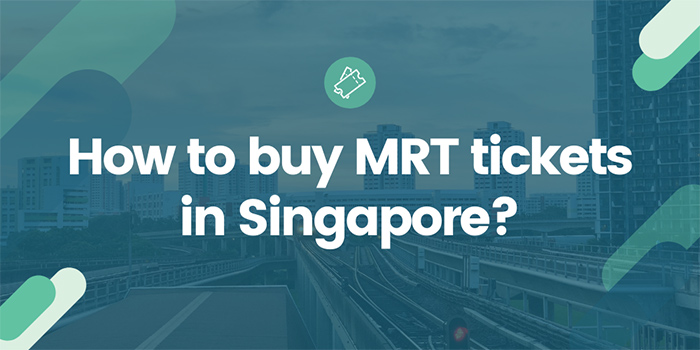
It is important to know how to buy MRT tickets in Singapore and this is true regardless of whether you are visiting the city only for a few days or you are a permanent resident. Unlike most cities around the world, Singapore has managed to create a world-class public transportation system that allows passengers to get to the most important areas of the city without spending any time in traffic jams.
Once you have found the best hotel deals and booked the cheapest room in Singapore, the next step is to purchase an attraction pass that enables you to save money by visiting multiple places for a large discount.
Then, you must be able to get to all these attractions as efficiently as possible.
Since the MRT system is so efficient and economical, we have written the step-by-step guide on how to buy tickets for the MRT to make sure that you can utilize this form of public transportation. The information presented below is based on her own extensive travel experience throughout Singapore. Over the last 10 years, we have visited all of the major attractions in Singapore and we are confident that this information can help you to navigate the system more affordable and more efficiently.
Why should you use the MRT in Singapore?
There are many benefits to buying MRT tickets in Singapore and using the system as much as possible. First of all, the MRT in Singapore is extremely affordable for most people living and visiting the city. Singapore is known to be one of the most expensive countries in Southeast Asia for tourism purposes and for people to live permanently. Consequently, the MRT provides an affordable option for public transportation that is both fast and stress-free.
The other benefit of using Singapore’s MRT network is the fact that you will not have to deal with road traffic throughout your time in the city. During peak hours for vehicles, traffic can get jammed up and this is just an unnecessary headache because you do have a lot of buses and trains in Singapore that bypass this.
Other Benefits
Another clear benefit of using the MRT in Singapore is that it is more environmentally friendly. The last thing that we want to see is one person in a vehicle driving around the city. This creates unnecessary traffic jams and exhaust fumes that are detrimental to the environment.
Singapore is done in the amazing job of strategically placing MRT Lines and stations throughout the city. Therefore, you can access 90% of the major attractions by using MRT. After you get out from a station you only usually have to walk three or four hundred meters to get to your intended point of interest.
When you buy a ticket for Singapore’s MRT system keep in mind that not everyone will pay the same amount. Students, senior citizens, students, and disabled individuals per less than adults.
Many of Singapore’s MRT stations have been built right beside hotels throughout the city. The smart thing to do is to stay at hotels such as Marina Bay Sands or Raffles Singapore and be within 2 minutes of the station. Again, this promotes more efficient sightseeing and less time in Singapore’s scorching heat during the afternoon hours.
Buying MRT Tickets in Singapore – Types of Tickets and Passes
The first thing that you have to understand about buying MRT tickets in Singapore is that there are a few different options. Technically, there are two different types of MRT tickets or passes that can be used:
1) Stored Value Cards
2) Singapore Tourist Passes
In the following section, we will provide an overview of each one of these tickets including the pros and cons of each one. This should help you to identify what type of ticket is best suited for your individual circumstances while you are in Singapore.
Single Trip Tickets in Singapore – No Longer Available
As their name suggests, single-trip MRT tickets were purchasable directly from a ticketing machine within one of the stations. These are often called ‘standard tickets’ within stations. These are no longer available post-Covid. There were some pros and cons associated with these single-trip tickets, but now you can purchase cards that are valid for buses and trains.
1. Buying Stored Value Cards for MRT in Singapore
Stored value cards are the most popular option for Singaporeans and permanent residents using the MRT in the city. They are often called ‘Adult Stored Value Cards’ . These are contactless stored value smartcards which can be used on buses, the MRT and LRT throughout Singapore. Therefore, their use is not restricted to only the train system in Singapore. They can be used on buses as well which is a major bonus.
There are some clear pros and cons of using Stored Value Cards while you are in Singapore.
There are many clear benefits of using a stored-value card in Singapore. Once you have topped them up with cash, they naturally save a lot of time at each station. Unlike the single trip tickets, stored-value cards only have to be topped each time that you want to enter the MRT Network in Singapore. This eliminates the need for you to wait in line at a ticketing machine every time you want to use the MRT.
The cost per trip is also cheaper than using single journey tickets. Therefore, this is the ideal card if you are staying in Singapore for a long period of time. If your stored-value card is damaged or not working properly you can easily go to a TransitLink Ticket Office to get a replacement.
If for some reason you do not want to use your stored value card anymore you can return it for a refund as well. Again, in this case, you have to go to a TransitLink ticketing office to get your money back. Keep in mind that the $5 card cost paid during the purchase of the card is non-refundable.
There are actually very few ‘cons’ about using a stored-value card in Singapore. The major one that you have to really think about is how long you are staying in Singapore? If you are only staying in the city for a few days then a Singapore tourist pass is by far your best option if you want to use the MRT extensively. While planning, you might realize that you are only going to use the MRT once or twice during your entire trip. In this case, you are best to use single journey tickets instead of getting any type of card.
Stored value cards do require an upfront payment. Consequently, if you do not use the card extensively you will lose $5 in cash because of the down payment that you had to make when you originally purchased the card.
How much do stored value cards cost in Singapore?
The time of writing adult stored value cards cost $12. This total value of $12 dollars includes a $5 non-refundable card cost and a $7 travel value balance. The $7 dollar balance can be used for rides on LRT, MRT and trains throughout Singapore.
According to the information above, you can see why you don’t want to purchase a stored value card unless you plan on using Singapore MRT for an extended period of time. You will waste the $5 non-refundable payment and maybe some of the $7 cash balance if you only use it once or twice.
COST-SAVING TIP: If you want to save up to 52% on attractions in Singapore, book a multiple attraction pass online in advance . So far, over 200,000 Singaporeans and visitors to the city have purchased these to use alongside their transportation card for the city.
What kinds of stored value cards can you purchase for the MRT?
There are currently two types of adult stored value cards available for purchase in Singapore:
1) Adult ez-link card and….
2) NETS FlashPay
You can find out additional information about each card using their respective websites:
Adult ez-link card, you may log on to ez-Link website www.ezlink.com.sg .
NETS FlashPay, you may log on to the NETS website www.nets.com.sg .
Where can you buy MRT cards in Singapore?
You can purchase stored value cards at any TransitLink Ticket Office. You can refer to the official TransitLink website that summarizes all of the relevant offices and what their daily hours are.
Once your card is purchased, the minimum amount that you can top-up is $10 and the maximum is $500. Aside from TransitLink Ticket Offices, you can also use General Ticketing Machines (GTMs). These are located in MRT stations and bus interchanges to top-up your smartcards by cash or NETS. Add Value Machines (AVM + ) can also be used for top-up purposes.
2. Buying Singapore Tourist Passes for the MRT in Singapore
The third option for buying MRT tickets in Singapore is getting a Singapore Tourist Pass. As the name suggests, Singapore Tourist Passes are designed for temporary visitors to the city. They are not designed for permanent residents or Singaporeans that spend considerable amounts of time in Singapore. There are clear pros and cons to purchasing a Singapore tourist pass that we will outline below.
One of the clear benefits of purchasing a Singapore Tourist Pass is that you know exactly how much it is going to cost you per day for your transportation. This is especially important if you are trying to create a budget for your trip. As most people know, Singapore is not considered to be a very cheap place to travel. Therefore, a lot of budget travellers and backpackers are always looking for ways that they can save more money while they are in Singapore .
If you are an active traveller and plan on using public transportation extensively while you are in the city, the Singapore Tourist Pass is the best MRT option for you. Singapore has an extensive selection of things to do and see. So you might want to maximize the number of trips you can take with the card. If you plan on staying in Singapore for three days or less and want to sightsee a lot, this is the best option for you!
Singapore tourist passes are ideal for active visitors to the city. However, they are not the best option if you are staying in Singapore for an extended period. Similarly, they are not the best option if you are not seeing a lot of different sights. If you pay upfront for a Tourist Pass and then do not actively use the card you are just going to throw your money away. Therefore, you need to really think about your itinerary and how much public transportation you are going to require while you are in the city.
Where can you buy Singapore Tourist Passes?
Similar to stored-value cards, you can buy Singapore Tourist Passes at selected TransitLink Ticket Offices or Automated STP Kiosks. You can refer to the official TransitLink website that summarizes all of the relevant offices and what their daily hours are. Keep in mind that there is an office in Changi Airport, so it is possible to purchase a card after you land, but before you travel from Changi into the city center!
Currently, there are four different types of Singapore tourist passes that are available to visitors in the city. Some of the cards are valid for one day where the others are valid up to 3 days. You also have some choice in terms of what type of card you want to get and the perks and discounts associated with each one.
You can refer to the official Singapore Tourist Pass website if you want more information about buying Singapore Tourist Passes.
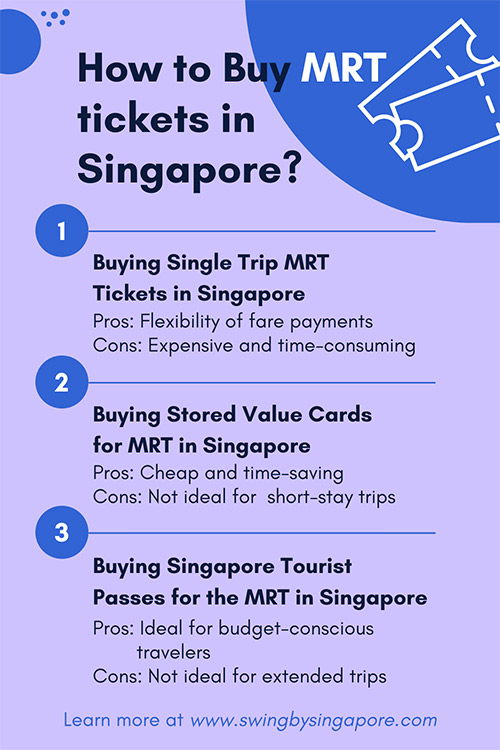
Any more questions about buying MRT tickets in Singapore
This article has summarized how to buy MRT tickets in Singapore. As you now know there are some important considerations that you have to make. Before you buy either a single trip ticket, stored value card or a Singapore Tourist Pass. In general, single journey tickets are the best option if you do not want any pressure to use the MRT extensively. In other words, if you only plan on using the MRT once or twice during your trip. You might not want to spend time purchasing a card and then worrying about refunds afterwards.
Ideally, you want to book a hotel room in Singapore right beside an MRT station . This will ensure that your Tourist Pass or Stored-Value Card is used frequently during your stay. Try to stay less than 500 meters from a station if possible!
For most ‘active’ tourists to the city, the Singapore Tourist Pass is the best option. We use the term ‘active’ here because it is not the best option if you do not plan on using the MRT and bus network extensively in the city. You have to make many trips per day to make it worthwhile to get the Singapore tourist pass. We recommend that you plan out an itinerary and sort of calculate how many trips you think you were going to take and whether it’s worthwhile even getting this card in the first place. However, if you are sightseeing a lot this can save you a lot of money. It can be an excellent decision to buy one.
Leave a Comment Cancel Reply
Your email address will not be published. Required fields are marked *
Save my name, email, and website in this browser for the next time I comment.
Privacy Overview

- Animal Attractions
- Area - Bedok
- Area - Changi
- Area - Chinatown
- Area - City & Downtown
- Area - Jurong
- Area - Kallang
- Area - Marina Bay
- Area - Orchard Road
- Area - Pasir Ris
- Area - Punggol
- Area - Sentosa Island
- Area - Tampines
- Galleries & Museums
- Gardens & Parks
- Theme Parks & Water Parks

Marina Bay Sands

Gardens By The Bay

Universal Studios Singapore

Singapore Zoo

Singapore Flyer

Singapore Night Safari

ArtScience Museum

Resorts World Sentosa

National Gallery Singapore

Singapore Botanic Gardens
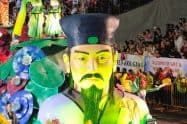
Chingay Parade
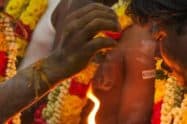
River Hongbao

Chinese New Year

Singapore Art Week

M1 Singapore Fringe Festival

Pongal Harvest Festival

Singapore Motorshow
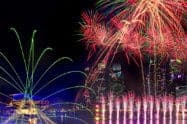
Marina Bay Singapore Countdown
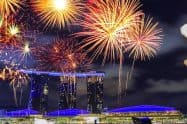
New Years Eve

Singapore Marathon
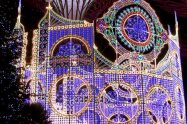
Christmas Wonderland
- Boutique Hotels
- Luxury Hotels
- Cheap Hotels
- Clarke Quay
- Jalan Besar
Kampong Glam
- Little India
- Robertson Quay
- Sentosa Island
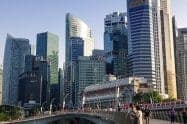
Tiong Bahru
- Food & Nightlife
- Markets & Hawker Centres
- Sports Venues

Holiday Packages

Singapore Sports Hub

Marina Bay Sands Skypark

Theatres on the Bay

Sentosa Cable Car

Shoppes at Marina Bay Sands

Marina Bay Sands Casino

Leong San See Temple

Buddha Tooth Relic Temple and Museum
- General Enquiries
- Advertising Enquiries
- Add Your Business
- Add Your Event

Singapore MRT
Singapore is popularly known as the Garden City of Southeast Asia which, due to its size, is easy to navigate and only takes a short time to get from North to South, or East to West.
Aside from taxis, the most common mode of transportation in Singapore is the MRT , also known as the “Mass Rapid Transit” system.
Singapore MRT, Ticket Prices & Fares, Maps & Routes
All trains are air-conditioned and are well maintained. The North-East line operated by SBS is also an automated underground rail system which operates from Punggol to Harbourfront . Aside from being one of the most modern MRT systems in the world, the advanced features of the trains make them some of the safest in the world.
One of the unique features also of the Singapore MRT system is the use of destination numbers instead of usual line numbers. The train lines are also distinguished by colour: The Green Line travels east/west, the Red Line travels north/south. Like most train operators, a contactless smartcard required for each passenger which is scanned when entering or exiting the station.
Although fare prices vary depending on the boarding and alighting stations, you can store money on these cards in order to take multiple journeys over your extended stay. A single trip for an adult start from $1.40 and can be purchased from ticket machines at the stations. Usually, the train operation starts daily at 5.30am and runs until midnight with peak hours between 7am to 9am.
Announcements are made in English as is all signage. To get to and from Changi Airport , you can take the East/West (green) line. Simply follow the signs from the arrivals hall to the MRT. You can purchase a one-way ticket with cash or credit for about $1.40 each way. Take the train and get off at the second stop ‘Tanah Merah’, you need to interchange here and it is extremely simple as the ongoing train is just across the platform. The train will continue on the green line heading towards the city. If you need to get on a Purple Line, you can change at Bugis . If you need to get on a Red Line, change at City Hall . A one-way train trip from City Hall to Changi Airport only takes around 15 minutes.
Singapore MRT Images & Photos
Singapore mrt area, street & hotel map, singapore, other places we recommend.
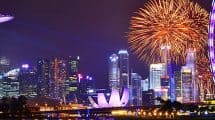
7 Underrated Spots in Singapore To Go on Your Next Visit
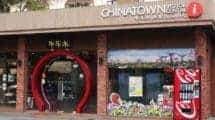
Chinatown Visitor Centre
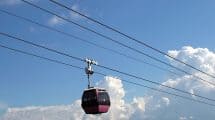
Getting to Sentosa Island
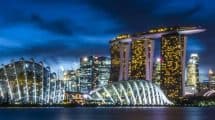
5 Things About Singapore Every Traveller Should Know
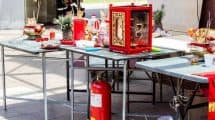
5 things not to do during the Singaporean Hungry Ghost Festival
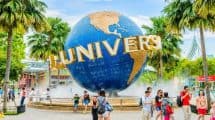
The Best Family Tourist Attractions Around Singapore
13 comments, cancel reply.
Please Enter Your Question Below
Your Name *
Your Email *
Is there a map which shows where MRT is overground & underground? One of our party doesn’t like tube trains.
I have searched online for a map that illustrates this, but unfortunately, there doesn’t appear to be anything that strays away from the standard map.
Based on other people’s feedback, they state that “all stations and tracks within Orchard, Marina and the Central Business District area are underground”. So it’s to say that if you are within the popular business direct area, the train station will be underground.
Thanks Michael
Where is the nearest MRT station to suntec city
Although Esplanade and Promenade on the Circle Line look to be equal distance from Suntec City, i would recommend using Promenade as the walk will be much quicker.
Getting off at Esplanade would require you to wait for the lights or use the overpass in order to get over Nicoll Hwy.
But it all depends really from what direction you are coming from. That is, any time spent going the extra station might negate the time saved.
Thanks Michael. Btw what kinda distance are we talking about. I’ll be taking the MRT from changi with 2 large bags so I think you get my predicament right. Regards
What is the MRT fare for going to city hall from Beauty world?
You can use the fare calculator here to work out how much it costs to travel on the Singapore MRT. The standard fare will be S$2.20.
Best regards, Jess
Hi. What time is the last MRT? Planning for the new year fireworks at Gardens by the bay
You don’t mention which line you wish to travel on, however the MRT is extended for NYE celebrations with the last MRT’s generally running between 1am – 2.30, depending on which line you require.
Best to check with the SMRT site directly. Insert the station and it will give you the last MRT time.
We will be staying eight days over the Christmas period, are the MRT trains running as normal.
Yes, the MRT runs as normal. In fact, extra services are typically offered over the busy NYE period.
Is there a MRT ticket card for senior citizens like it is in Hongkong?
There are seniors tickets, but only for permanent residents and citizens only, who will have a concession EZlink card.
Regards, Jess
Weather Forecast
Upcoming events, disney on ice, hari raya aidilfitri, 2xu compression run, singapore rugby sevens, ocbc cycle singapore, singapore international festival of arts, i light singapore, sundown marathon, dragon boat festival.

Latest News MRT 3 Philippines
The truth about mrt3.
- MAINTENANCE
MRT3 FAREGUIDE
LEAVING FROM
SINGLE JOURNEY TICKET
Types of tickets:.
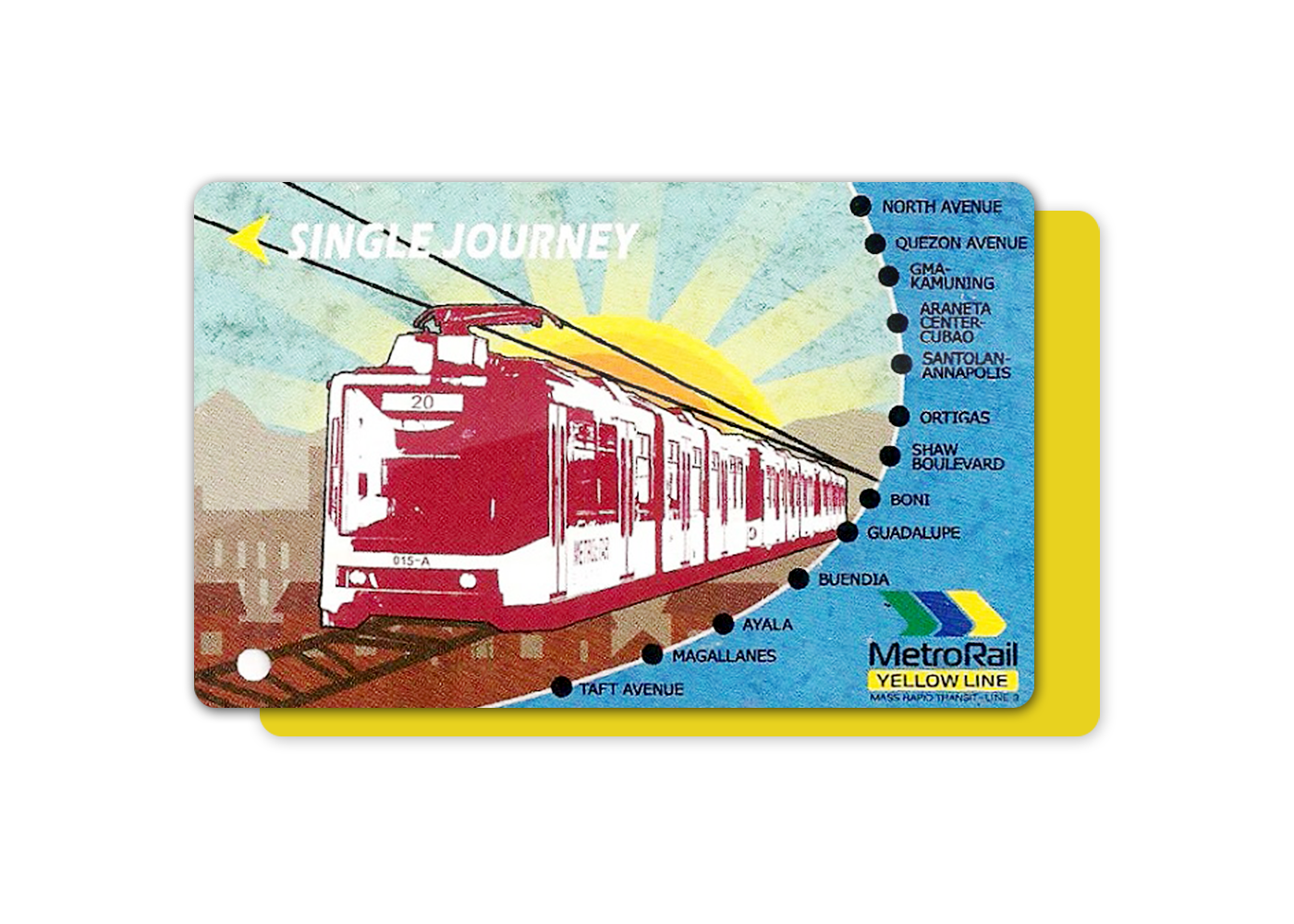
Single Ride Ticket. Valid only on the date of purchase (P13.00-P28.00)
SINGLE JOURNEY DISCOUNT
Single Ride Ticket. Valid only on the date of purchase. P13.00-P28.00 with 20% discount for Senior Citizens and PWDs
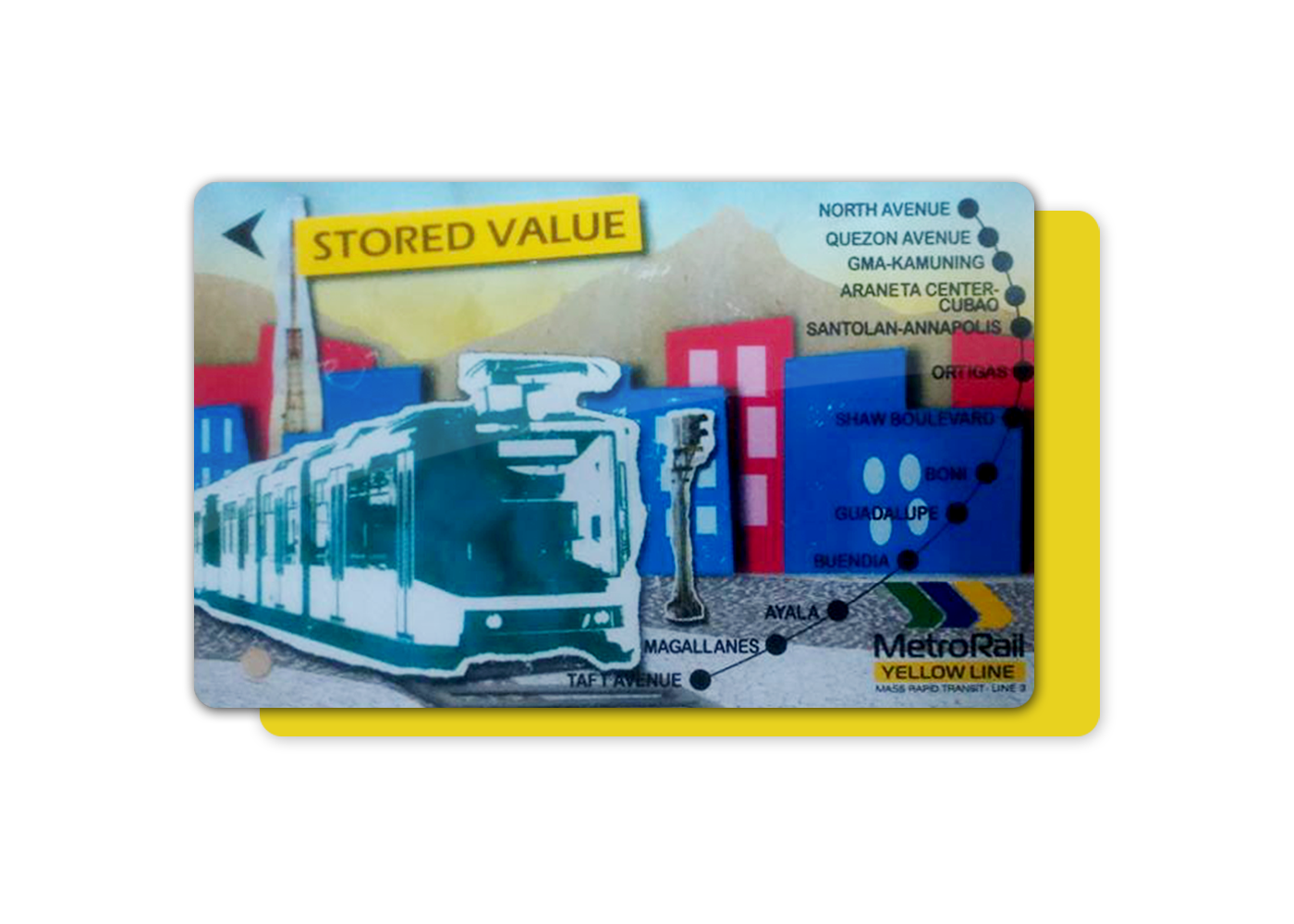
STORED VALUE TICKET
Multiple Ride Ticket. Valid for 3 months from the date of purchase. P100.00 with last ride bonus
STORED VALUE TICKET DISCOUNT
Multiple Ride Ticket. Valid for 3 months from the date of purchase. P100.00 with 20% discount for Senior Citizens and PWDs with last ride bonus

[email protected]


Metro system in MOSCOW – Basic information
The Moscow metro system is one of the busiest and most magnificent in the world. It is estimated that over 8 million people use the metro on a daily basis, and it is comprised of more than 200 stations spread across 12 separate lines . The first station opened in 1935 , and ever since then, the network has been expanding. Each stop has its own distinct personality and is exquisitely designed, with many showcasing art and sculptures. The metro is an excellent and time-saving method of transportation for getting through Moscow and the surrounding areas.
The lines of the Moscow subway system
The Metropolitan Subway, more commonly referred to simply as the Metro, is the primary mode of public transportation in the Russian capital of Moscow. It is one of the busiest and most efficient metro systems in the world, with over 7 million people utilizing it on a daily basis, making it one of the busiest metro systems in the world. It is comprised of 12 lines, each of which has its own distinctive route, and it provides service to the entirety of Moscow as well as the suburbs that surround it.
The Koltsevaya Line and the Radial Line are the two primary lines that make up the Metro. The Koltsevaya Line is a circular line, and the Radial Line extends from the center of Moscow to the outskirts of the city. Because it links all of the major stations in the city, the Koltsevaya Line is by far the most traveled line in the city. It provides service to a total of 15 stations, several of which are among the most well-known in the city. These stations include Komsomolskaya and Belorusskaya.
The Radial Line is the Metro’s longest line , clocking in at more than 30 kilometers in total distance. It provides service to a total of thirty stations, two of which are particularly well-known: Kievskaya and Kurskaya. It is the primary route that commuters take, as it links the central business district to the surrounding suburbs.
Two of the other lines that the Metropolitan Subway serves are the Zamoskvoretskaya Line and the Arbatsko-Pokrovskaya Line . The Zamoskvoretskaya Line travels all the way from the city center to the southwest suburbs of Moscow, and it stops at a total of 14 stations along the way. It is well-known for its architecture, which is a fusion of Art Deco and Socialist Realist styles. This style of architecture has earned it a lot of attention. The Arbatsko-Pokrovskaya Line travels all the way from the city center to the northeastern suburbs of Moscow, and it stops at a total of 12 stations along the way.
The Moscow Metro is widely recognized as one of the most well-designed and effective methods of public transportation in the world. It is an essential part of life in Moscow, as it provides service to the entirety of the city as well as its environs. It is one of the world’s busiest metro systems, with over 7 million people using it on a daily basis , making it one of the busiest in the world.
Map of Moscow Metro 2023 – Free Download in PDF
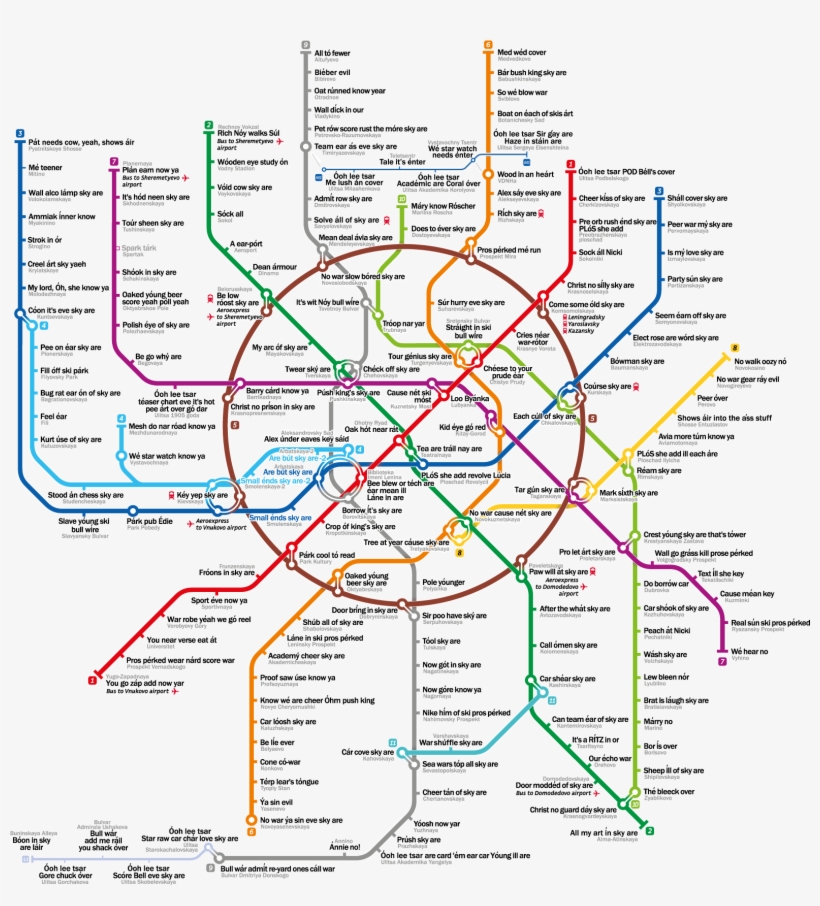
The Map of Moscow Metro 2023 is a free download in PDF format. This map has been designed with the latest in artificial intelligence technology to provide the most accurate and up-to-date information on the Moscow Metro system. With this map, you can easily navigate your way around the city and get to your destination quickly and safely. The map includes all of the stations, lines, and connections in the metro, as well as a detailed description of all the features and services each station provides. Downloading this map is a great way to make the most of your travels in Moscow.
Public transport tickets in Moscow – Best types for travelers & actual prices
In Moscow, the system of public transit is an essential component of daily life. It should come as no surprise that the city’s public transit system is enormous and complicated given that the population of the city is over 12 million. This article will provide information about the many types of tickets that are offered, as well as their costs and where they can be purchased, in order to assist make it easier for readers to navigate the website.
In Moscow, passengers who use the city’s public transit can choose from a number of different ticket options. The Troika card , which is a contactless smart card, is the most prevalent type. The card allows passengers to load money onto it, which may then be used to pay for travel on public transportation systems, including buses, trams, trolleybuses, and the metro.
Classic tickets
One such variety of tickets is known as a Single Ride ticket , and it permits the holder to take a single trip on any sort of public transit. A single-ride ticket can be bought at a number of places, such as metro stations, kiosks, and other sales points. There is also the option to purchase a ticket that is valid for up to ninety minutes of travel on any sort of public transportation and costs ninety dollars. You can also buy this ticket at a lot of kiosks, metro stations, and other places.
Tickets for tourists
In addition to the ordinary tickets, there are also special tickets available for purchase in Moscow that are tailored specifically to the needs of tourists. These tickets include 24-hour, 72-hour, and 7-day passes , all of which may be purchased at metro stations, kiosks, and other shops throughout the city.
The cost of tickets varies widely depending on the kind of ticket that is purchased. For instance, the price of a ticket for a single ride is 45 rubles, while the price of a 24-hour pass is 250 rubles . Pricing could shift marginally from one retail location to another.
You can buy tickets for Moscow’s public transportation at metro stations, kiosks, and other places all over the city. At these retail locations, we’re sorry to say that we can’t accept credit or debit cards as payment. The sole form of payment accepted is cash.
Timetables & Schedules of THE Moscow Metro system
Moscow’s metro is both very popular and very good at getting people where they need to go. This makes it one of the busiest and most advanced public transportation systems in the world. It is open on all seven days of the week and operates from approximately 5:30 am to 1:00 am. The Metro run s on a regular schedule, with service happening anywhere from once every three minutes to once every ten minutes, depending on what time of day it is. The Metropolitan Area Transit Authority, or Metro, makes getting around the city easy and reliable. In addition to this, the price is relatively reasonable, which makes it an appealing alternative for travelers as well as people living in the area.
What Are Other Options For Public Transportation In Moscow?
Public transportation is a big part of life in Moscow, and most commuters take the metro as their main way to get around. There are, however, a great many other transportation choices available to people who would rather not take the subway. Here are some of the other ways to get around Moscow by public transportation: electric trams, buses, trains, and boats.
Buses : Buses are an excellent mode of transportation for moving around Moscow, as there are routes that connect all of the city’s neighborhoods. There are city buses and suburban buses, and the prices for riding each type of bus are varied. The fare for a city bus is normally approximately 40 rubles , whereas the fare for a suburban bus might be as high as 70 rubles .
Trams: Electric trams are a terrific method to go about Moscow, and they are sometimes times faster than buses. There are a lot of trams in Moscow. The city is serviced by a number of different tram lines, and the fare for each ride is approximately 30 rubles .
Minibuses: Minibuses, often known as marshrutkas, are a typical kind of public transportation in Moscow. They operate along predetermined routes, have fares that are comparable to those of buses and trams, but they also make stops at various points along the way. Minibus rides normally cost between 50 and 70 rubles per passenger , depending on the distance traveled.
Trains: Several different train lines may be found operating in and around the city. Because they do not stop as frequently as the metro, these trains offer a fantastic opportunity to go across the city in a hurry. Costs can range anywhere from 40 to 60 rubles (depending on the location), but they are normally in that range.
Taxis : Despite the fact that using a cab is an easy and handy choice, the cost can sometimes be rather high. Depending on where you want to go, the cost of a ride might range anywhere from two hundred to five hundred rubles. It is essential to keep in mind that in order to ensure your safety, taxi rides should only be reserved through a reputable firm that possesses a valid license.
Boats: If you want to see Moscow from the water, renting a boat is a fantastic option. There is a wide variety of options for boat tours and cruises that may be taken, with prices ranging anywhere from 500 to 1000 rubles per person. It is also possible to rent boats hourly, with pricing starting somewhere around 1000 rubles.
These are just some of the different ways to get around Moscow by public transportation. Everyone can choose a mode of transportation that suits their needs, whether they prefer boats, buses, trams, minibuses, trains, or taxis. Because there are so many possibilities, you should have no trouble locating the mode of transportation that best suits your needs.
How To Get From Sheremetyevo International Airport (SVO) To The City Center With Public Transport?
If you are thinking about going to Moscow, there is a good possibility that you will fly into Sheremetyevo International Airport when you get there. The journey from the airport to the heart of the city may present some difficulties, but if you are well-prepared, you should have no trouble reaching your destination. Using public transit is the easiest and most time-efficient way to go from Sheremetyevo Airport to the central business district of Moscow. Public buses, shuttle buses, and even a high-speed train called the Aeroexpress to provide excellent connections to the city from the airport.
The Aeroexpress is the most expedient method of transportation between the airport and the city. Belorussky Rail Terminal is the destination after leaving Terminals D, E, and F of the airport in order to go there. You will have no trouble navigating the city’s subway system from there and arriving at your destination. The Aeroexpress takes about 35 minutes to get to the Belorussky Rail Station. You can buy tickets online or at one of the many kiosks in the airport.
There are a number of buses that may take you to your destination, and you can catch one of them in Terminal E of the airport. The metro station Rechnoy Vokzal can be reached by taking the 851 bus , while the metro station Planernaya can be reached by taking the 817 or the 851 express bus. In addition, bus number 817 makes stops at the Rechnoy Vokzal metro station, and bus number 851 makes stops at the Belorussky Rail Terminal. The travel time for each of these buses is around one hour to reach their final destinations.
Shuttle buses are another alternative that can get you to your destination quickly and affordably, and they leave from each of the airport’s three terminals. Shuttles operate around the city, making stops at a variety of locations, including the Rechnoy Vokzal and Planernaya metro stations. You can purchase tickets for the shuttles either at one of the ticket booths located throughout the airport or directly from the driver. It may take more or shorter than an hour and a half to reach the city center using the shuttles, depending on the amount of traffic that is present along the route.
If you know how to use the different ways to get around, it is not only easy to get from Sheremetyevo Airport to the central business district of Moscow, but it is also very convenient. The Aeroexpress is the most time-efficient choice while taking the buses or shuttles is the most cost-effective way to reach the city from the airport. No matter which course of action you decide to take, getting to where you need to go won’t be a problem for you.
The most convenient way is Bolt! Bolt (European UBER) is a convenient way to get from Ruzyne Airport to the city center. The journey takes around 25 minutes depending on traffic, and the cost is approximately 2.000 Kč. It’s recommended to book a taxi in advance to avoid the queues, or you can pick one up at the taxi stand at the airport.
- Free coupon for a first Bolt ride – 20 EUR
What kind of sightseeing do you have to see if you visit Moscow for the first time?
Moscow, the capital of Russia, is a city filled with amazing attractions that are sure to captivate even the most seasoned traveler. From its iconic Red Square, to its world-famous Kremlin, Moscow is an incredibly popular destination for tourists from all over the world. Here are some of the top attractions to visit when you’re in the city.
- The Red Square is perhaps the most iconic image of Moscow, and this vast city square has become an essential part of the city’s history, culture, and identity. It is the site of many events, such as military parades, concerts, and other official ceremonies. The Red Square is also home to some of the city’s most famous landmarks, including the Kremlin, the State Historical Museum, and the famous GUM shopping center.
- No visit to Moscow is complete without a visit to the Kremlin , the fortified complex that houses the official residence of the President of Russia. The Grand Kremlin Palace, located inside the Kremlin, is a magnificent baroque-style building that was once used as the official residence of Tsars. Visitors to the Kremlin can also explore the Cathedral of the Assumption, the Annunciation Cathedral, and Ivan the Great Bell Tower.
- The State Historical Museum is another must-see attraction in Moscow. Located in Red Square, this museum is one of the oldest in the world, and it houses a vast collection of artifacts, artwork, and other items that document Russian history and culture. The museum has many famous artifacts, including the Siberian Mammoth and the world’s oldest book.
- The iconic GUM shopping center is another popular attraction in Moscow . This grand building is located in Red Square and is one of the city’s most popular shopping destinations. GUM is home to more than 200 stores, many offering luxury fashion items, designer goods, and other products.
Moscow is home to many other attractions, including the Saint Basil’s Cathedra l, the Bolshoi Theatre , the Pushkin Museum of Fine Arts, and the Moscow Metro . Visitors can also explore the many parks and gardens throughout the city, such as Gorky Park and Alexander Garden. Whether you’re looking for a cultural experience or some relaxation, Moscow has something for everyone.
Summary of our tour guide for Moscow
The city of Moscow has a population of about 12 million people, making it a lively and active metropolis. Moscow is the most populated city in Europe and the capital of Russia; as such, it is also a center of culture, artistic production, and commercial activity. The Moscow Metro is by far the most common and widely used mode of public transportation, despite the city’s enormous and well-functioning public transportation network. The Moscow Metro is a must-see sight both because of its distinctive and ornate architecture and because it provides an expedient method to move between the many sites that are located in Moscow. The city has a diverse selection of public transportation choices, such as buses, trams, trolleybuses, and even riverboats, so residents may easily navigate the area.
Top 5 FAQs and answers about Moscow public transport?
Getting around Moscow can be a bit confusing, especially if you are unfamiliar with the city’s public transport system. With so many options to choose from, it can be difficult to know which one is the best for you. Here are the answers to five frequently asked questions about Moscow public transport. 1. What types of transportation are available in Moscow?
- The Moscow public transport system includes buses, trams, trolleybuses, metro, suburban railways, and taxis. The Moscow Metro is the most popular and convenient way of getting around the city, with over 200 stations and 13 lines covering most of the city. Buses and trams are also popular, and they have the advantage of being able to go to places that are not covered by the Metro. Suburban railways and trolleybuses are also available, though they may be less convenient. Taxis are also a good option, though they can be quite expensive.
2. How much does it cost to use public transport in Moscow?
- The cost of using public transport in Moscow varies depending on the type of transport you are using. Single tickets for the Metro cost 55 rubles, and for buses and trams, it is 28 rubles. If you plan on using public transport multiple times, you can buy a card with a set amount of money loaded onto it. This card can be used for multiple rides on the Metro, buses, trams, and trolleybuses.
3. How do I pay for public transport in Moscow?
- You can pay for public transport in Moscow with cash or a bank card. If you are using the Metro, you can also purchase a Troika card, which is a reusable card that can be loaded with money. This card can be used on the Metro as well as on buses, trams, and trolleybuses.
4. Is there a way to get around Moscow without using public transport?
- Yes, there are several ways to get around Moscow without using public transport. Most people choose to walk because most of the city is flat and easy to get around on foot. You can also rent a bike or scooter if you want to get around faster. There are also a few companies that offer car-sharing services, which can be a convenient and affordable way to get around.
5. Is there a website or app I can use to plan my trips?
- Yes, there are several websites and apps that you can use to plan your trips in Moscow. Yandex.Taxi is a popular app that allows you to book a taxi or car-sharing service, and Yandex.Metro is a website and app that can help you plan trips using the Metro. You can also use Google Maps to plan trips using public transport, as well as to find the best routes to take.
Useful links
- Official website of public Moscow transport company
Leave a Comment Cancel reply
Save my name, email, and website in this browser for the next time I comment.
most recent

Asia , Japan
Hiroshima rapid transit line (astram line) – tourist guide.

Asia , China
Ürümqi metro: practical tips for tourists.

Nagoya Municipal Subway

Yokohama Municipal Subway – Tour guide

Kyoto Municipal Subway

Sapporo Municipal Subway
PH +420 607 777 83
Na Folimance 2155/15 Prague, 120 00
© info 2024
The Straits Times
- International
- Print Edition
- news with benefits
- SPH Rewards
- STClassifieds
- Berita Harian
- Hardwarezone
- Shin Min Daily News
- Tamil Murasu
- The Business Times
- The New Paper
- Lianhe Zaobao
- Advertise with us
Sale of standard tickets at MRT stations to end by March 2022
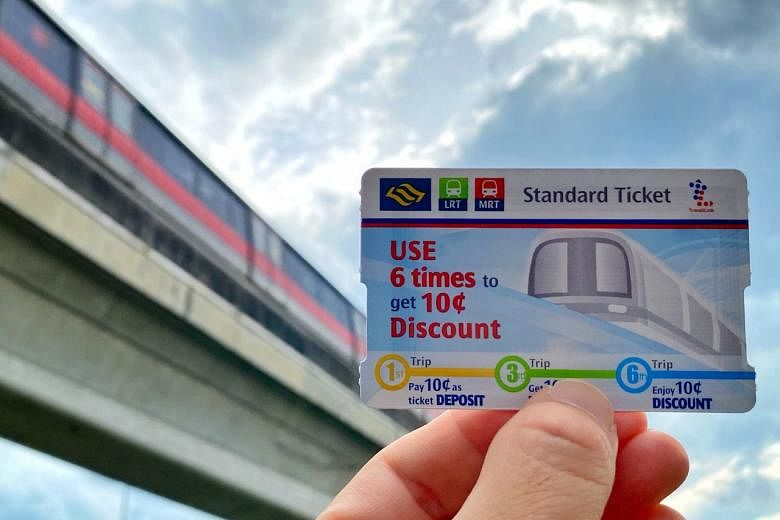
SINGAPORE - Sale of standard tickets - limited use paper tickets - at MRT stations will be progressively phased out between January and March 2022.
This comes as most commuters are already using stored value cards or account-based ticketing such as contactless bank cards.
Standard tickets were introduced to allow commuters to pay for their ride when the MRT system began operations in 1987, but now fewer than one in 1,000 trips are paid using these tickets, according to the Land Transport Authority (LTA) in August.
The LTA said on Friday (Dec 3) that the move will start with the Thomson-East Coast and Downtown lines from Jan 10.
This will be followed by the Circle and North East lines on Feb 10, and the North-South and East-West lines on March 10.
The LTA has also reduced the minimum top-up amount for stored value cards such as ez-link cards at ticketing machines to $2, down from $10 for adults and $5 for student concession cards.
"This will allow commuters who have limited cash on hand to top up, continue their journeys and enjoy the cost savings," said the LTA.
The move to phase out standard tickets - purchased for single or return trips - because of low usage was announced earlier in August.
The LTA said stored value cards and account-based ticketing options offer commuters more savings and convenience.
For example, a 3.2km trip costs $1.70 when using standard tickets, compared to $0.92 with stored value cards or account-based ticketing.
In preparation for the phasing out of standard tickets, the LTA conducted pilots earlier this year at some MRT stations, where the sale was temporarily halted.
Responding to queries from The Straits Times, an LTA spokesman said the sale of standard tickets at general ticketing machines at Farrer Park and Lavender MRT stations was temporarily suspended for a day on Aug 31, and at all stations on the Thomson-East Coast Line for a week starting on Nov 15.
This was to enable the rail operators, LTA and TransitLink to refine standard operating procedures for the actual phase out, and gather information on commuters' standard ticket use, she said.
"Through these trials, we found that those who were still using standard tickets generally had access to alternative payment modes such as contactless bank cards, mobile wallets and ez-link cards," the LTA noted.
Following the announcement in August, it has been working with partners to contact seniors, lower-income groups and migrant workers to encourage them to switch to stored value cards or account-based payment.
Since September, letters have been sent to ComCare recipients who do not own a concession card to inform them that they are eligible for a free adult ez-link card.
These free cards can be redeemed at any of the 48 Transit Link ticket offices or concession card replacement offices within three months from the date of the letter.
"To assist commuters as standard tickets are phased out, service ambassadors will be deployed at selected train stations over January to March 2022," the LTA said.
Do you purchase a standard ticket for your train fare because you… 💳 Forgot to bring your stored value card? 💵 Do not... Posted by Land Transport Authority – We Keep Your World Moving on Thursday, December 2, 2021
Associate Professor Walter Theseira of the Singapore University of Social Sciences said that it is ultimately a matter of balancing cost concerns.
"Of course, we should be concerned about the small number of passengers who simply can't use any of the other ticketing systems. But putting in the effort to help them individually might be less difficult and costly than maintaining the entire standard ticketing system," he said.
"It's worth noting that it is common worldwide for public transport payment systems to not accept cash on board and to require payment through only limited types of tickets. Offering more payment options comes at a cost."
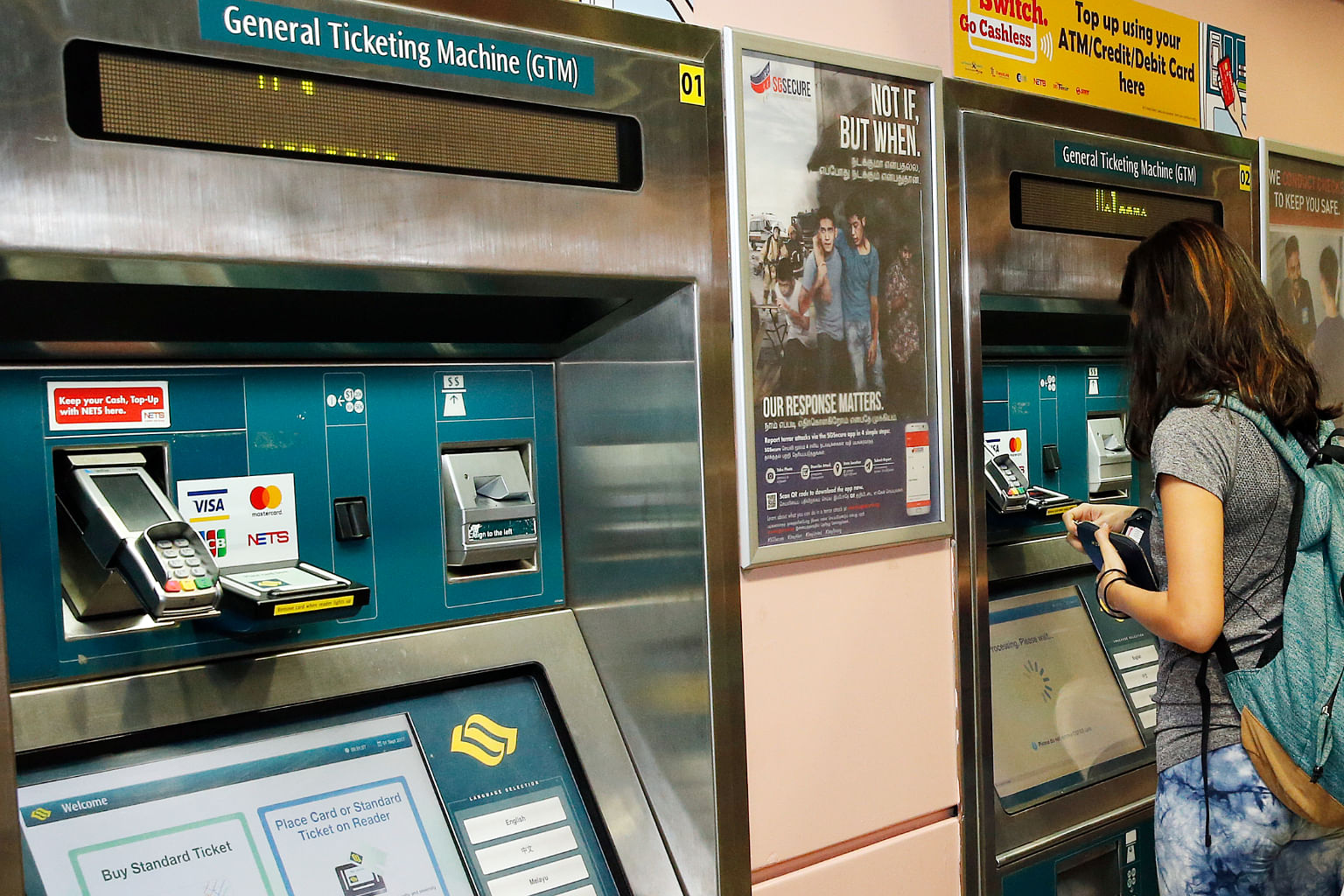
Mr Ian Tay, founder of transport hobby group Bus and Rail Enthusiasts, said those affected by the scrapping of paper rail tickets are likely to be people who make limited public transport trips. He added that the lower ez-link card top-up fee makes it easier for those reluctant to use the cards because of cost.
The 25-year-old finance professional, who reads up on the latest rail developments here in his free time, said he has personally never used a standard ticket, adding that payment using an ez-link card is more convenient.
Responding to queries on what options tourist have once single-use tickets are scrapped, LTA said visitors to Singapore can use their existing contactless Visa or Mastercard bank cards or mobile wallets.
Alternatively, they can choose to purchase a stored value card or Singapore Tourist Pass, which are available for sale at TransitLink ticket offices islandwide.
Join ST's WhatsApp Channel and get the latest news and must-reads.
Read 3 articles and stand to win rewards
Spin the wheel now
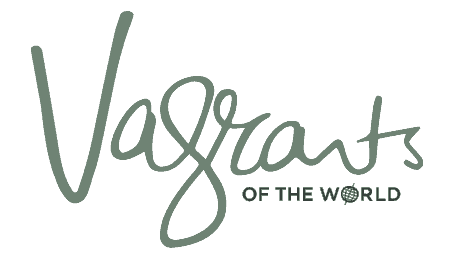
How to Use the Moscow Metro and Which Stations to Visit.
By: Author Kate O'Malley
Posted on Last updated: August 20, 2022
Home >> Destinations >> How to Use the Moscow Metro and Which Stations to Visit.
Your first encounter with the beautiful Moscow Metro stations will surprise you. Never has a rail system been more appealing and just a little intriguing.
Once described as a ” Subterranean paradise for the people”, the Moscow Metro is one of the most extraordinary subway systems in the world
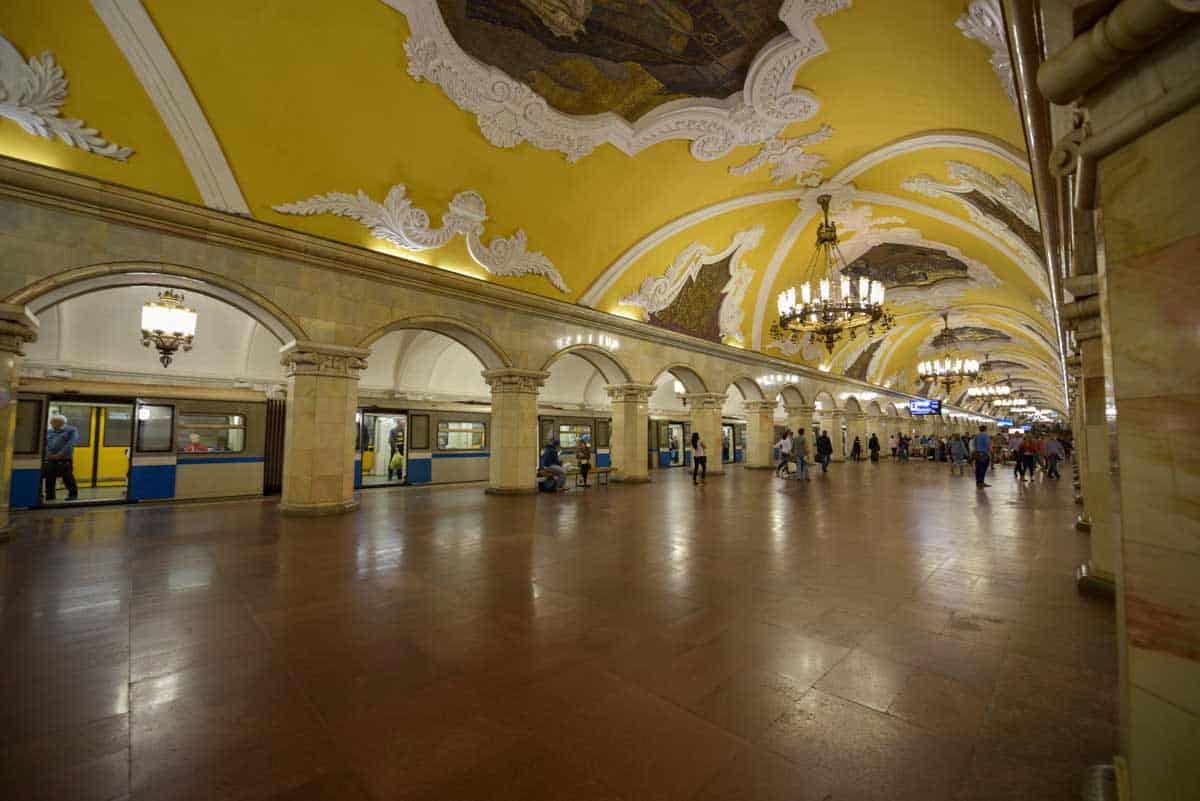
Table of Contents
Most Beautiful Metro Stations in the World
We have travelled on a lot of public train systems all over the world. We have marvelled at the modern efficiency of some rail systems, especially in Asia.
We have baulked at the cost of others such as the Tube in the UK and in New York, we pondered which is uptown and which is downtown in relation to where we need to be.
We have also enjoyed a polite attitude to public transport and ease of navigation, in places like Athens.
We have discovered first class can be anything but classy and navigated our way through some of the dirtiest and some of the cleanest train systems the world has to offer. However, we have never come across anything as impressive as the Moscow Metro stations.
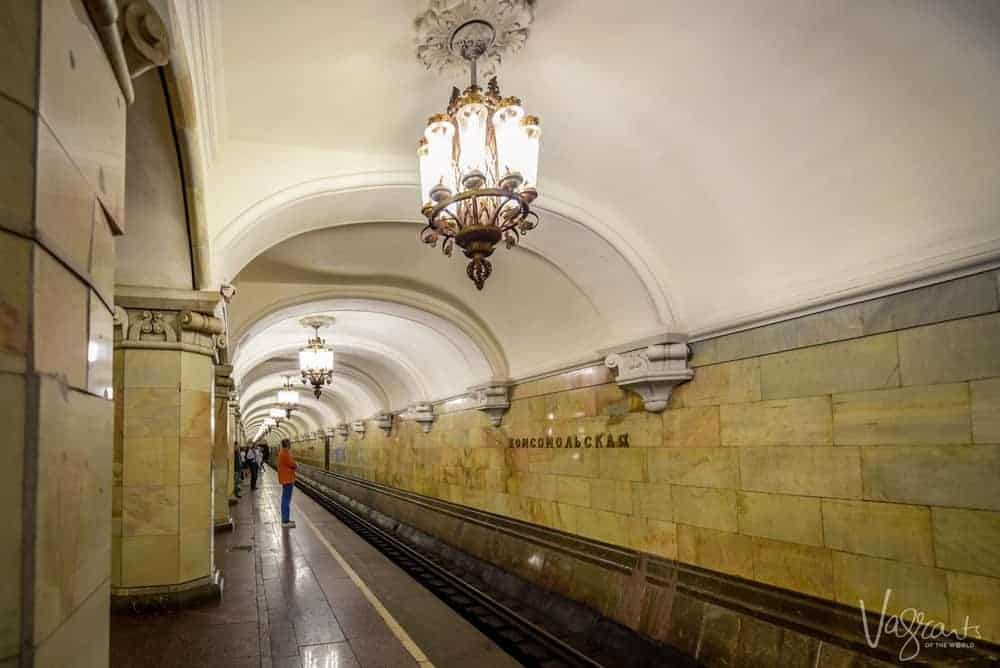
How Many Metro Stations are in Moscow?
The first Moscow Metro system opened in 1935 with 13 stations along a single 11-kilometre (6.8 mi) line.
As of 2021, the Moscow Metro has grown to include 241 stations (276 including the Moscow Central Circle Line ) The entire Moscow Metro length is 412.1 km (256.1 mi), making it the fifth-longest metro system in the world. China has the four longest.
Nearly 10 million people commute on the Moscow Metro each day making it one of the most heavily used systems in the world and the busiest metro system in Europe. It is no wonder it is considered a tourist attraction in itself and one of the best things to do in Moscow .
How Deep is the Moscow Subway?
The majority of the Moscow Metro system is underground with 70 deep-level stations, nearly 90 shallow stations and the remainders either on the surface or at elevation.
The deepest station is Park Pobedy Station which is 84 meters, (275 ft). At roughly the same height as a 28 storey building, it is one of the deepest metro stations in the world, behind St Petersburg’s Admiralteyskaya Station which is located 86 meters (282 ft) below ground.
Get a Moscow Metro Map
There are several multicoloured maps of the metro system in each car and there will be an announcement each time you arrive at a station. These announcements should be in Russian and English but may not always be easy to understand, so it will be handy to have a map, or app in English to help you navigate your way.
Moscow Metro Map:
You can download a map of the Moscow Metro in English here . However, using a Moscow Metro App might be more informative.
Moscow Metro App:
Download the official Moscow Metro app which gives you up to the minute information. Or, download apps you can use even when offline. Download the Moscow Metro App for IOS Here. and for Android Here .
Why Are the Moscow Metro Stations So Beautiful?
Stalin’s vision for the moscow metro.
Stalin had the vision to create a magnificent Metro system that would resemble “People’s Palaces”. His vision was realised in 1935 when the Metro was opened with just 13 stations.
Moscow Metro Art and Design
Every station has a unique design indicative of the era and political leader of the time. Stories of Russia’s history that make you want to keep exploring these “ subterranean palaces “.
Lined with marble and decorated with chandeliers, intricate mosaic artworks, heroic statues and gilded trimmings, the Moscow Metro stations are not merely decorated; they are works of art.
An entire day can be spent station hopping, admiring beauty and opulence that would have received a nod of approval from the Romanov’s themselves. We share a small sample of the best Moscow Metro stations and what you will expect to find in this underground art gallery.
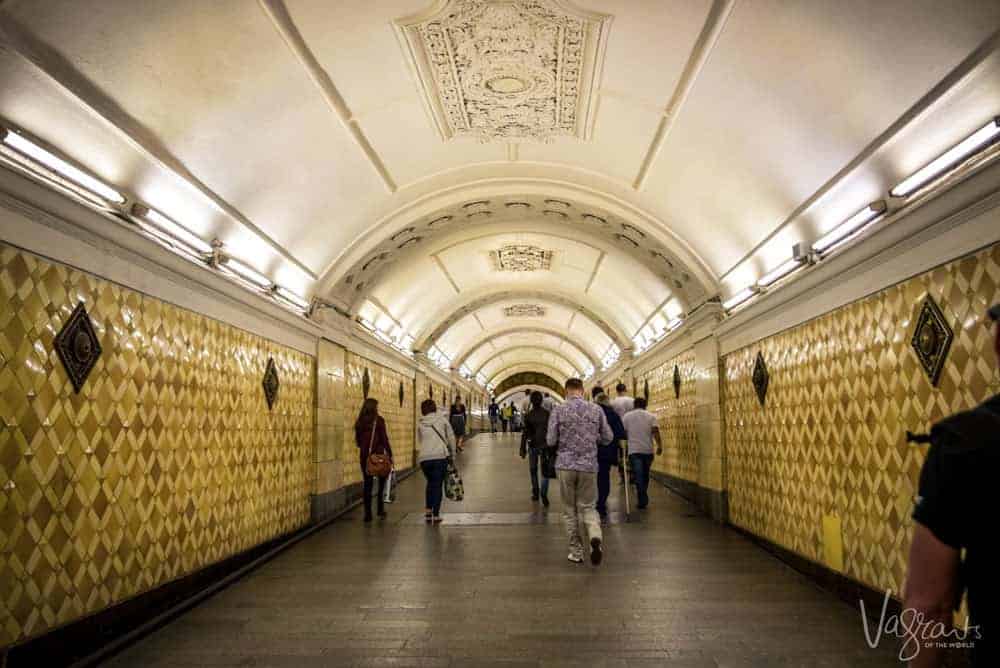
Moscow Metro History
The first underground system in the Soviet Union, the initial metro stations were built by forced soviet labour. Much of the design and artworks within the stations depict the Soviet Union’s greatest achievements and historical milestones as well as paying homage to Russia’s diverse artistic, literary and architectural legacy.
British engineers were commissioned for the initial project because of their experience with the London underground system. Interestingly, they were later arrested on suspicion of espionage. It was believed they knew too much about the Russian underground system.
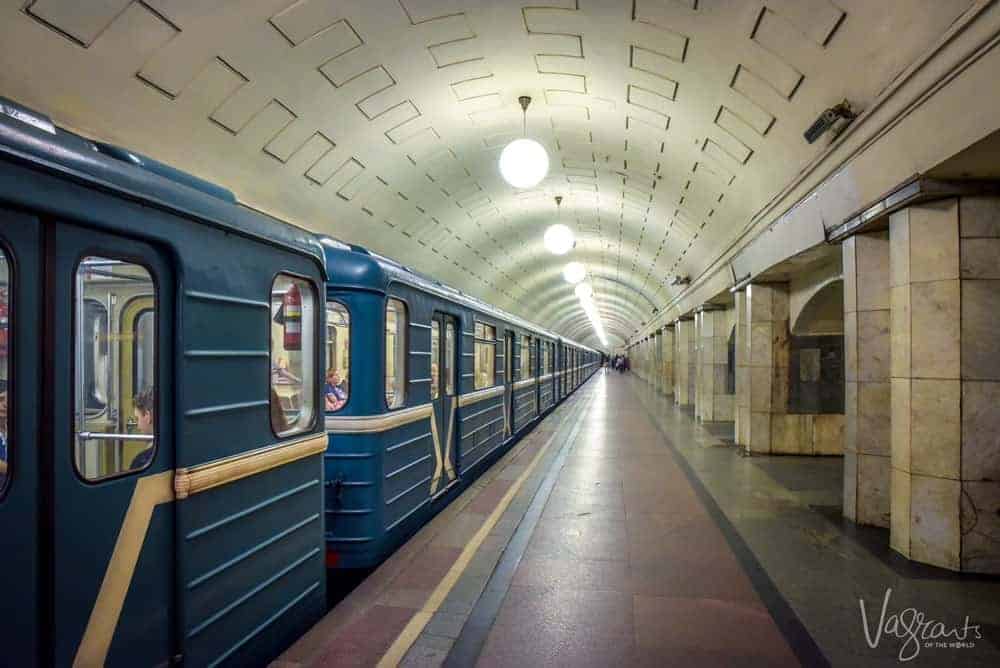
How to Use the Moscow Metro System
Not only is the Moscow Metro beautiful, extremely clean and very safe, it is also a cheap way to get around Moscow. Although, travelling on the Moscow Metro can be a little daunting.
It is the second busiest rail system in the world so it can get very crowded. Here are some tips to help you navigate the Moscow Metro.
Navigating the Moscow Metro. Travelling from Station to Station
Travelling between stations on the Moscow Metro can be challenging, especially when it is busy. In addition to using a Moscow Metro app or map, these tips for using the metro will help if you are unsure about stations or lines.
Listen to the Voice on the Annnouncement
- Usually, the announcement of the next station will be by a man’s voice on the trains travelling to the city centre.
- On services travelling away from the city centre, announcements will be a woman’s voice.
- On the circular line – the maroon coloured line, a man’s voice announces the stops if it is travelling in a clockwise direction and a woman’s voice if it’s travelling counterclockwise.
Signage in the Metro
There is a comprehensive signage system throughout the metro system showing the various lines, colour coordinated to correspond with each line.
- You will see overhead signs showing which way to go to access each line.
- Detailed maps on the platforms show the direction of the train, which stations it will stop at and the station you are currently at.
- Large colour coded stickers on the floors show where you need to change lines.
All signs are written in Russian Cyrillic and English. If you get overwhelmed, look for the colour line on your map and the final station on that line and follow the signs.
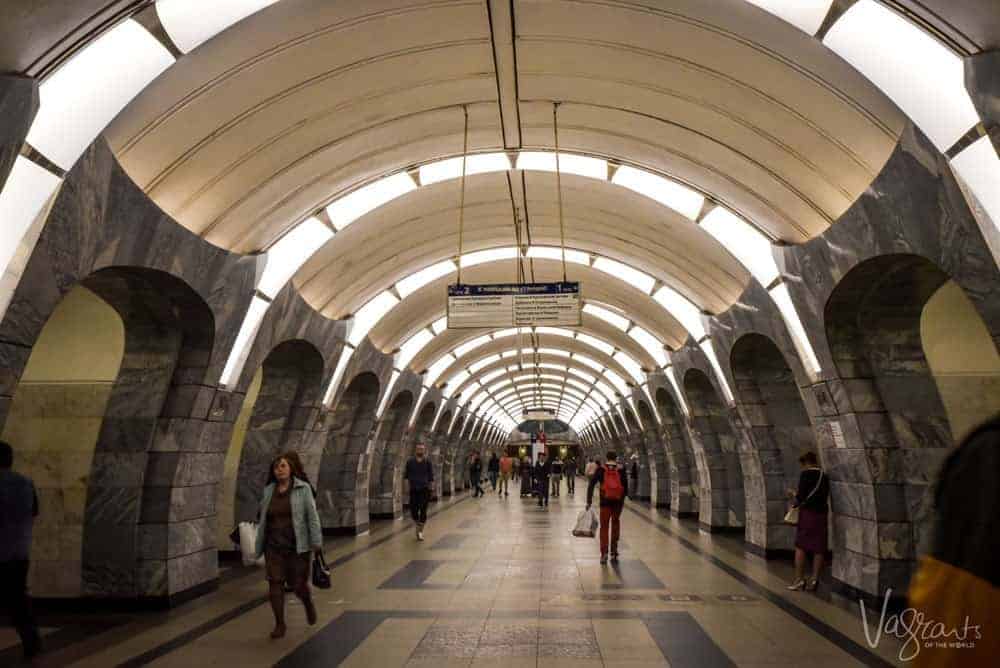
Exiting the Metro
Most of the metro stations will have several exits. Busy stations in the city centre, such as Kitai Gorod can have as many as 15 exits. For visitors to Moscow, this can be quite daunting.
Exits are all numbered. Look for maps at the exits or signs in lobby areas showing the surrounding area and major sights which can help guide you to the right exit number.
You will also see overhead signs at exits listing the nearby sights, streets, shopping malls, and other reference points to help you navigate.
Around the station walls, you will also see signs guiding you to public transport stops with bus, tram and trolleybus numbers.
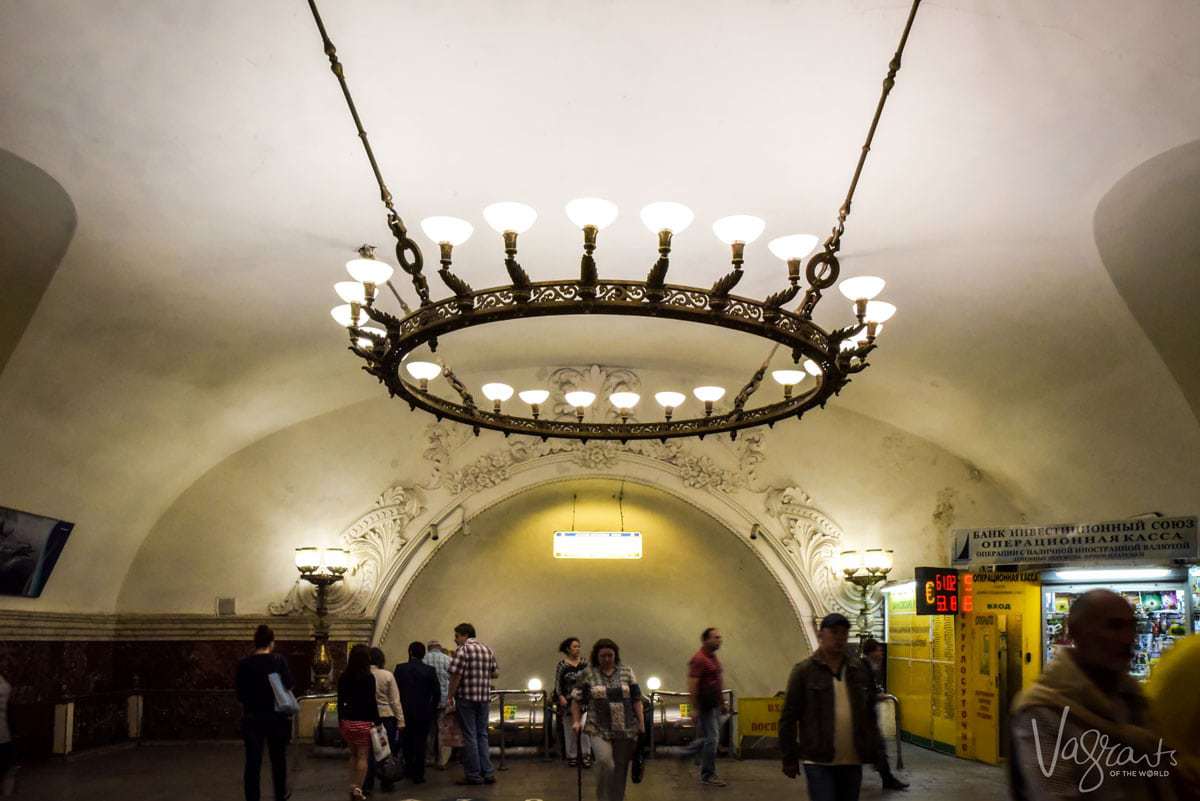
With some of the deepest stations in the world, you can expect some very long and steep escalators. The longest escalator in the Moscow Metro is 413 ft (126 metres). Climbing such a long-distance means the escalators also move faster than many people are used to.
Along with the steep angle of the ascent and descent, boarding the fast-moving escalators can be a bit nerve-racking at first. Approach with confidence and don’t hesitate when boarding. Remember to stand on the right of the escalator to allow people to pass.
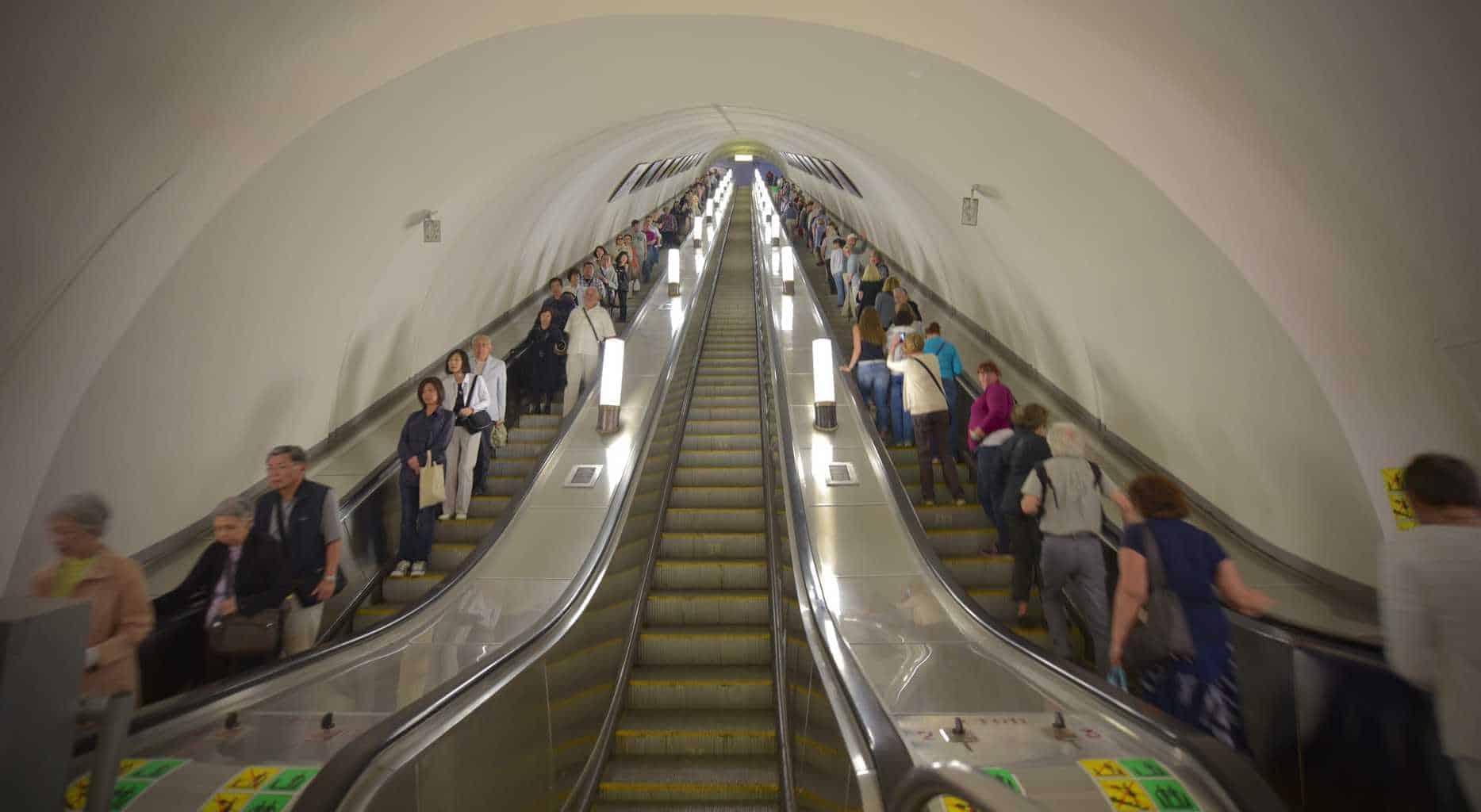
Avoid Rush Hour
As mentioned, the Metro moves more than nine million people each day around Moscow. If you are planning to spend some time exploring the Metro system, it would be wise to avoid rush hours.
Rush hours on the Moscow Metro are between 8.00 AM and 10.00 AM and again between 5.00 PM and 7.00 PM
During rush hour, the train cars get very crowded and you will have to move fast to get on and off the trains as well as trying to avoid being pushed around too much. It will also be more difficult to read the station names from inside the train cars. This will make trying to navigate the system more difficult and will not be as pleasant an experience.
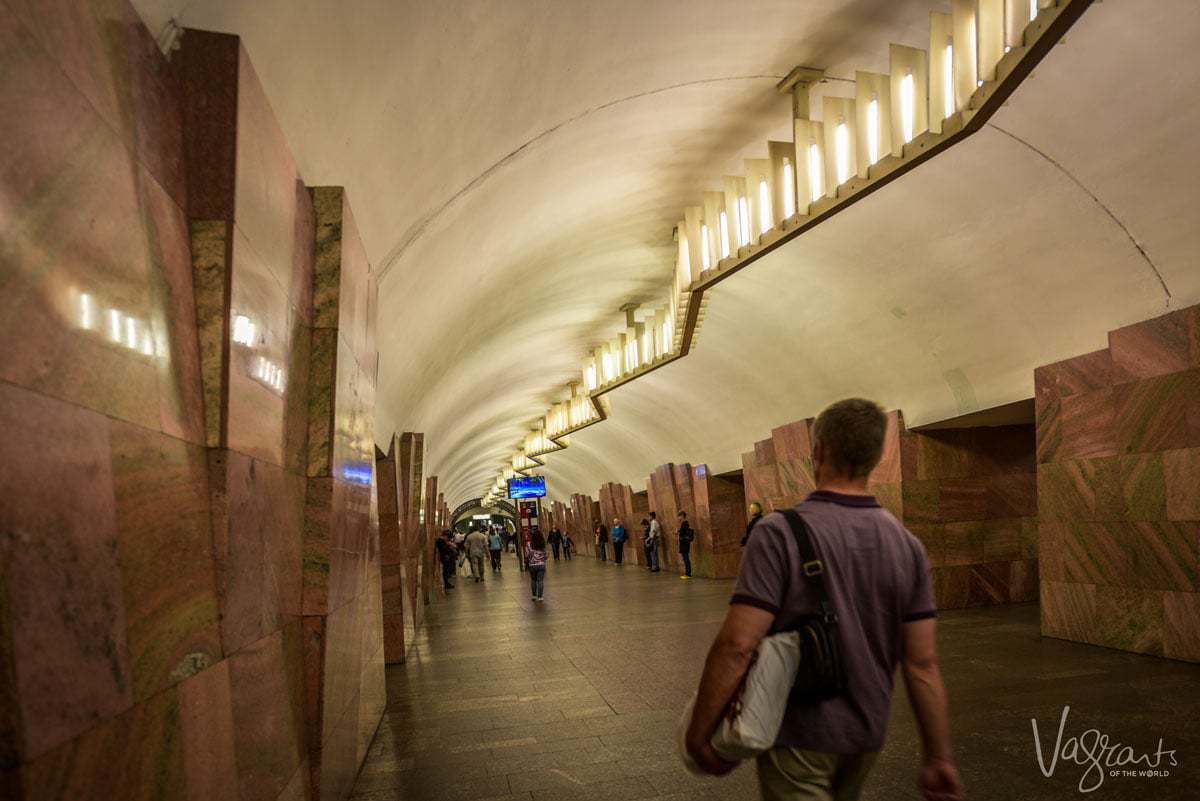
Safety on the Moscow Metro Watch Your Belongings
The Moscow Metro is well monitored with security staff and cameras so is overall very safe. However, like any busy city, the Moscow Metro attracts large numbers of people including pickpockets. Be extra careful at the most visited tourist stations, especially, on the Circle Line in the city centre.
The fascinating ballroom-like stations on the Circle Line not only attract tourists but is also connected to the 7 out of 9 Moscow railway stations so it always feels busy there. Make sure your bags are secure and zipped up at all times and valuables are secure in inside pockets. We highly recommend a good anti-theft backpack or anti-theft handbag for travelling in cities like Moscow.
Stay Safe in Moscow: Read Our Best Safe Travel Tips & Anti Theft Travel Gear Guides for a stress-free travel experience in Moscow.
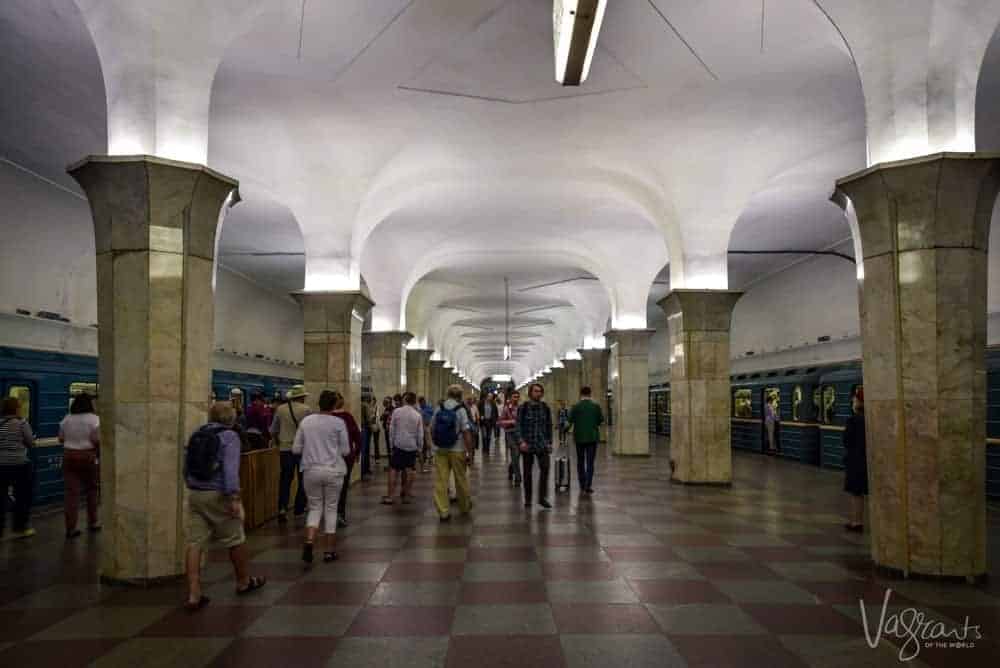
Moscow Metro Tickets
Ticket cost.
- A one way ticket or one trip ticket on the metro is ₽55.00 (less than USD $1) regardless of the length of the trip. Two trips ₽110.00.
- There are no zones so it doesn’t matter how far you travel or how long your trip is. You’ll need a ticket only once at the entrance to the metro. You may change lines as many times within the system on the one fare.
- A day or multiple day passes are also available. You can visit the Moscow Metro website here for full schedule of fares and payment options.
Purchasing Tickets
You can purchase metro tickets in two basic ways:
- Automatic machines – They are in both Russian and English so are relatively easy to use.
- Ticket booth – If you are not comfortable using the machines look for the ticket booths marked “KACCA”. There are both Russian and English speaking booths – look for ticket booths with a “we speak English” sign. However, if you can’t find an English speaking booth, you don’t need to speak Russian. Just hold up the number of fingers of tickets you need. Once you pay, you will receive a card that will serve as your ticket.
- Card payments are commonplace with contactless payment also possible. However, it is still wise to have cash with you in small denominations to purchase tickets incase cards are not be accepted or you need to use a mchine.
Guided Metro Tours in the Moscow Metro
If navigating the Moscow Metro on your own sounds too daunting, get yourself a Moscow Metro guide who will guide you through the metro system. They will take you to the most beautiful stations while revealing the history and stories that make this one of the most unique underground rail systems in the world.
Guided Metro tours are available for as little as USD $20.00 pp. A guided tour is also a great way to learn how to navigate the metro system so you feel comfortable exploring further on your own.
Recommended Moscow Metro Tours
Small-Group Moscow Metro Tour : See the nine most beautiful underground metro stations in Moscow on a 90-minute small group tour. Includes English speaking guide and metro ticket. See here for full tour details .
Moscow Metro & Bunker-42 Guided Tour: Tour the best Moscow metro stations and Bunker-42. The once-secret military complex, bunker, and communication centre is now a museum devoted to the Cold War between the USSR and the USA. The 2-3 hour tour includes all tickets and guides. See here for full tour details .
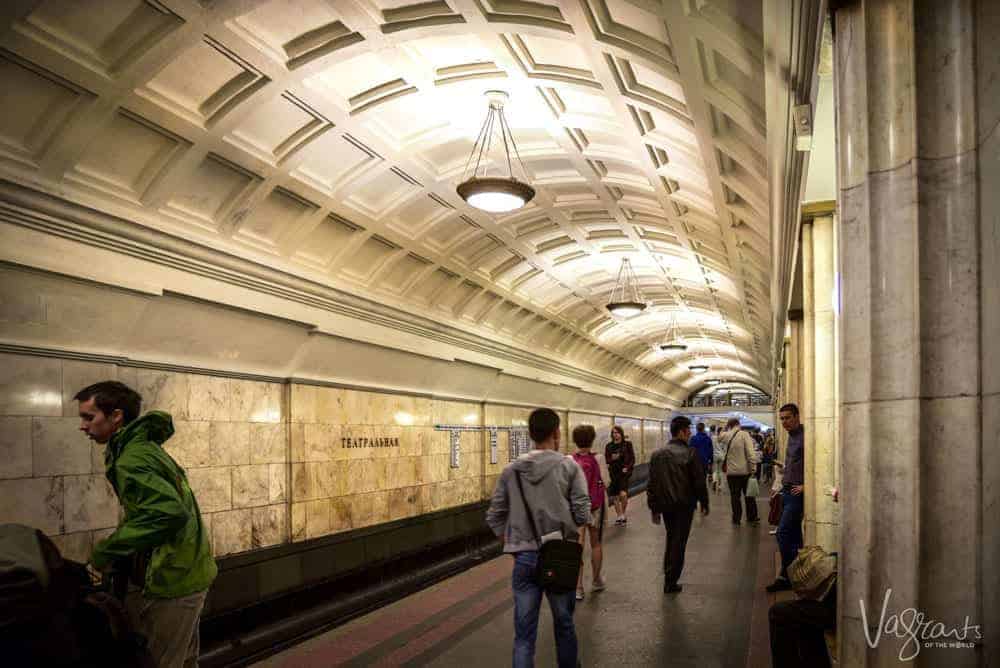
15 of the Best Moscow Metro Stations to visit.
A metro station for all tastes.
If it is the baroque opulence of the Stalin years that tickles your fancy or the beautiful sleek designs of modern stations you seek. The Moscow Metro stations have an array of designs that will take you on a journey through Russia’s history and quite simply impress you. These are some of the best stations to visit on the Moscow Metro.
Mayakovskaya Station Line 2 Green
Mayakovskaya Station is on the Zamoskvoretskaya line – Line 2. Used as a bomb shelter during the war, a hospital and even a supreme command headquarters. In 1941, Stalin celebrated the anniversary of the Bolshevik revolution at Mayakovskaya Station, complete with elegant catering for all the attending dignitaries while the Nazis bombed the city above.
The scene was later depicted in the mosaics in the centre of each dome. Historic moments like this captured in various stations shows how fascinating the Moscow Metro is.
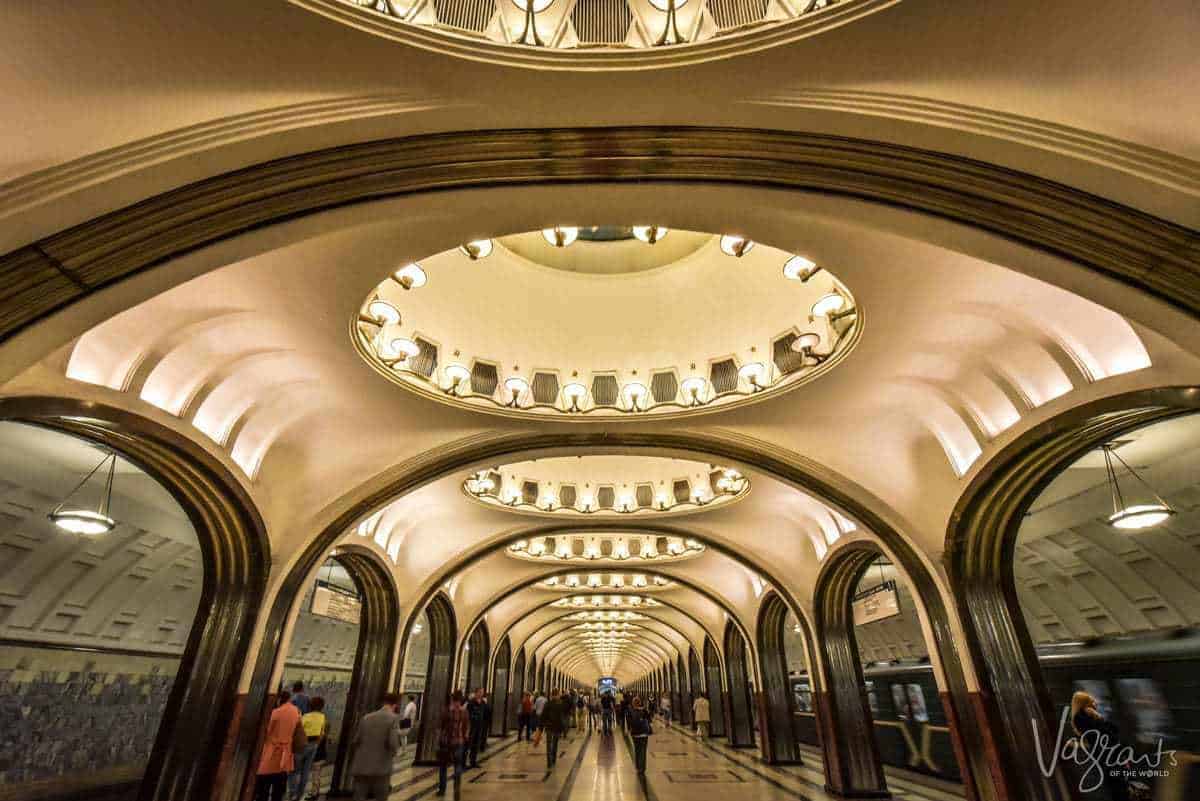
Teatralnaya Station Line 2 Green
Teatralnaya Station is on the Zamoskvoretskaya line – Line 2. Named for the nearby Theatre Square, Teatralnaya Station opened in 1938 as part of the second stage of the Moscow Metro construction.
Designed as a tribute to the arts, this pretty station is lined with fluted pylons and white marble salvaged from the demolished Cathedral of Christ the Saviour.
Novokuznetskaya Station Line 2 Green
Novokuznetskaya Station is on the Zamoskvoretskaya Line – Line 2. In honour of Soviet fighting men, seven octagonal ceiling mosaics, bas-reliefs and cast bronze portraits depict soldiers of the Red Army and Russian war heroes.
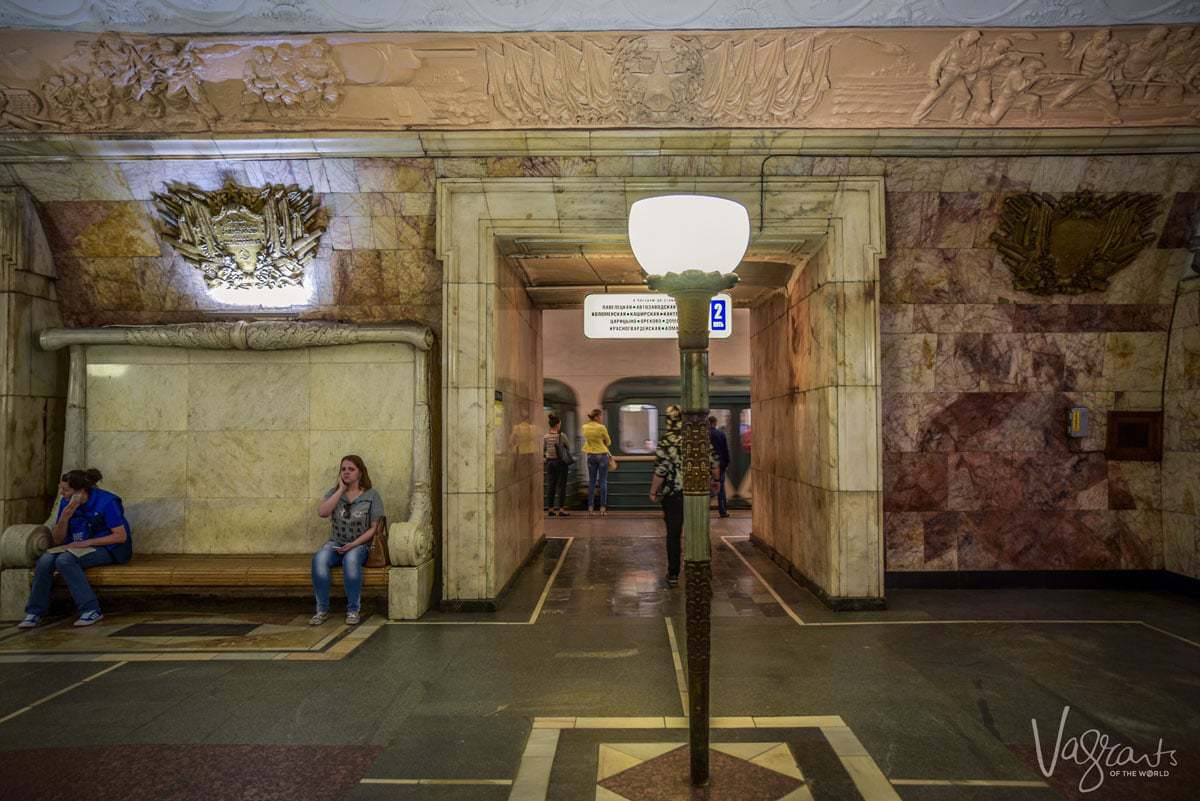
The large, ornate marble benches that line the platform marble walls were taken from the cathedral of Christ the Saviour and original floor lamps give Novokuznetskaya Station a special ambience.
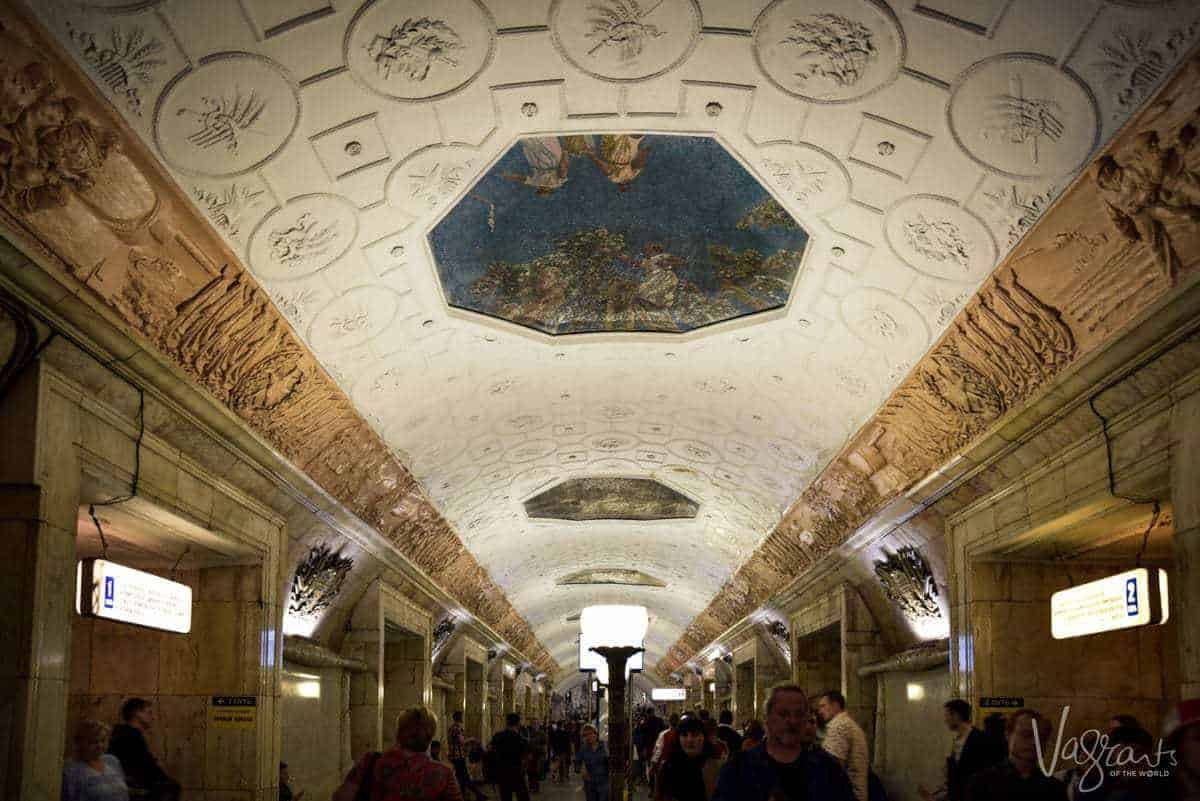
The central hall is decorated with crystal lamps and bas-reliefs depicting the theatre arts of the USSR made by the Leningrad Porcelain Factory.
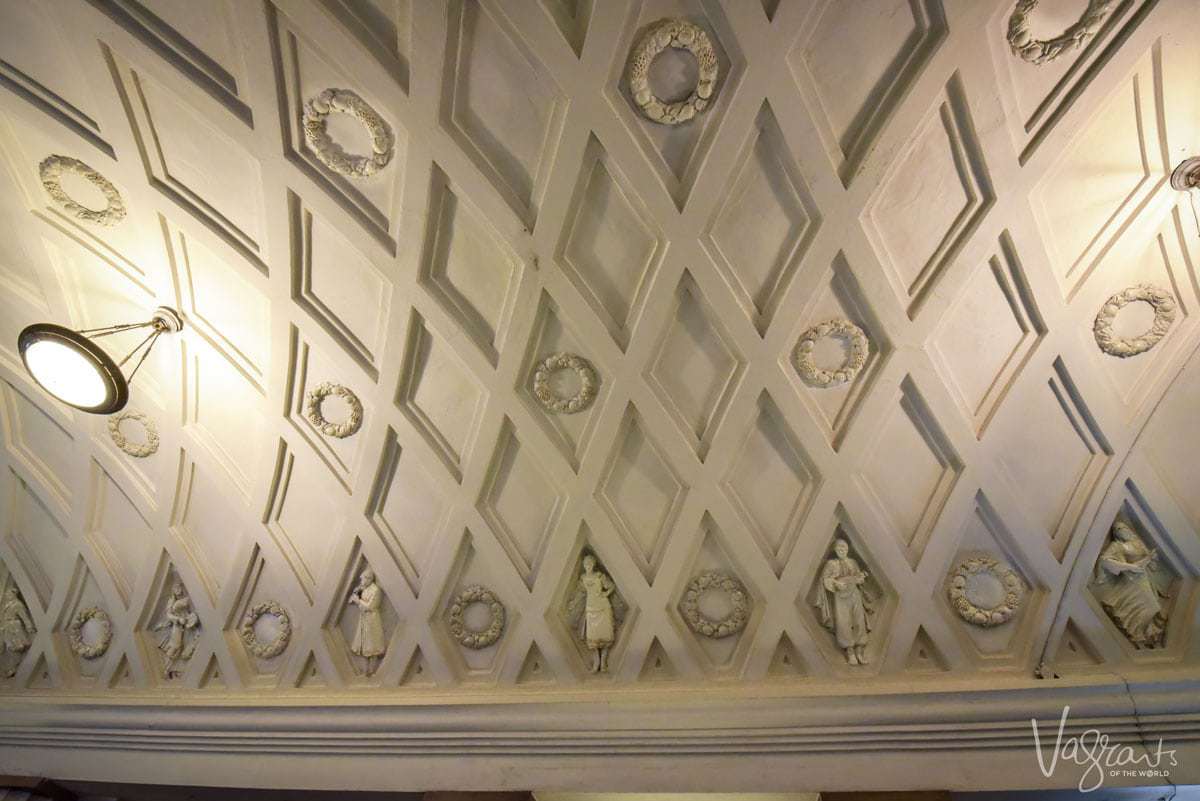
Ploshchad Revolyutsii Station (Revolution Square) Line 3 Blue
Ploshchad Revolyutsii Station is on the Arbatsko–Pokrovskaya line – Line 3. Revolution Square is one of the most famous stations and one of the closest stations to Red Square.
Easily one of the most impressive, it is lined with life-size bronze sculptures depicting the people of the Soviet Union; workers, peasants, soldiers, artists and children – 72 in total.
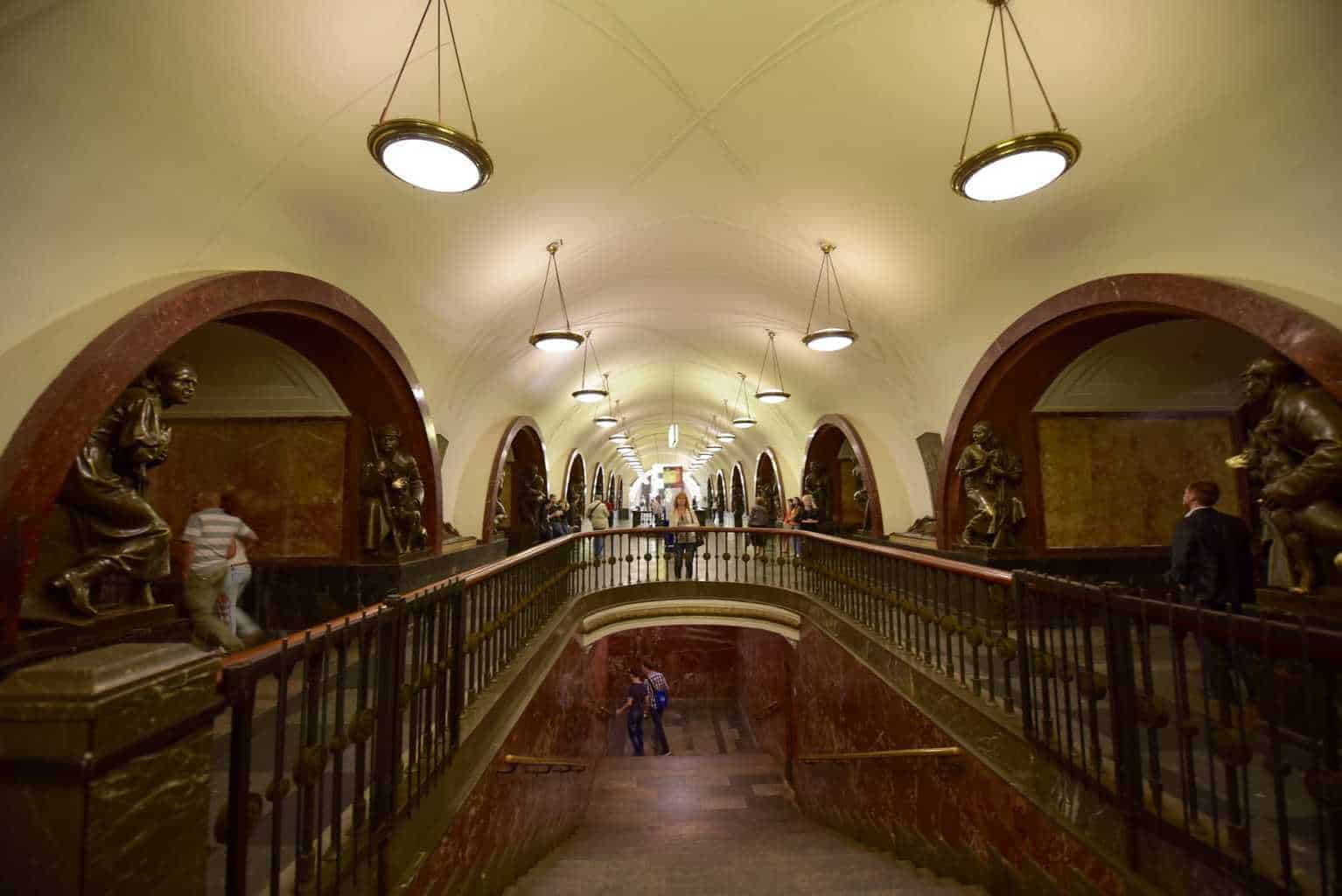
Tradition states it is good luck to rub the nose of the dog depicted in one sculpture and as if by reflex, we barely noticed anyone who failed to do so as they passed.
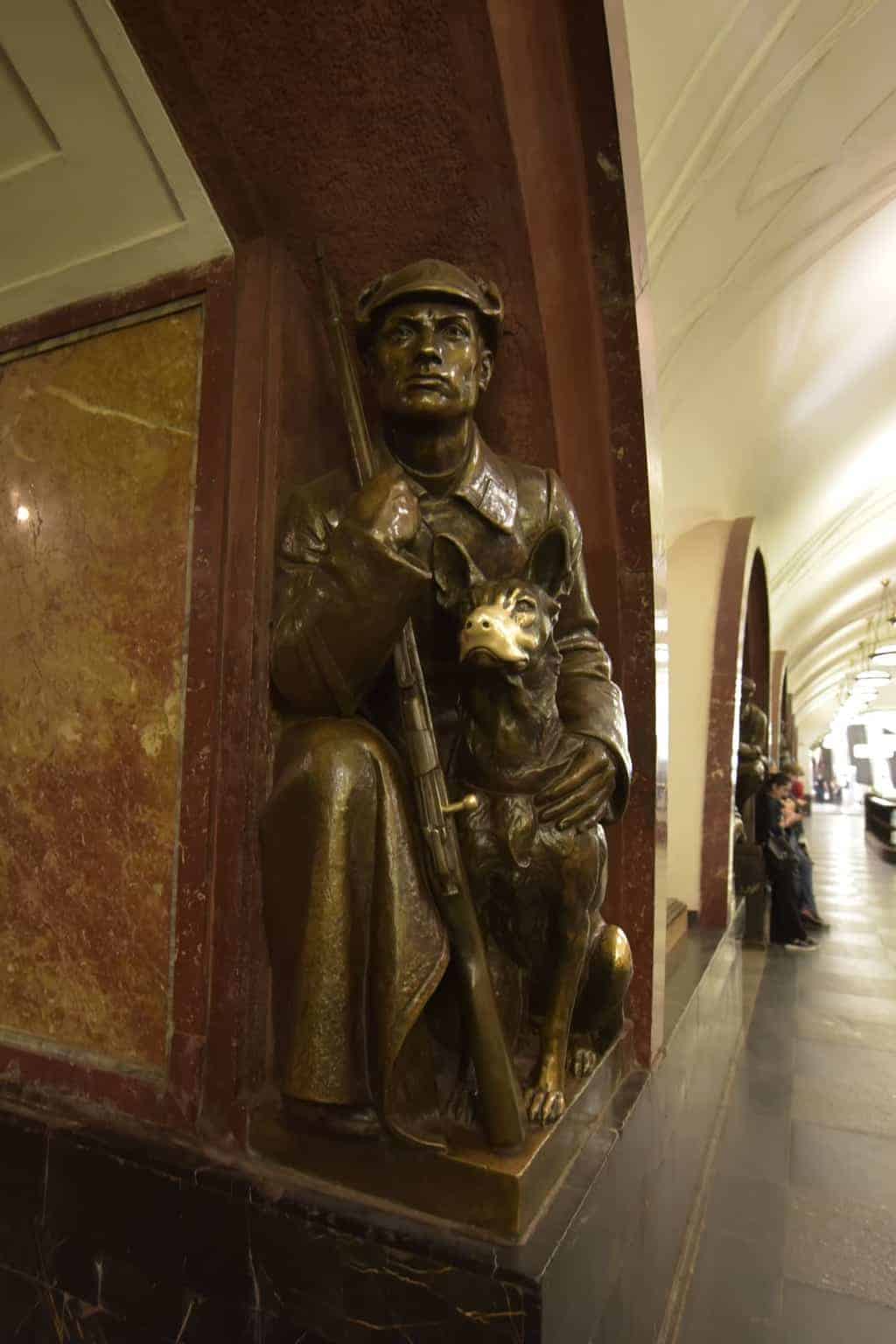
Elektrozavodskaya Metro Station Line 3 Blue
Elektrozavodskaya Metro Station is on the Arbatsko–Pokrovskaya line – Line 3. A favourite, this station was named after the nearby electric light bulb factory. The concept was to make a ceiling covered with six rows of circular incandescent lamps- 318 in total. Built during the third stage of the Metro construction, Elektrozavodskaya Metro Station opened during WW II in 1944.

The station’s initial architect died during construction and the outbreak of the war halted works until 1943. Another architect finished the works incorporating an additional theme, bas-reliefs installed on the walls to document the struggle of the war.
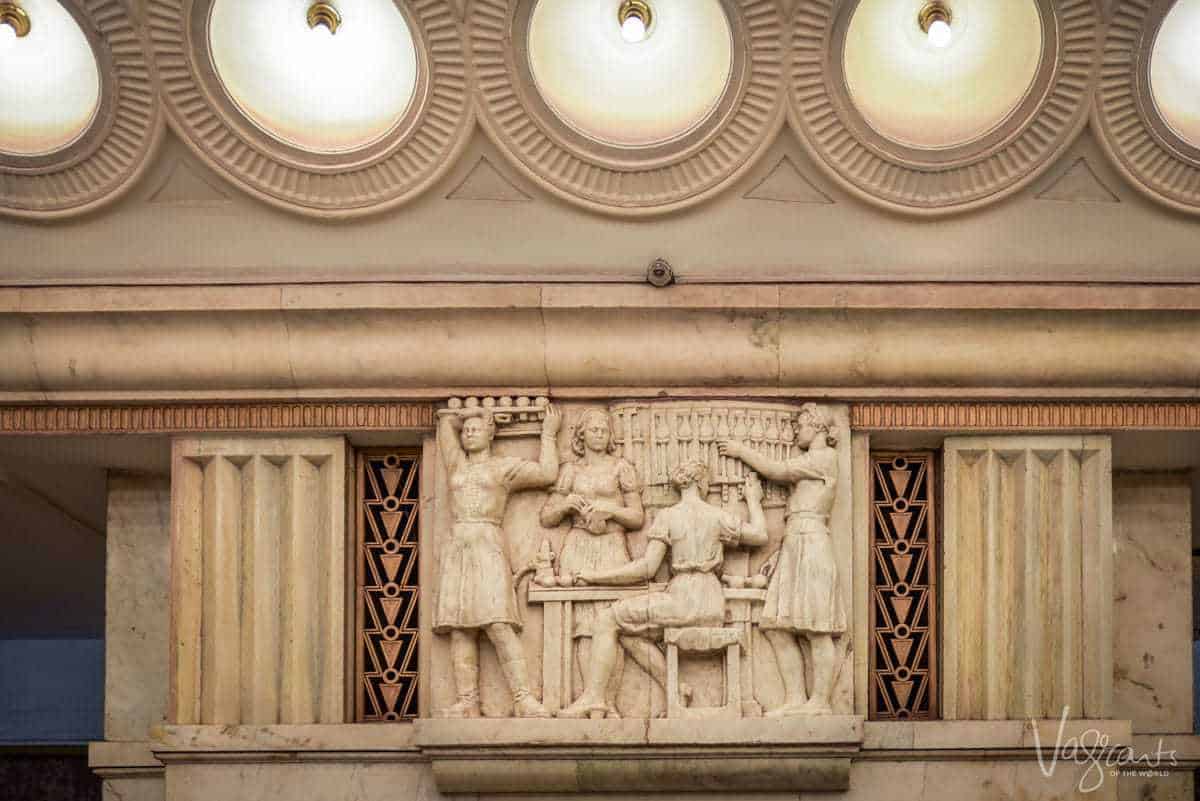
Arbatskaya Station Line 3 Blue
Arbatskaya Station is on the Arbatsko–Pokrovskaya line – Line 3. Completed in 1953, the year of Stalin’s death, Arbatskaya Station was intended as a bomb shelter. At 41 metres below ground, this station represents Stalin’s love of baroque. Arched ceilings decorated with ceramic bouquets, ornate bronze chandeliers, and glazed tiles.
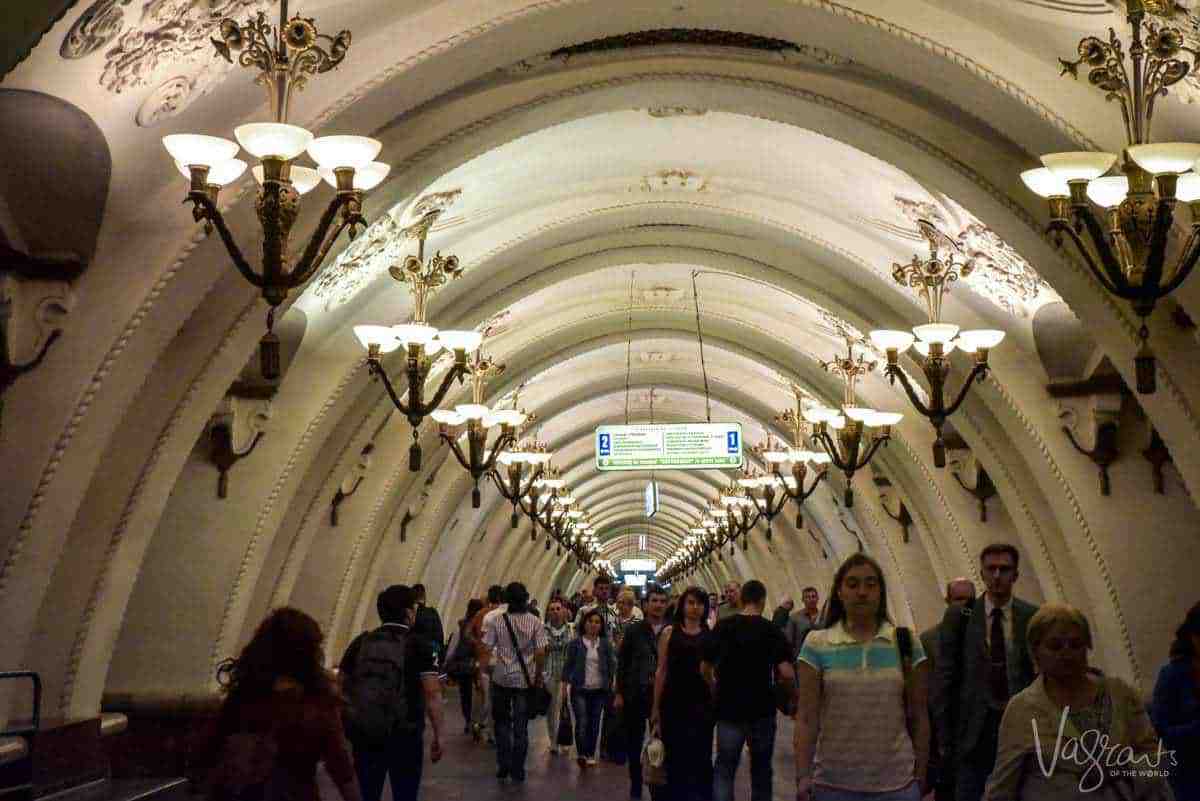
Hardly the standard decor of a bomb shelter. This station was built not long before criticism of luxury Soviet architecture resulted in austerity and functionality began to prevail.
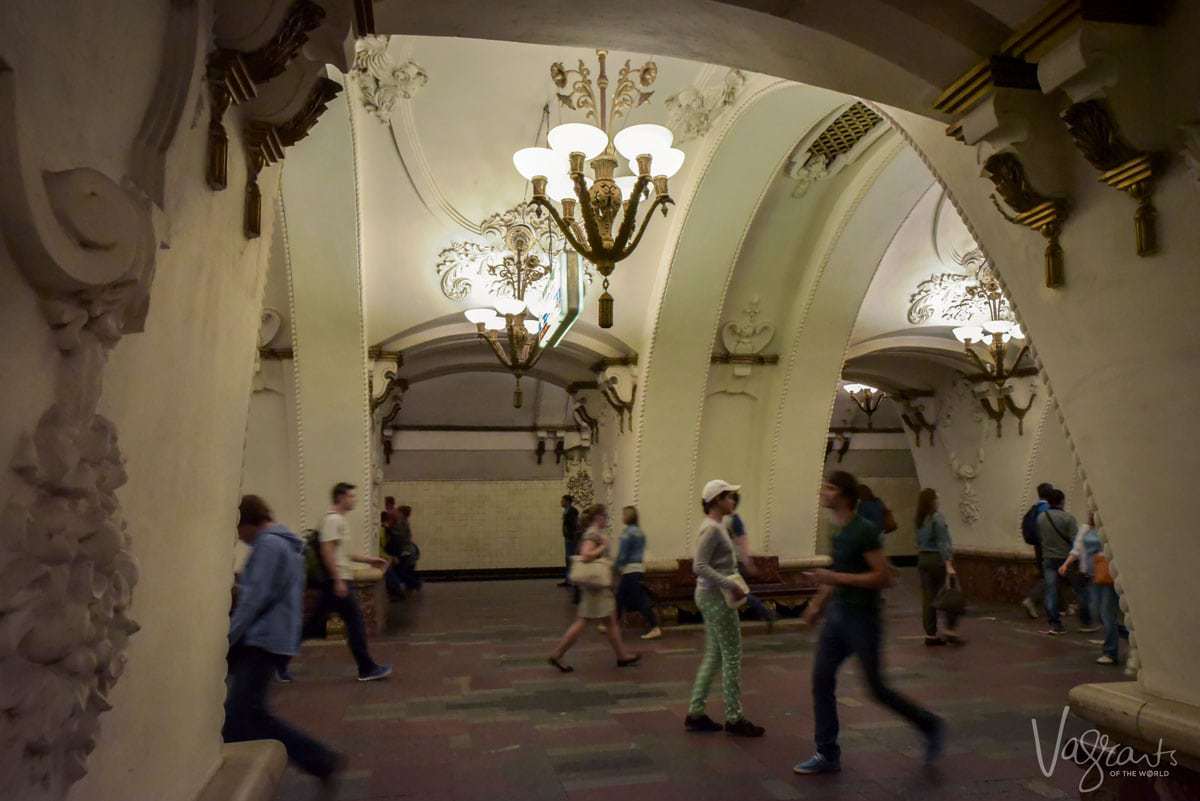

Park Pobedy Line 3 Blue
Park Pobedy Station is on two lines: the Arbatsko–Pokrovskaya line and the Kalininsko–Solntsevskaya line.
Park Pobedy (Victory Park) features a modern design in hues of red marble with mosaics depicting great Russian victories including the 1812 French Invasion on the inbound platform and World War II on the outbound platform. However, beyond interior design, there are a number of interesting facts and features of Park Pobedy station.
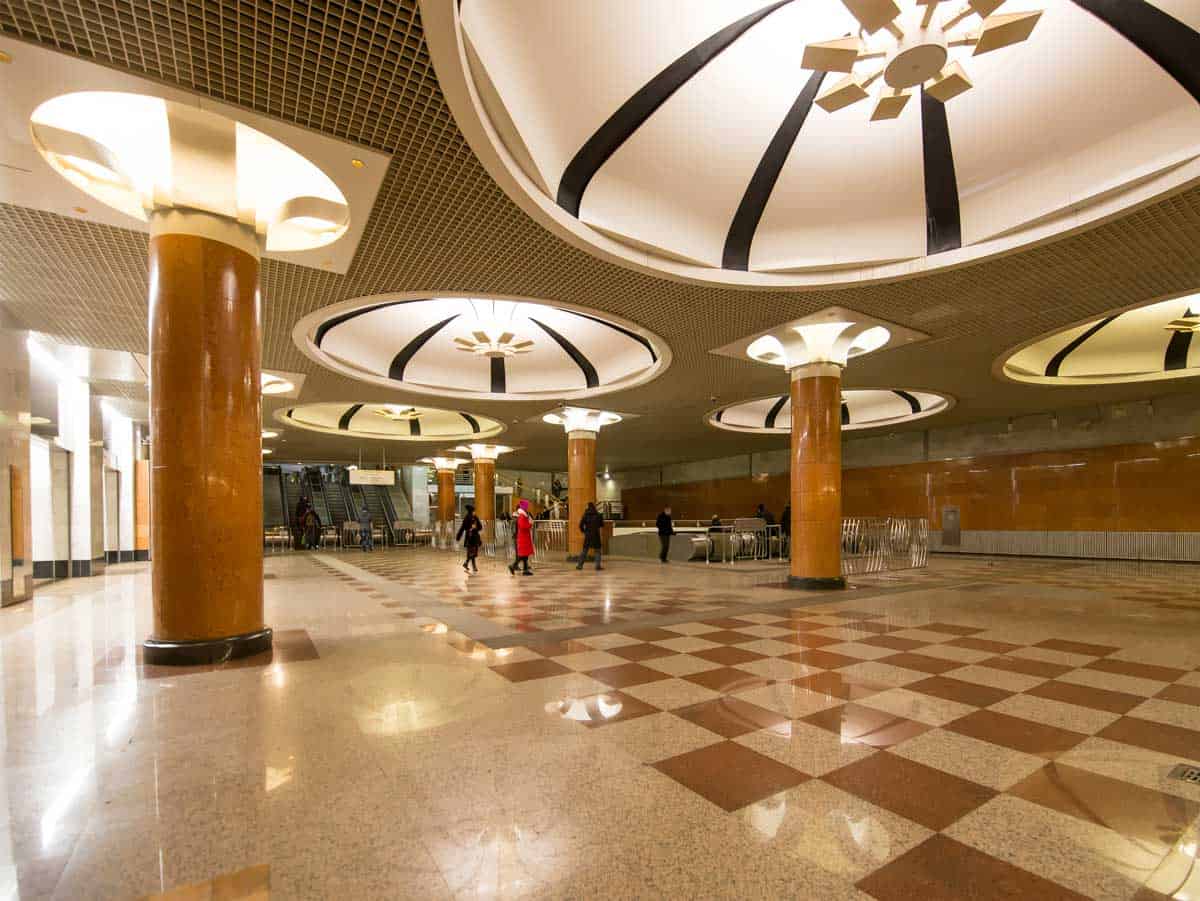
At 84 metres (276 ft), Park Pobedy is the deepest station in Moscow and the fourth-deepest in the world by mean depth, and the deepest station by maximum depth, 97 metres (318 ft).
Park Pobedy has the longest escalators in Europe. At 126 metres (413 ft) long and with 740 steps each it takes approximately three minutes to reach the surface.
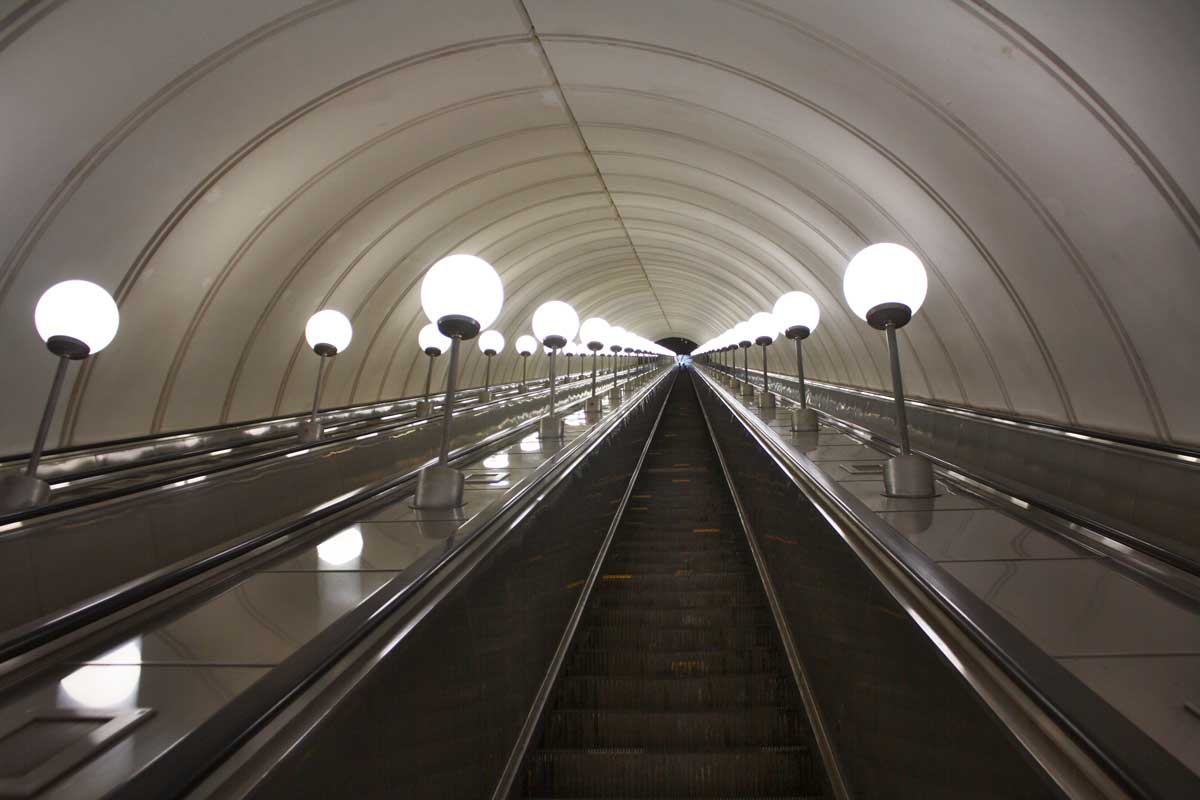
It is the only Moscow metro station where passengers board and alight trains in different locations.
The two platforms are identical in design but with opposite colour schemes. The outbound platform has pylons faced with red marble on the transverse faces and pale grey marble on the longitudinal faces. The inbound platform is the exact reverse.
The unique structural design. The Park Pobedy tunnel lining included steel blocks filled with concrete instead of traditional cast-iron tunnel lining. Reducing the amount of structural metal consequentially reduced the overall cost of construction.
Slavyansky Bulvar Station Line 3 Blue
Slavyansky Bulvar station is on the Arbatsko-Pokrovskaya Line, between Kuntsevskaya and Park Pobedy stations – Line 3. Opened in 2008, Slavyansky Bulvar is one of the more modern metro stations.
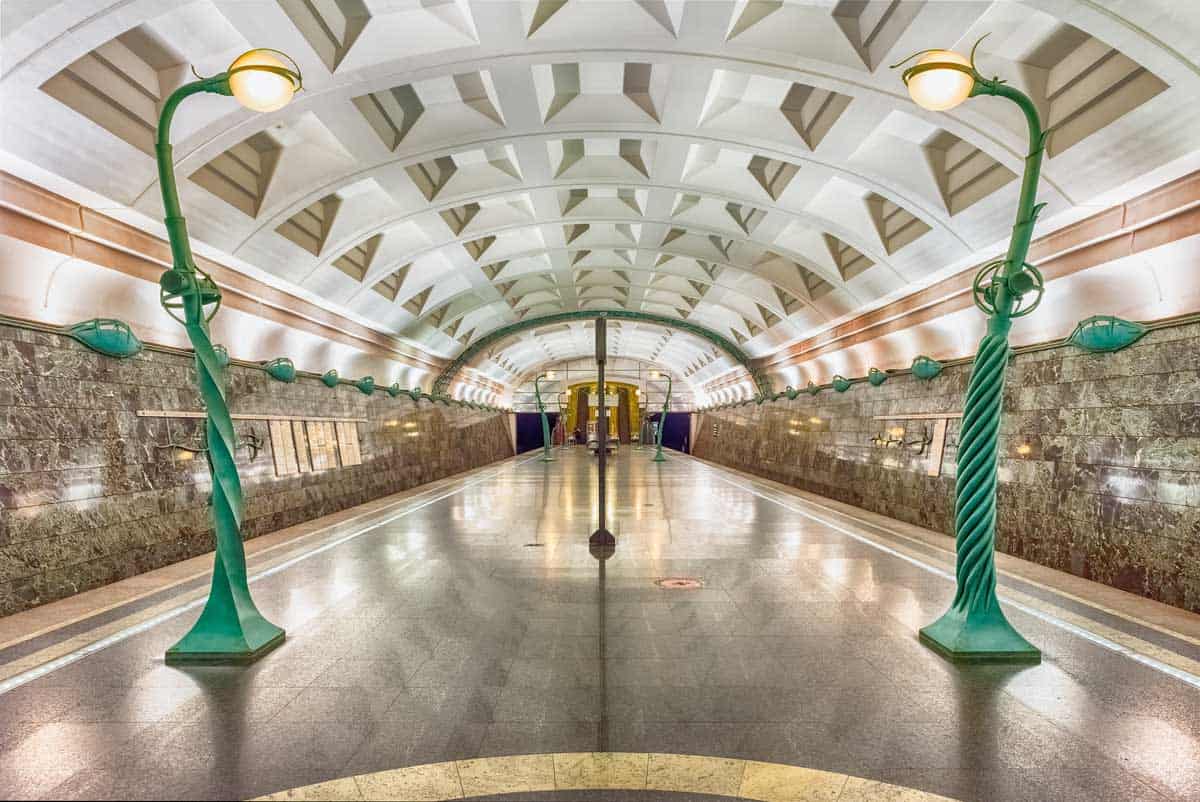
The shallow underground station hall sits at around 10 meters, lined with sleek finishes of green Cuban marble “Verde Guatemala”, granite, aluminium and beech.
However, the green Art Nouveau flourishes chosen by Architect S.Volovich, similar to those that adorn the entrances to the Paris Metro system, give Slavyansky Bulvar station an almost whimsical beauty.
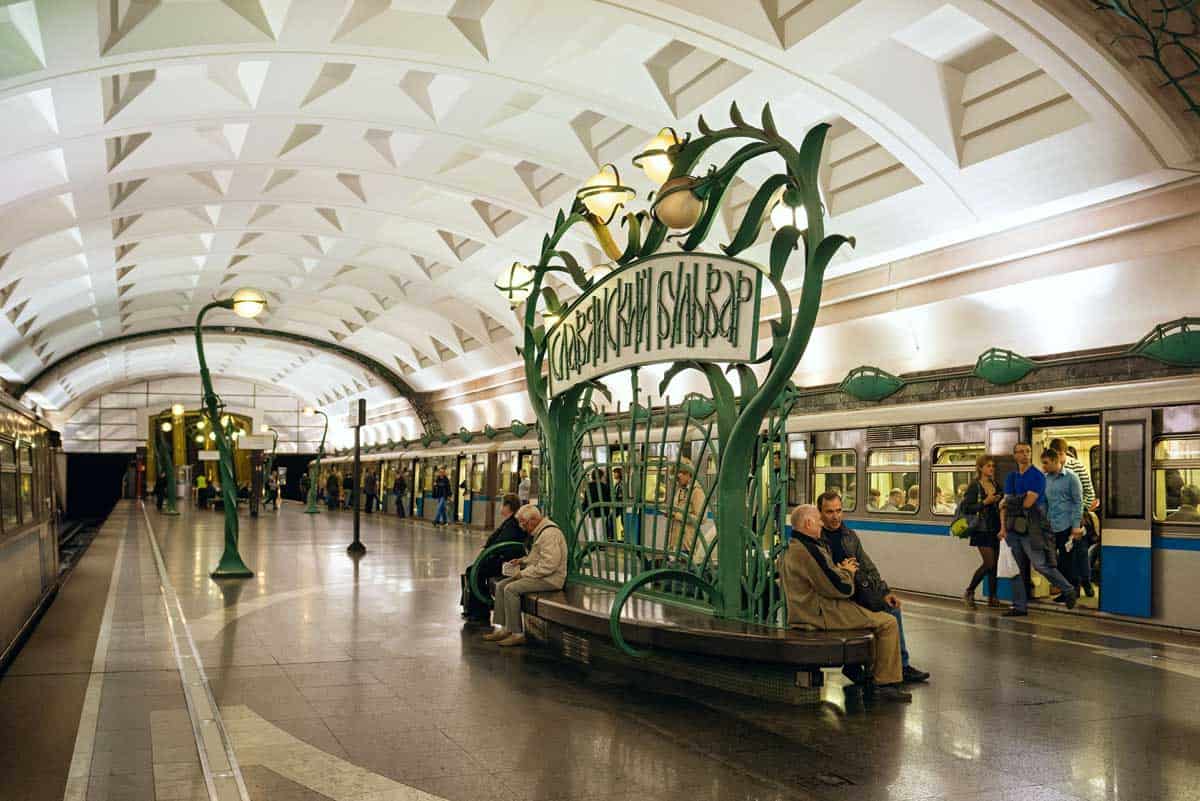
Taganskaya Station Line 5 Brown (Circle Line)
Taganskaya Station is on the Koltsevaya line – Line 5 Circle Line. Opened in 1950 Taganskaya Station is named after the Taganka Square, a major junction of the Sadovoye Koltso ring road.
Despite the fairly practical naming inspiration, the pylon station is anything but boring.
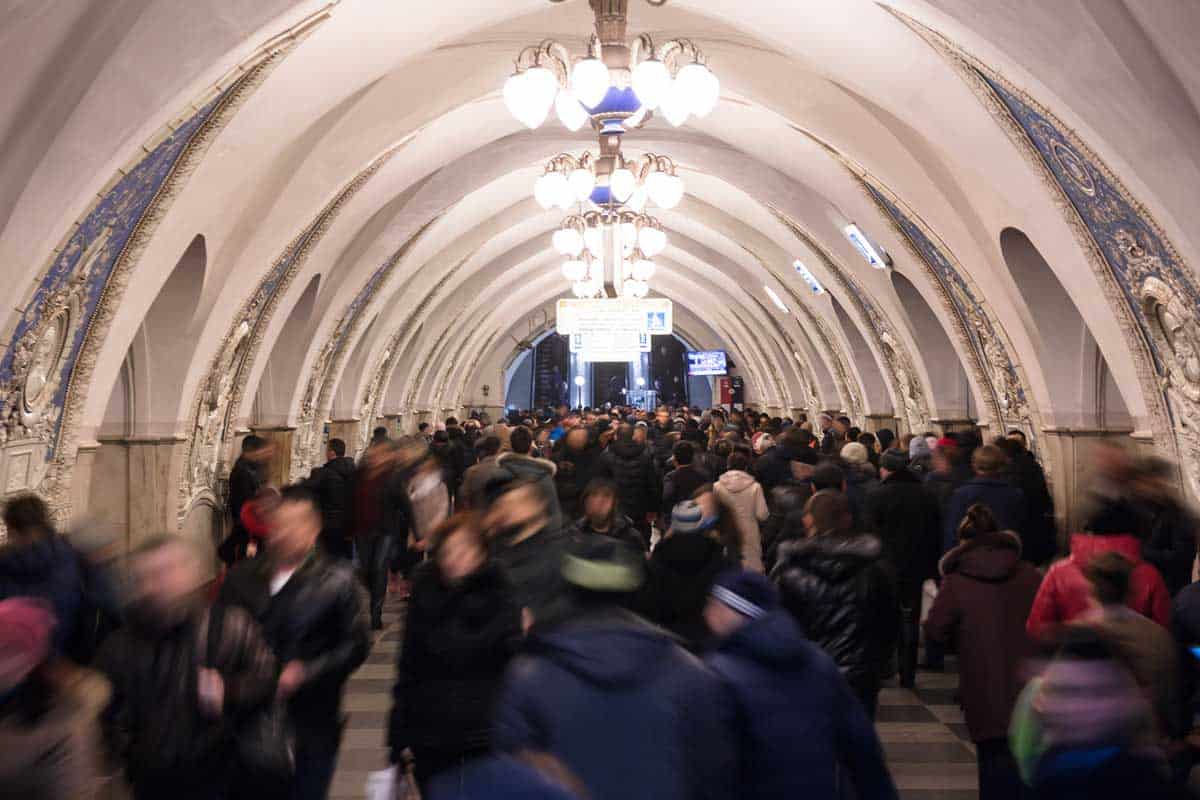
Post-war flamboyance is at the forefront of the design based on traditional Russian motives.
The central feature of the station – 48 maiolica panels on each face each pylon with floral elements and bas-reliefs of various World War II Red Army and Navy servicemen.
The colour of the panels are balanced in such a way, those facing the central hall are on a soft blue background, while platform panels are monochromatic. Lit by 12 gilded chandeliers, Taganskaya is a very elegant station.
Between 1950 until 1958 it was the deepest station in the Moscow Metro.
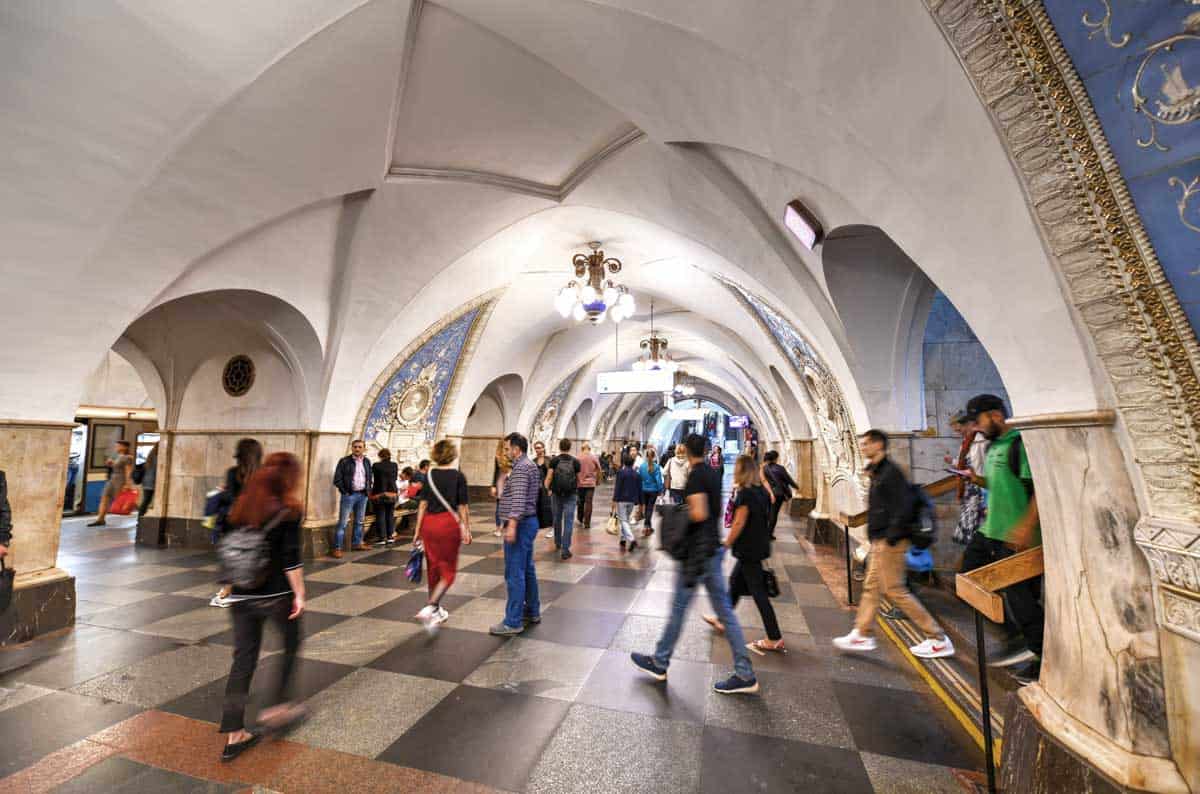
Komsomolskaya Station Line 5 Brown (Circle Line)
Komsomolskaya Station is on the Koltsevaya line – Line 5 . By far the fanciest of all the stations, Komsomolskaya is more like a grand ballroom than a train station. Opened in 1952 as part of the second stage Metro expansion, this baroque masterpiece honours the memory of Nevsky, Donskoy and other great military leaders in the ornately gilded mosaics on the ceilings and walls.
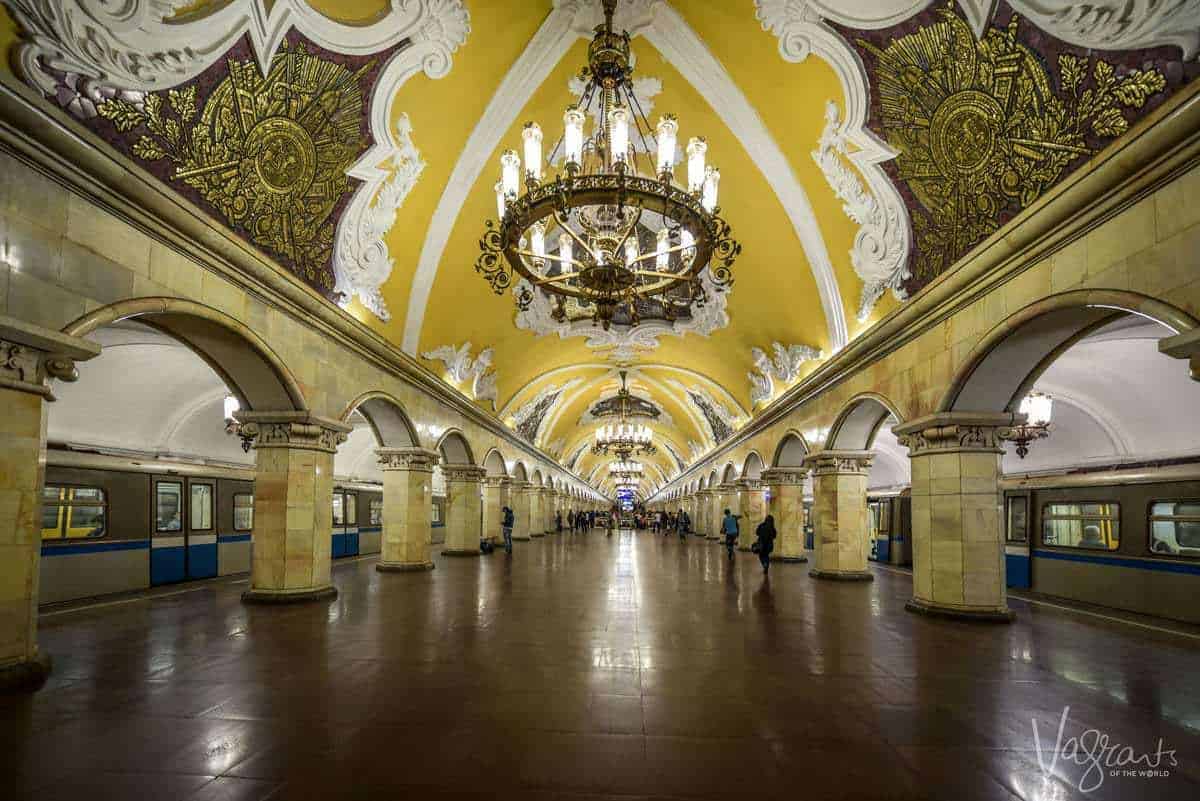
Prospect Mira Line 5 Brown (Circle Line)
Prospekt Mira station is on the Koltsevaya line – Line 5. Located on the central Circle Line, it’s easy to see why the incredibly ornate station is a favourite with visitors to Moscow.
Designed by architects Vladimir Gelfreykh and Mikhail Minkus, the station was initially named Botanichesky Sad after the Botanical Garden of Moscow and State University located nearby.
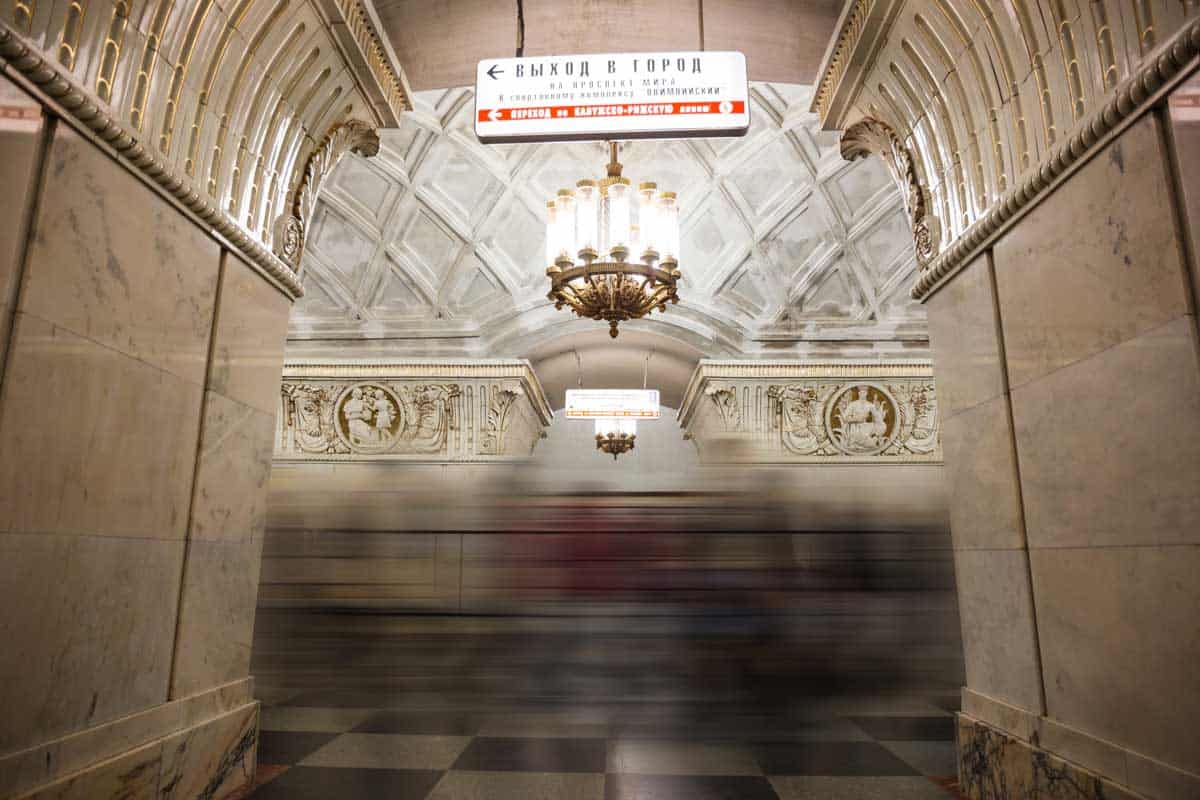
Opened in 1952, the station underwent significant modifications in 1958, removing a wall at the end of the station to make way for a transfer station on the Rizhskaya line. In 1966, both stations were renamed Prospekt Mira to avoid confusion.
The station’s design reflects the botanical influence of the original name in the intricate floral ceramic bas-reliefs trimmed in gold above flared marble arches. In the centre, medallion bas-reliefs depict aspects of agriculture in the Soviet Union. But the cylindrical crystal chandeliers add the finishing touch to the station’s grandeur, creating a magnificent ballroom atmosphere. The station was closed between 2015 and 2016 for complete restoration and remodelling works.
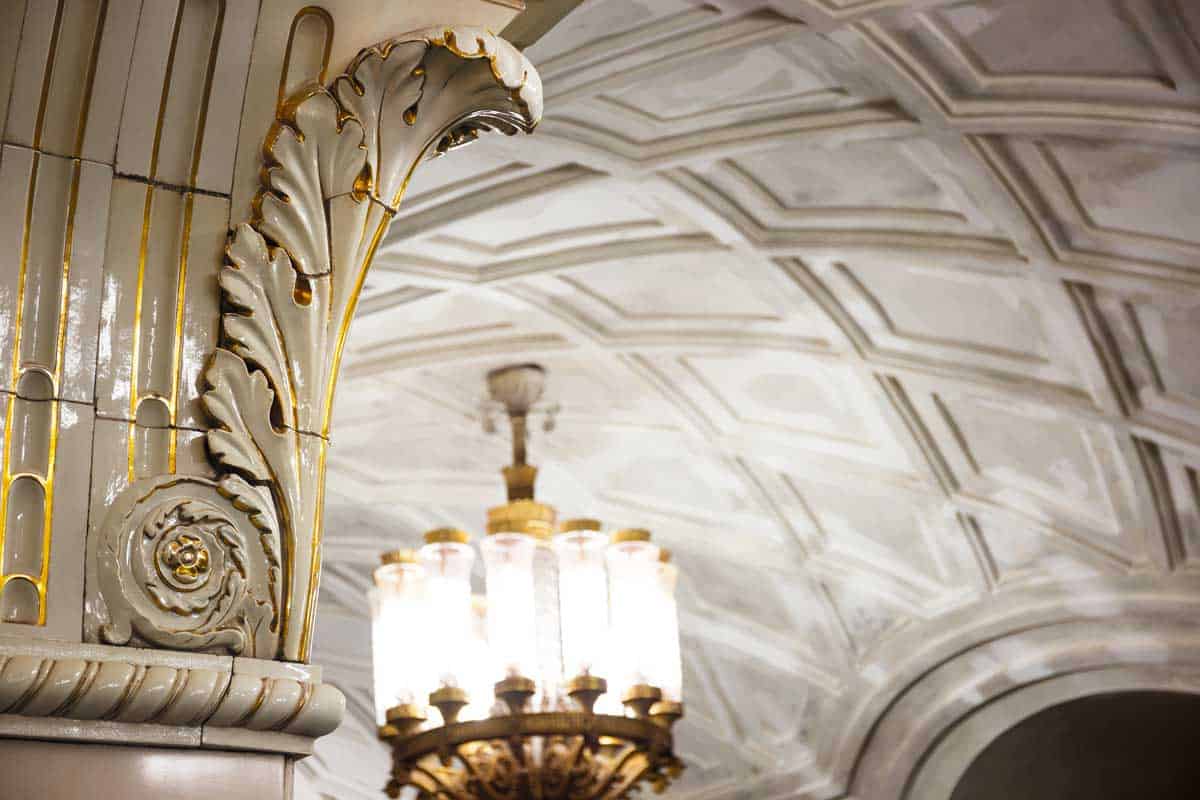
Novoslobodskaya Station Line 5 Brown (Circle Line)
Novoslobodskaya Station is on the Koltsevaya line – Line 5. Stain glass panels form the central theme for this station opened in 1952. Architect Alexey Dushkin had long wanted to utilise stain glass as the central feature of a metro station.
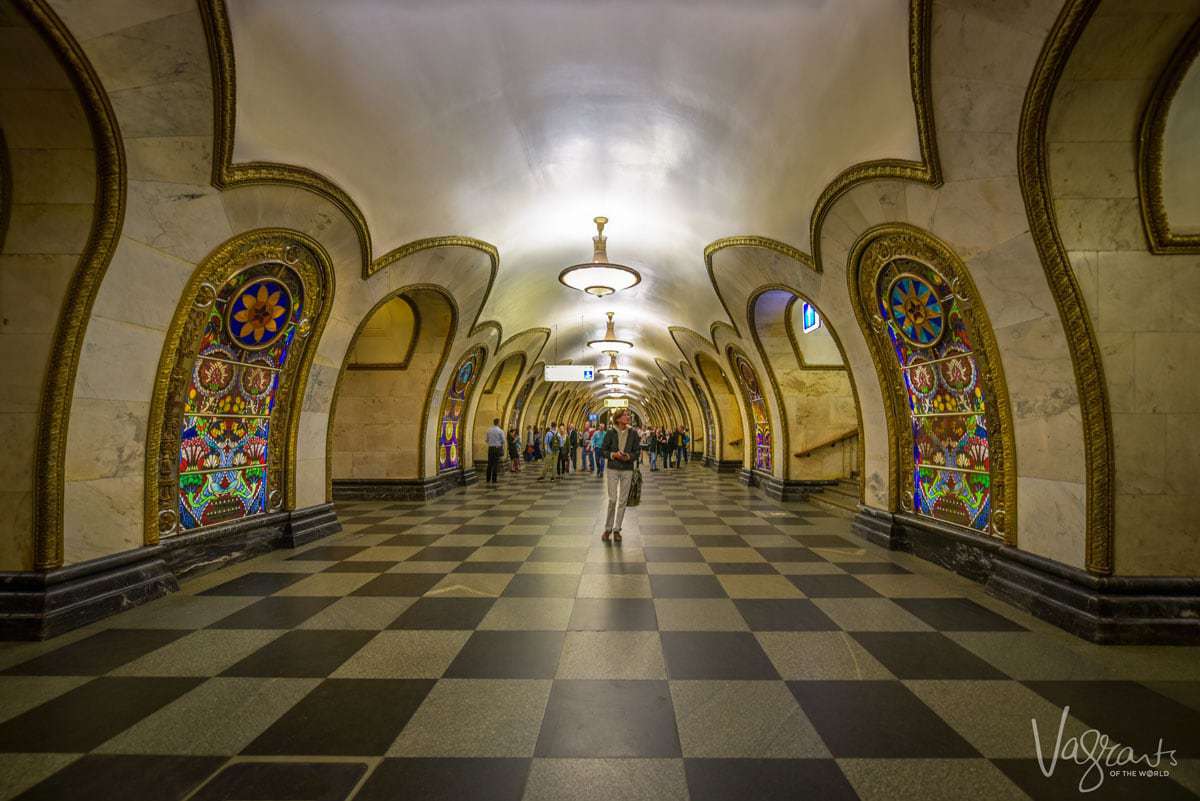
Dushkin persuaded a renowned artist, Pavel Korin to compose the artworks for the panels and the rest of the station was designed around the 32 stained glass panels, each surrounded by elaborate brass borders. The concept was to create the impression of an underground crypt.
Kievskaya Station Line 5 Brown (Circle Line)
Kievskaya Station is on the Koltsevaya Line, Line 5 Circle line. An open competition held in Ukraine for the design of Kievskaya Station attracted 73 entries.
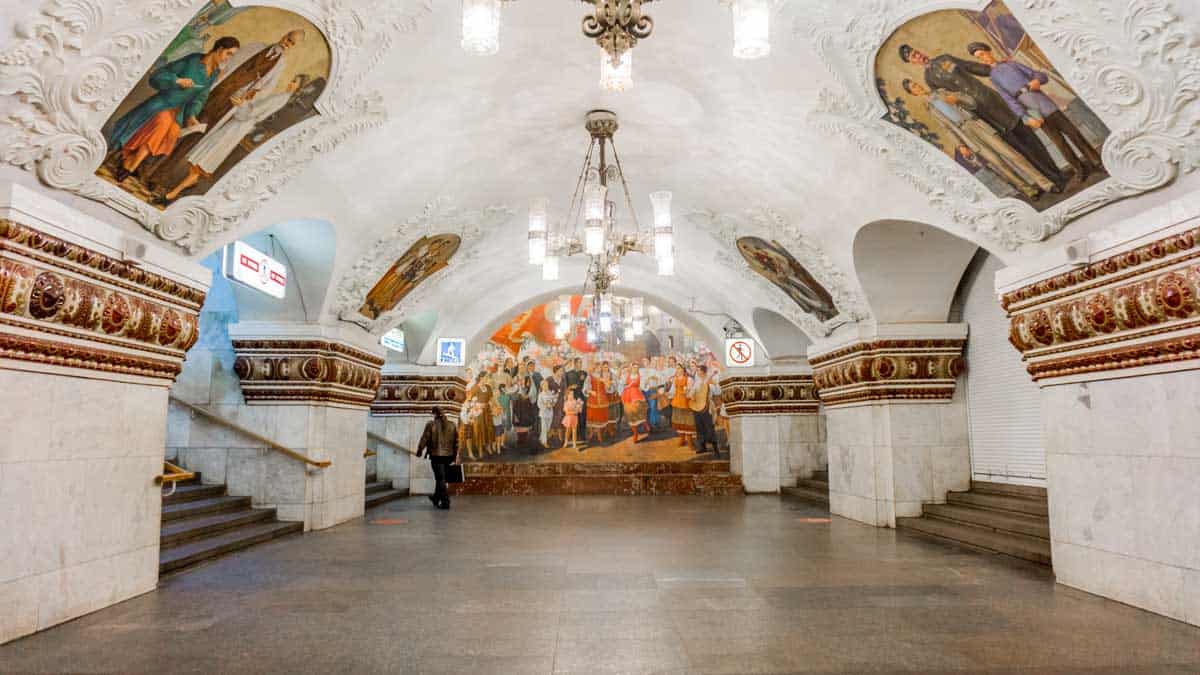
The winning team of E. I. Katonin, V. K. Skugarev, and G. E. Golubev focused the station’s theme on the Russo-Ukrainian unity from the time of Pereyaslav Rada in 1654 to the October Revolution in 1917, evident in the large, bright mosaics throughout the station and the portrait of Lenin in the main hall. The station is a true monument to the Soviet era and Soviet Russia.
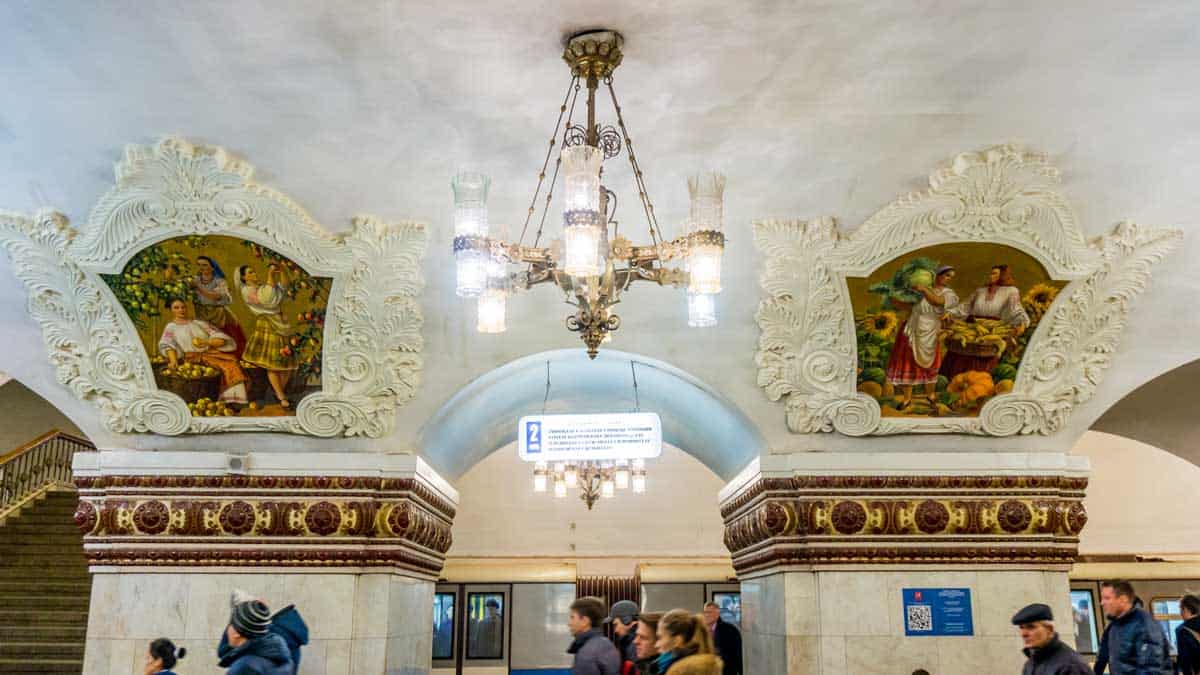
Stark white granite and marble arches accented with gold flourishes lit by central chandeliers against the bold mosaics is almost overwhelmingly elaborate.
One of the station’s entrances features a reproduction classic Art Nouveau Paris Metro entrance by Hector Guimard . The entrance was given to the Moscow Metro by the Régie Autonome des Transports Parisiens in exchange for a piece by Russian artist Ivan Lubennikov installed at Madeleine station in Paris.
Aviamotornaya Station Line 8 Yellow
Aviamotornaya Station is on the Kalininsko–Solntsevskaya line – Line 8. A tribute to Russian aviation, Aviamotornaya Station’s design is entirely in the spirit of flying.
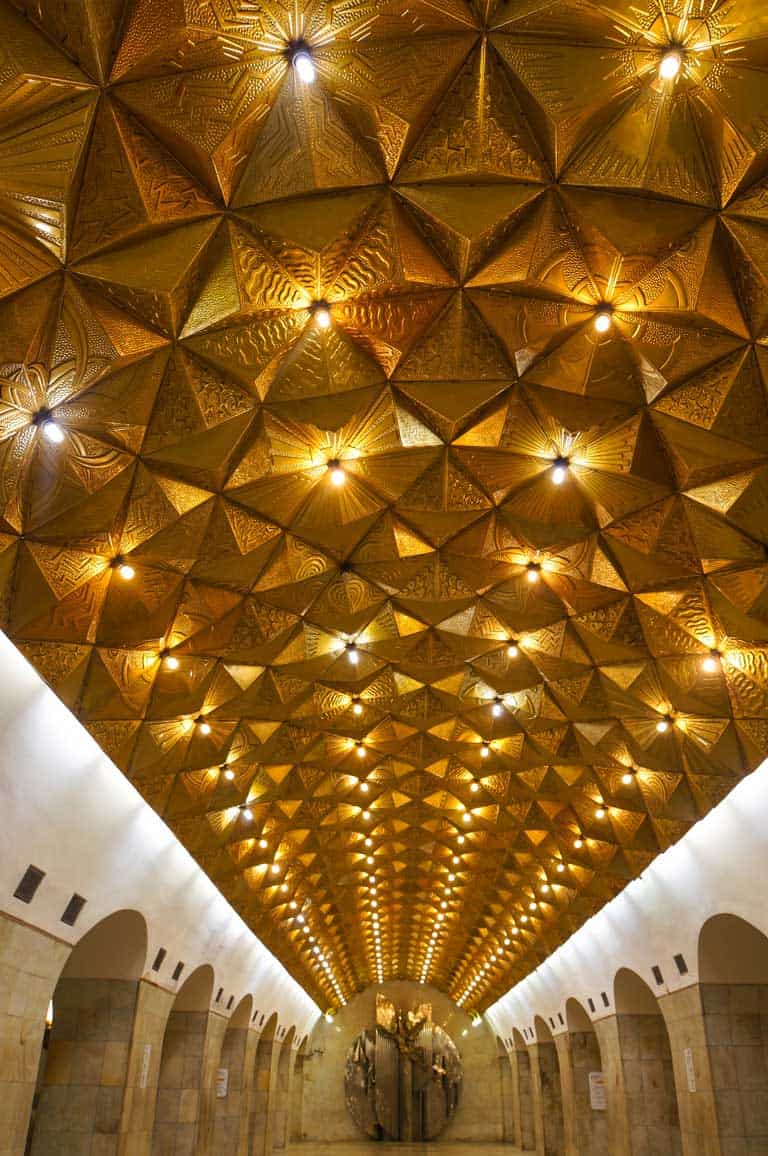
The most striking feature of the station is the ceiling in the central hall covered with four-sided anodised gold pyramids depicting the universe. At the end of the impressive foyer, an imposing metal sculpture depicting the flight of Icarus. An ode to the lives of aviators and inventors lost in the pursuit of flight.
The lighting on the platforms gives commuters the sense of movement and flying with the impression of an aeroplane jet streams and triangular lighting to represent an aeroplane tail wing.
Located 53 metres (173 feet) underground, the beautiful station was the location of a terrible escalator accident in 1982, causing the death of 8 people and injuring 30. You can read more about the incident here .
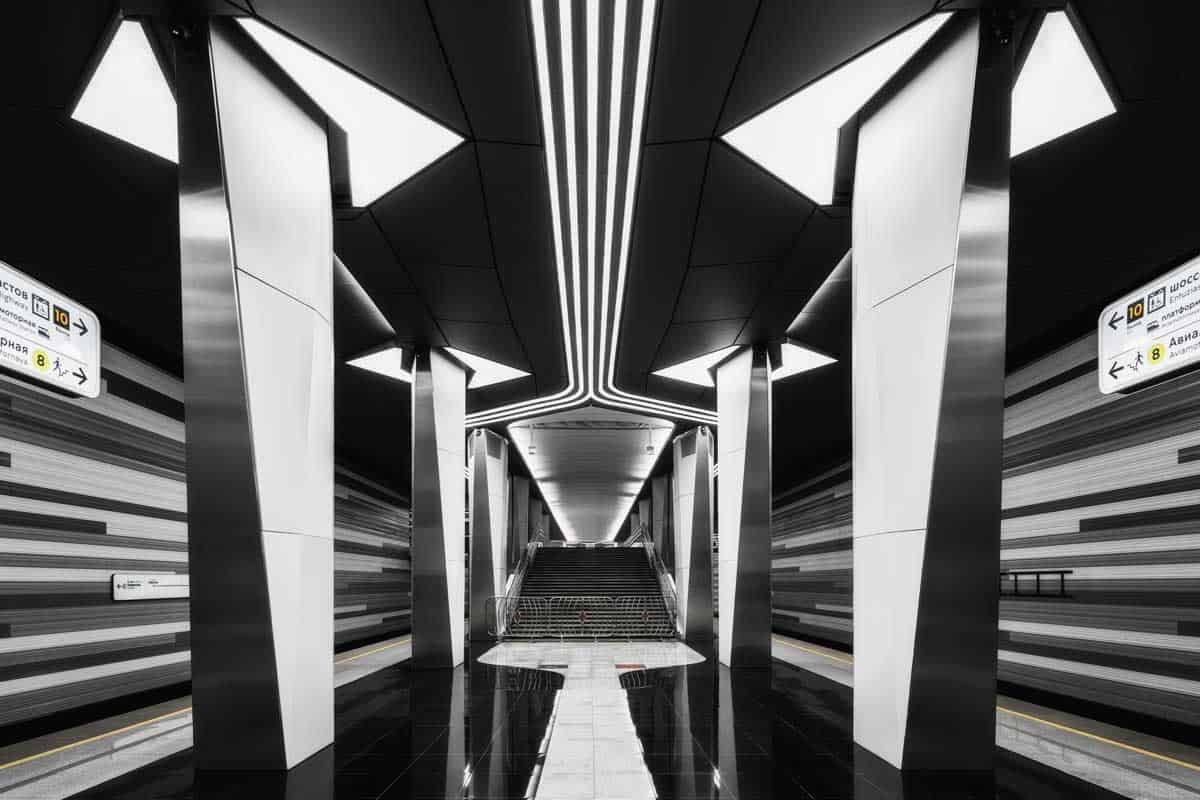
Dostoyevskaya Station (Dostoevsky) Line 10 Light Green
Dostoyevskaya Station is on the Lyublinsko-Dmitrovskaya line – Line 10. A Moscow Metro station for die-hard literary fans.
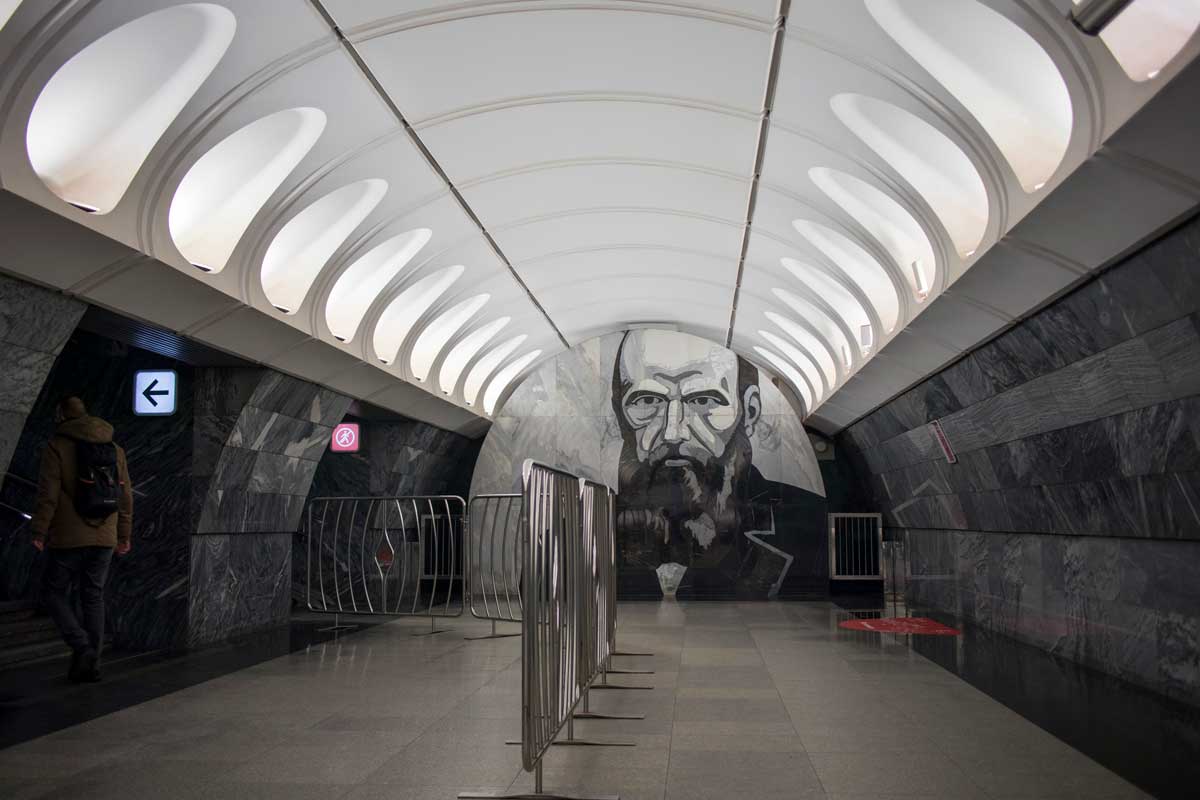
A bid to honour one of Russia’s most celebrated writers and greatest thinks has been shrouded in controversy from the get-go. Opened in 2010, named after the famous author Fyodor Dostoyevsky, the station is beautifully stark with bare grey walls except for colourless murals depicting scenes from Dostoevsky’s most famous novels, including Brothers Karamazov, The Idiot, and, Crime and Punishment.
The controversy started when elements of the station’s design were published online. Two scenes of violence, including scenes of homicide and suicide depicted on the station walls, sparked debates within the internet community. Psychologists expressed concern about the dark murals saying the violent scenes from Dostoevsky’s books could put commuters in equally dark moods or even provoke suicidal impulses.
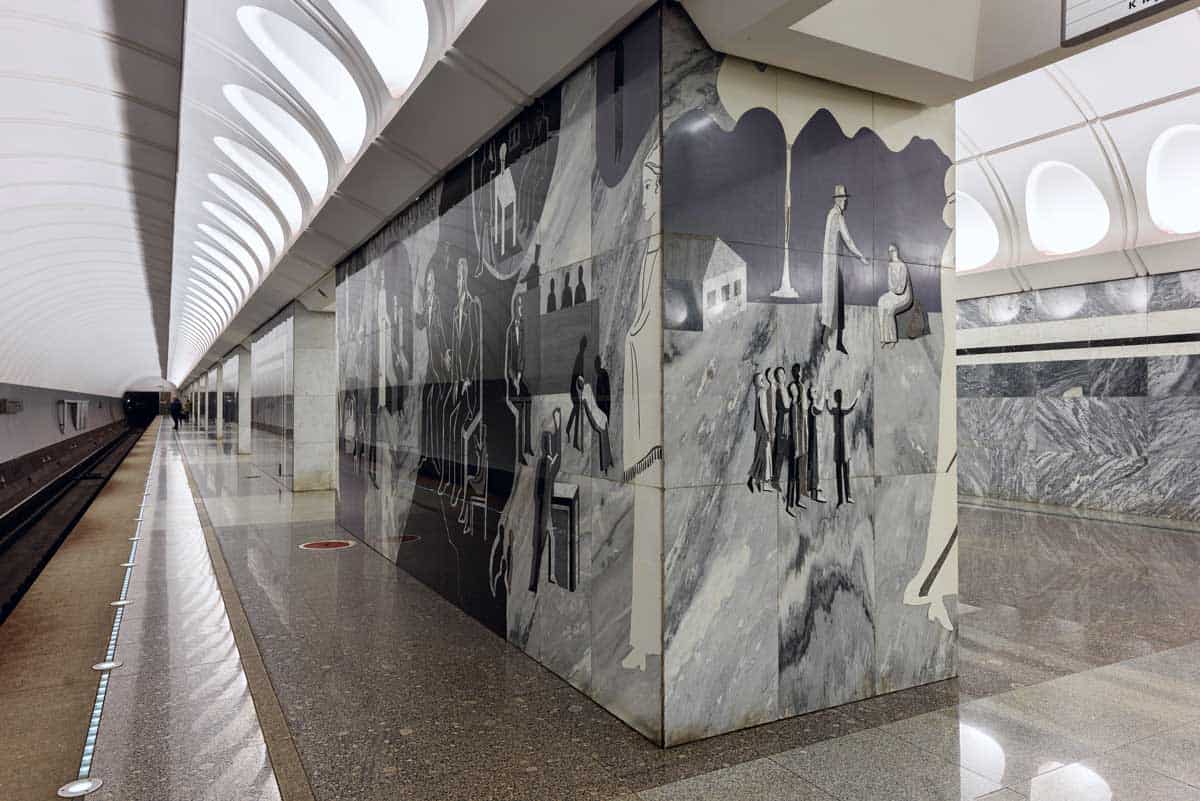
The beautifully stark station caused controversy on its opening in 2010 after people objected to a mural depicting a murder scene, to which the artist responsible replied:
Ivan Nikolayev, 69, the artist commissioned to create the murals, spent 20 years rereading Dostoevsky’s books and making sketches for the project. In response to the controversial reactions to the station’s works, the artist replied: “I was tasked to draw the meaning, creativity and entire life of Dostoevsky. “What did you want? Scenes of dancing? Dostoyevsky does not have them.”
More Moscow Metro Stations Worth Visiting
If you have time and want to see more interesting stations on the Moscow Metro, the following stations are worth your time for their unique design and architecture.
- Line 1 Red: Krasnye Vorota, Kropotkinskaya, Okhotny Ryad, Vorob’yevy Gory ( The only station located on a bridge across the Moscow River)
- Line 2 Green: Novokuznetskaya, Avtozavodskaya, Dinamo
- Line 5 Brown: Belorusskaya, Park Kultury
- Line 6 Yellow: VDNKh
- Line 7 Purple: Pushkinskaya, Kuznetskiy Mot, Spartak
- Line 9 Grey: Nagatinskaya
The Future of the Moscow Metro
So while Stalin’s initial vision of “People’s Palaces” may have waned somewhat during the peak Soviet Russia years where function was favoured over form, the concept of original and unique Metro stations never faded.
As Russia continues to expand its Metro system to become the third-largest in the world, the desire to create unique and beautiful spaces continues.
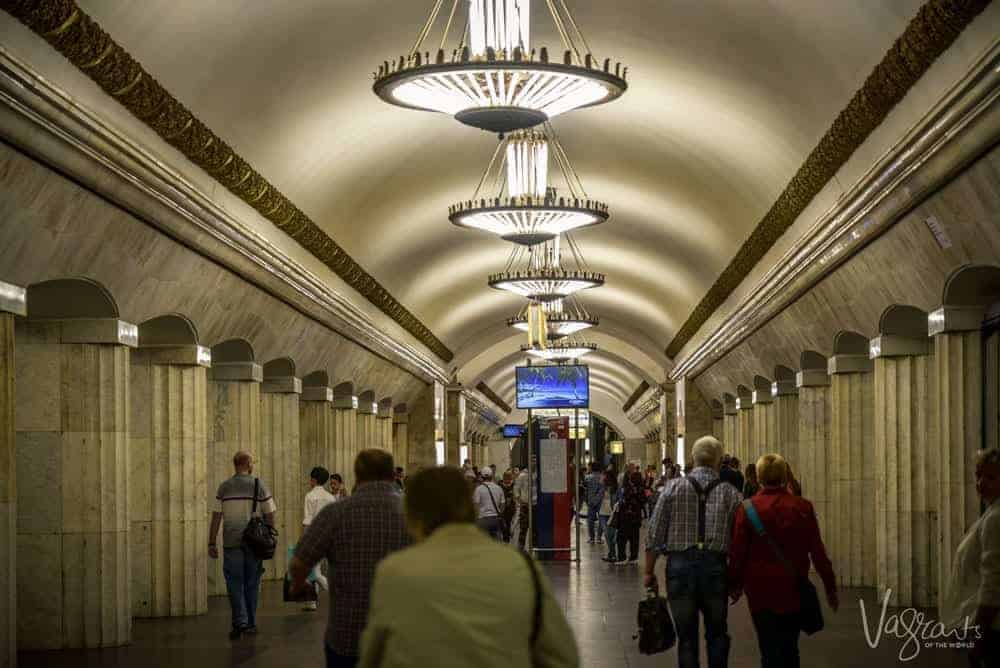
- South Africa
- Afghanistan
- North Korea
- Adventure + Outdoors
- Amusement Parks
- Backpacking Trips
- Boating + Cruises
- Budget Travel
- Bus + Train Travel
- Coasts + Islands
- Country Trips
- Fall Vacations
- Family Vacations
- Green Travel
- Heritage + History
- Honeymoons + Romance
- Inspiration + Guide
- Landmarks + Attractions
- LGBT Travel
- Markets + Bazaars
- National Parks + Reserves
- Nature + Wildlife
- Parks + Gardens
- Pets + Animals
- Photography
- Airlines + Airports
- Budgeting + Currency
- Business Travel
- Celebrity Travel
- Customs + Immigration
- Deals + Rewards
- Family Travel
- Hotels + Resorts
- Luggage + Packing Tips
- Offbeat News
- Photography Tips
- Responsible Travel
- Solo Travel
- Tech + Gear
- Travel Etiquette
- Travel Warnings
- Bars + Clubs
- Celebrity Chefs
- Restaurants + Cafés
- Wine + Vineyards
- Beach Hotels
- Boutique Hotels
- Hotel Openings
- Hotel Reviews
- Luxury Hotels
- Mountain + Ski Resorts
- Spa Resorts
- Vacation Rentals
- Asia Cruises
- European Cruises
- Festivals + Events
- Museums + Galleries
- Style + Design
- Travel’s Best
- Hotel with Agoda.com
- Hotel with Booking.com

Guide to Shenzhen nightlife — Top 5 things & what to…

Ladakh trip cost per person from Delhi — How much does…
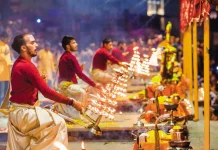
India travel tips — 25+ what & things to know before…

Must eat in Hong Kong — 7+ must eat & must…
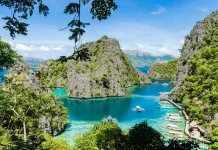
Coron itinerary 5 days — What to do & how to…

India trip tips — 9+ things to know before going to…

All about tips in Nepal — How much to tip in…

Cambodia travel tips — 15+ what to know & things to…

When is the best time to visit Kyoto? — The best,…

Must eat in Georgetown — 10+ famous, must-eat & best street…

Must eat in Melaka — 10+ famous Malacca street food &…

Hong Kong Soya sauce Chicken Rice and Noodles — The first…

Top hotels in Siem Reap — 8+ best places to stay…

Top hotels in shanghai — 15+ best hotels in Shanghai

Top hotels in Malacca — 10+ good & best hotels in…

Top places to stay in Bali — Top 10 best areas…

10 must-know things for your best first time European river cruise

Top 3 best luxury cruises in Halong Bay, Vietnam

Cherry blossom festival Korea 2024 — Top 5 cherry blossom festivals…

Ghibli museum blog — The fullest Ghibli museum guide for first-timers

Kyoto festival — Top 10 best events & most famous festivals…

National Palace Museum Taipei blog — What to see in National…

Japanese waterfall — Top 10 most beautiful waterfalls in Japan in…

19+ most beautiful towns in Europe every tourist need to visit…

Georgia travel photos — 20+ captivating photos show Georgia is heaven…

Explore Damnoen Floating Market — The oldest floating market of Thailand

Visiting Fenghuang Ancient Town — One of the most charming ancient…

Mekong Delta travel blog — Beyond rivers of Southwestern Vietnam

14 reasons why you should travel when you are young

Shigaraki Tanuki – An animal symbol of good luck in Japan

Living in the charms of cave houses in Andalucia, Southern Spain

20+ jaw-dropping tiny homes around the world
- Trip Inspiration
MRT Singapore for tourist & Public transport in Singapore for tourists — The cheapest & best way to get around Singapore
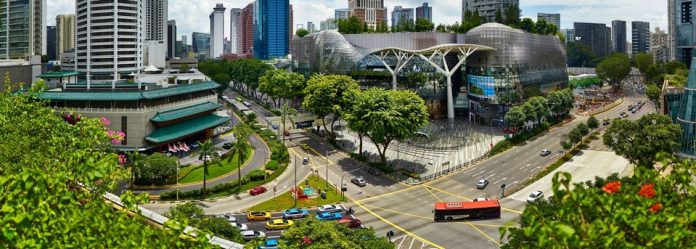
The majority of Singaporeans use the MRT transport system as their main means of transportation, because they are cheap, convenient and cover the whole city and are extremely rarely late, encouraged by the government again. In addition, there is another reason: the taxi price is high, especially the cost of owning a car in Singapore is extremely expensive, even Singaporeans with high income and wealthy people maybe unsure dare to buy a car. Singapore’s MRT system is extremely convenient, modern and covers almost the entire city. So, how to getting around Singapore? Let’s check it out our local transport in Singapore guide on how to use public transport in Singapore for tourists (transportation in Singapore for tourists) with the cheapest way to get around Singapore and the best way to get around Singapore including bus and MRT Singapore for tourist below.
- How to travel cheap in Singapore? — 3 best way on how to travel around Singapore & cheapest way to get around Singapore
- How to get around Singapore — 6 means of transportation in Singapore for tourists
- Singapore itinerary 5 days — How to spend 5 days in Singapore budget for the first-timers?
- Singapore travel blog — The fullest Singapore travel guide first-timers
- Where to shop in Orchard Road? — 10 best shopping malls in Orchard Road
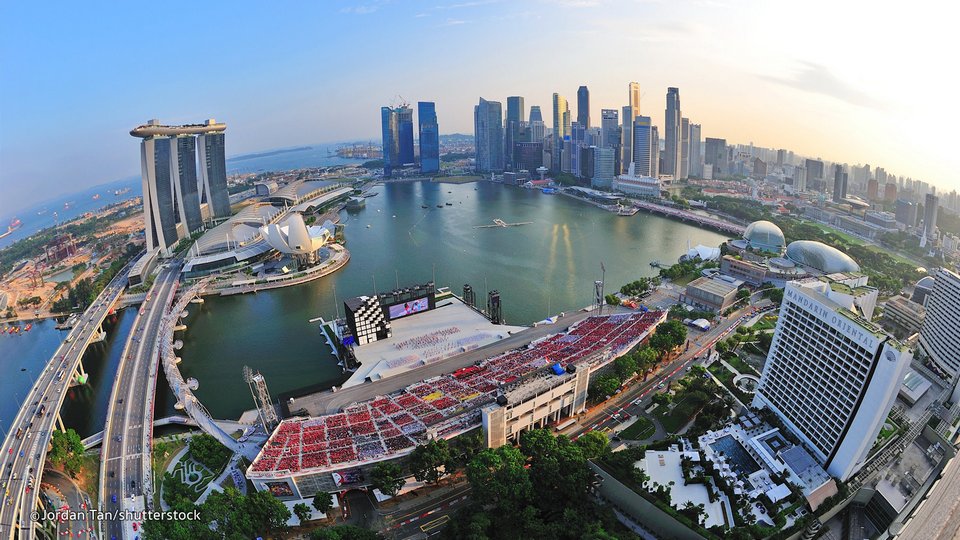
First, let’s talk about travel when you getting to central Singapore from Changi Airport. If you go to Singapore by bus from Malaysia, usually the bus company will take you straight to the city center, otherwise you will have to go to the border gate of Singapore – Malaysia is Woodlands station. From here you can take the bus or MRT into the city.
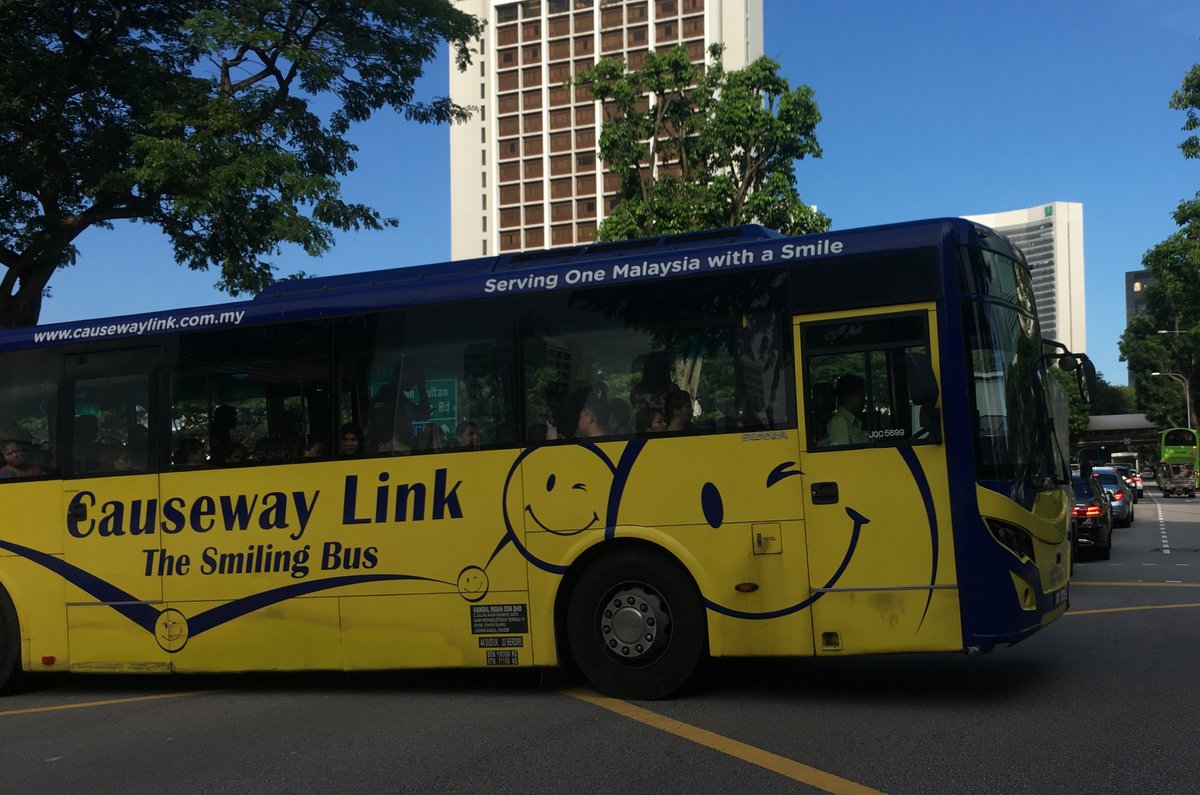
Public transport in Singapore for tourists: Getting from Changi Airport to City center and back
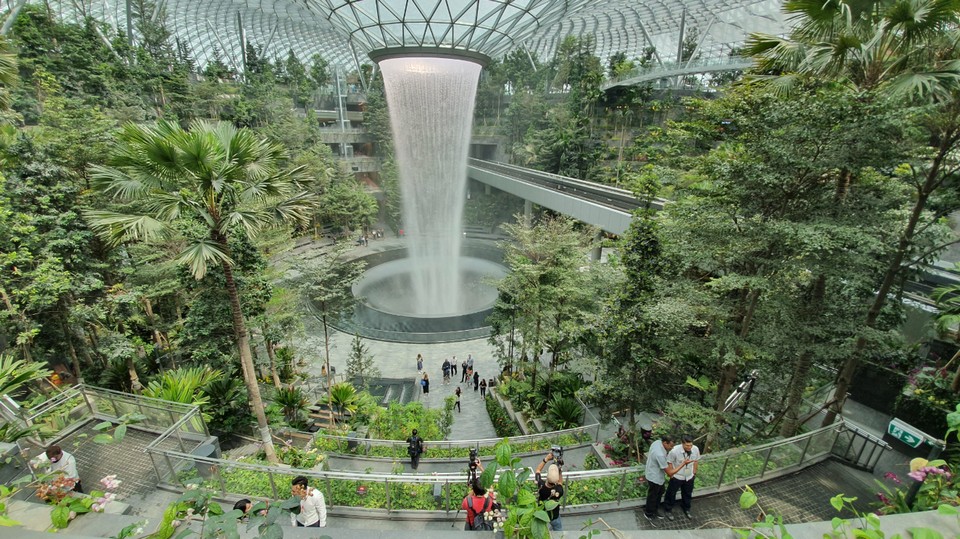
If you fly with low-cost airlines, you will arrive at Terminal 1 . Changi Airport is very large, including many different Terminals (terminals 1,2,3,4) and must be moved by skytrain between terminals. Before entry, you need to fill in the immigration declaration form issued by the flight attendants on the plane, or in the entry area. Once you have entered the country, follow the Skytrain to T2 instructions to pick up the free tram from T1 to T2, where the subway enters the city center.
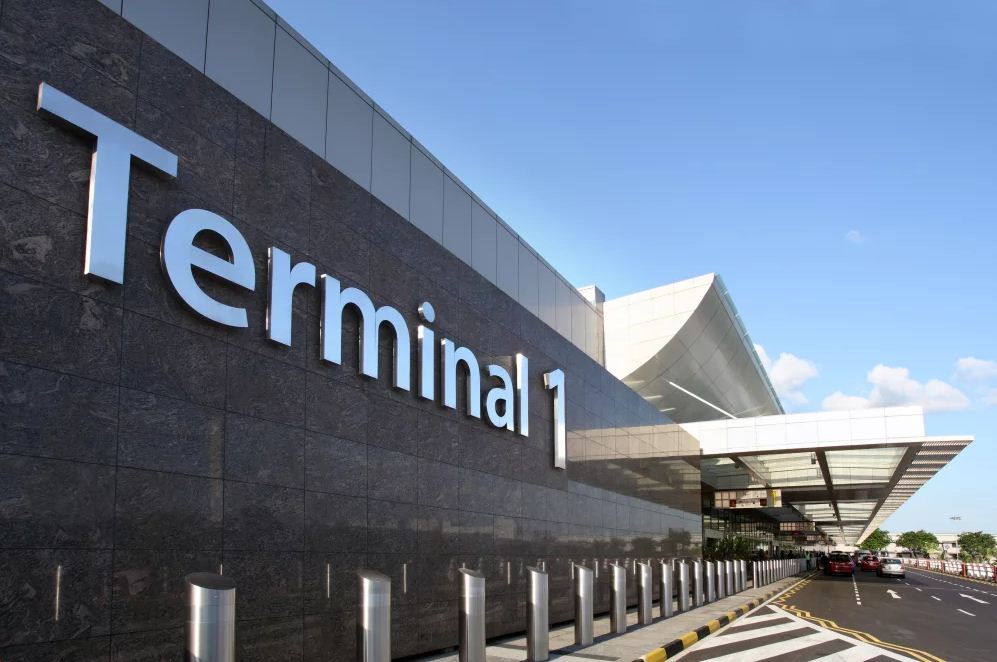
There are many means of transportation in Singapore such as MRT, bus and taxi and some other vehicles (You can refer here ) . But the cheapest and most convenient is still the MRT because it is a popular public transportation subsidized by the government, and taxis are very expensive. So, to getting to the city center you should use MRT, there will be an airport passenger service counter that selling EZLink card (Can be used for MRT, bus and monorail – a type of tram on Sentosa Island for SGD12 for 5 years and SGD7 in the account. You should buy this card because traveling by using the EZLink card will be much cheaper than going to single trip and paying for each trip, and it can be used to for bus by swiping the card at the card reader on bus. You can top up to the card at the automatic machines with the lowest denomination of SGD10.
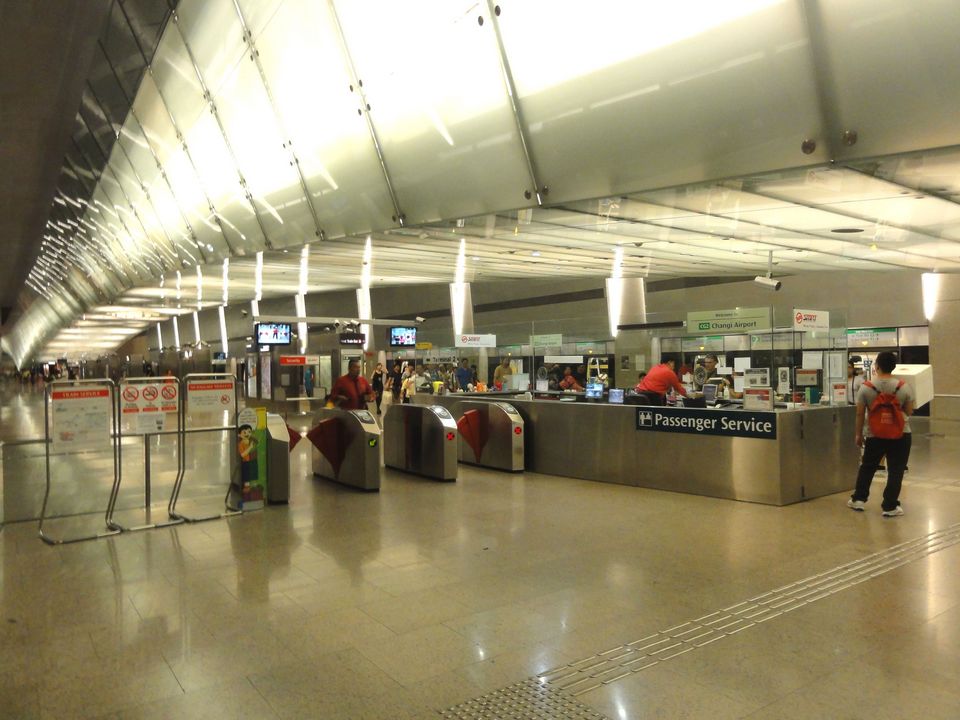
To get to central Singapore from Changi Airport MRT Station (Changi Airport CG2 MRT Station) , take the train to Tanah Merah MRT Station (EW4). Then, exit and catch the train to Joo Koon MRT station. Then, depending on where you stay, choose the train accordingly. The last MRT trip from Changi Airport at 11:18pm.

If you traveling from the city to the airport, you will also change trains at Tanah Merah MRT Station to get to Changi Airport, special pay attention for those who travel early in the morning and need to check your time carefully to avoid missed flight. From the city to the airport is quite far away (23.8km), travel time ranging from 30 to 60 minutes, the earliest train schedule of the day at 5:30am. In addition, you need to check exactly which airline you are going to fly to know the Terminal you will check in to see the instructions when you step out of the subway, because if you go to the wrong Terminal you will have to travel by SkyTrain which have to spend quite a lot of time, easy get frantic if you come to the airport late.
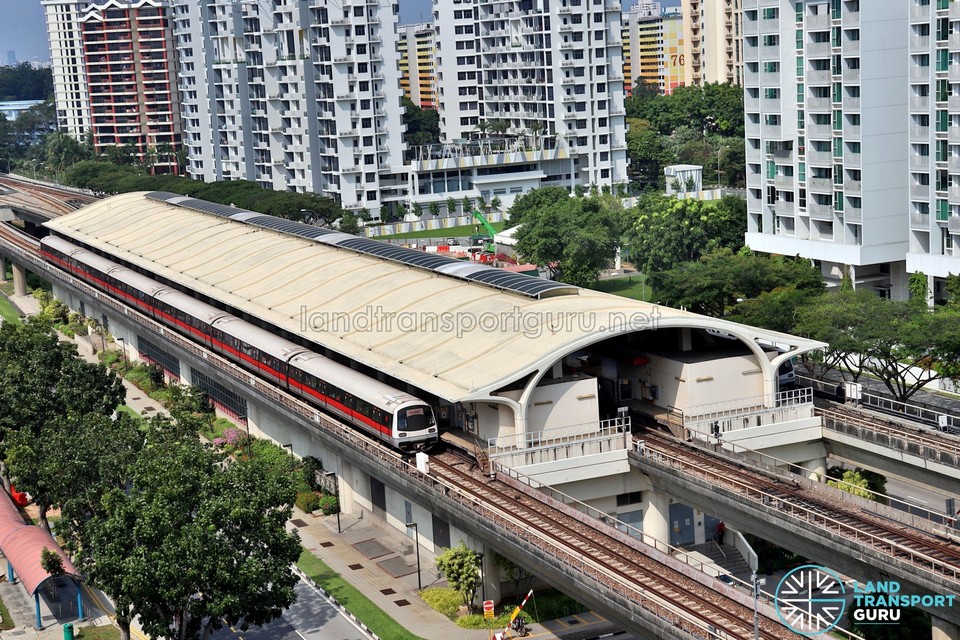
Outside the halls of Terminal 1,2,3 have buses to the city center, take bus number 36/36A running from 6:00am to midnight, the price for one way is about $2.5 and EZLink card can be used for payment. And the same for go back from the city to the airport.
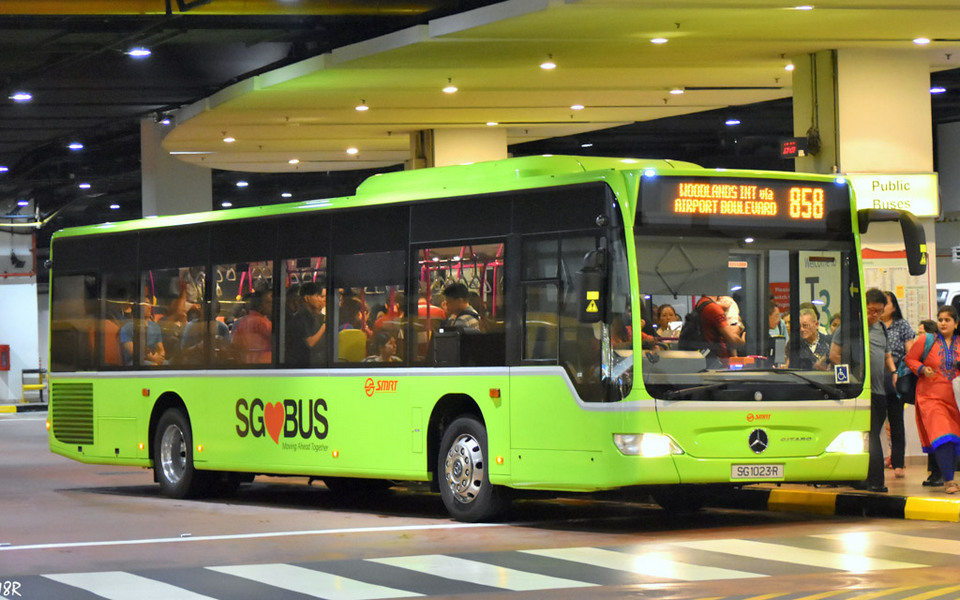
This is the fastest and also the most expensive means of transport in Singapore, from the airport to the city, the price ranging from $30 to $35, additional airport surcharge of $3, surcharge of $5 from 5.00pm to 12.00pm, extra 50% charge from 12.00pm to 6.00am, 25% peak hour surcharge from 6.00am-9.30am.
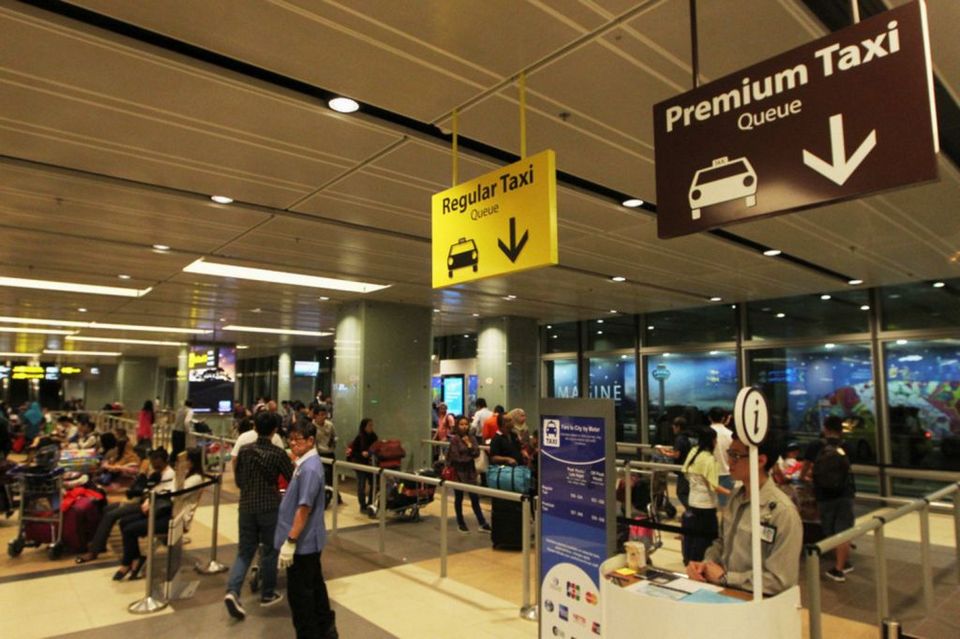
Bus & MRT singapore for tourist: Getting around in the city center
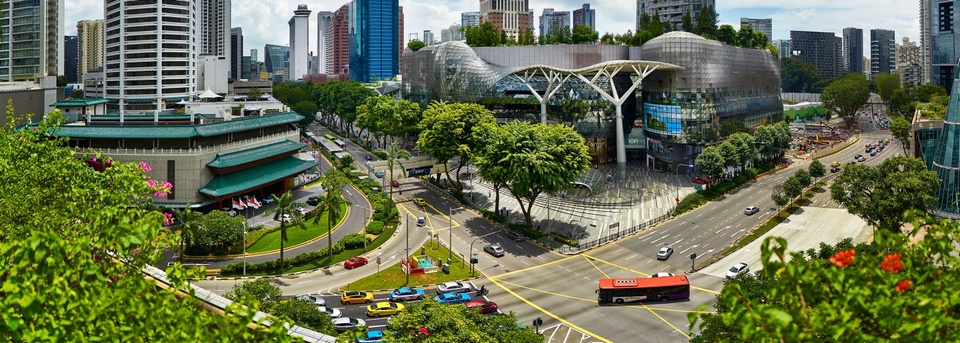
Before you go, you can see the bus stations and stop points on the map. Or when you arrive at the bus stop you should refer to the bus station’s instruction board to know the bus number, routes, and stations you need to get down.
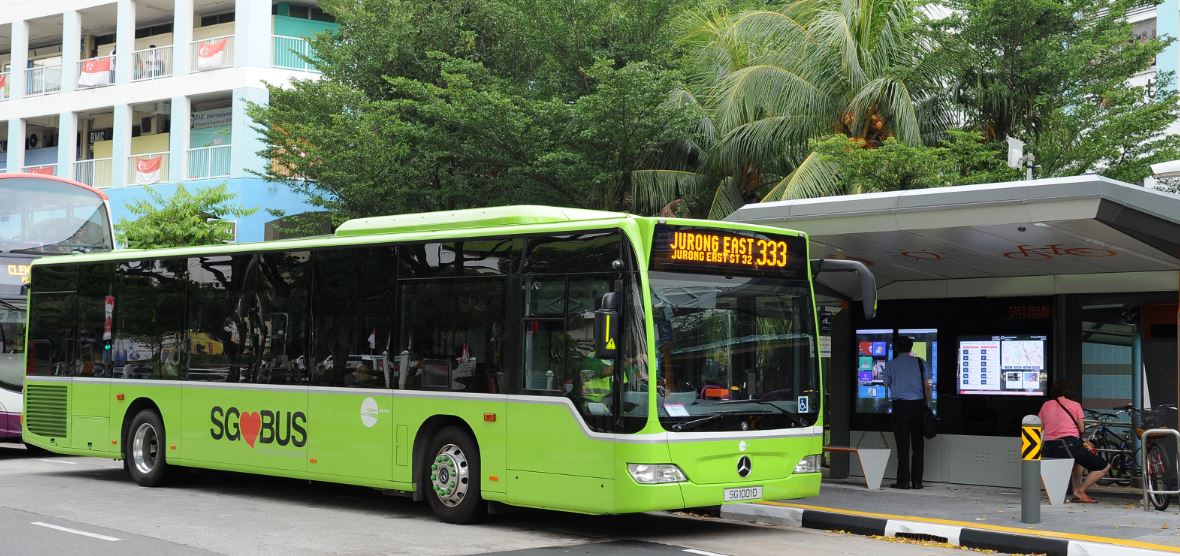
The Ez-link card is also can be used for both bus and MRT, so in addition to buying tickets directly on the bus you can use EZ-Link to pay, of course, the price will be cheaper than retail. When getting on or off the bus, you have to swipe the card at card reader on the bus. If you want to go down to a station, you also press the Stop button to let the driver know and open the door for you.
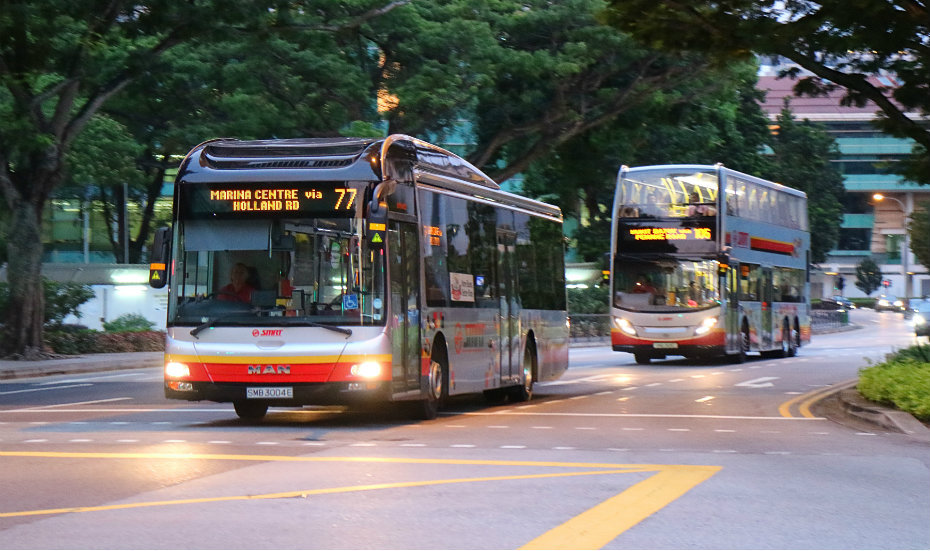
The subway in Singapore basically has 4 lines that are green, red, purple and yellow. The price will depend on the line you go, when you enter or exit the station you just need to swipe the EZ link card, the money will be automatically deducted from your card account. You need to save the map in smartphone from this link or get it right at the airport they have free delivery.
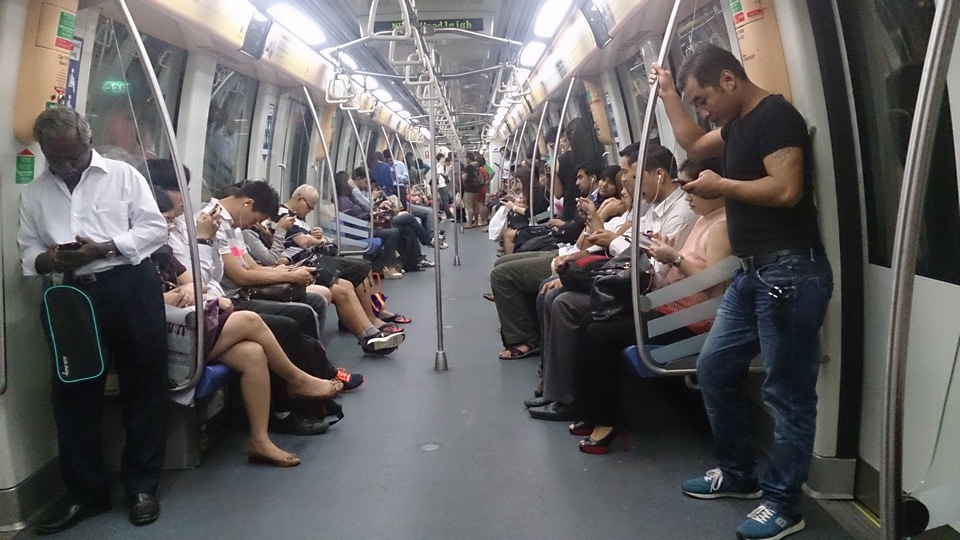
MRT fare for single trip
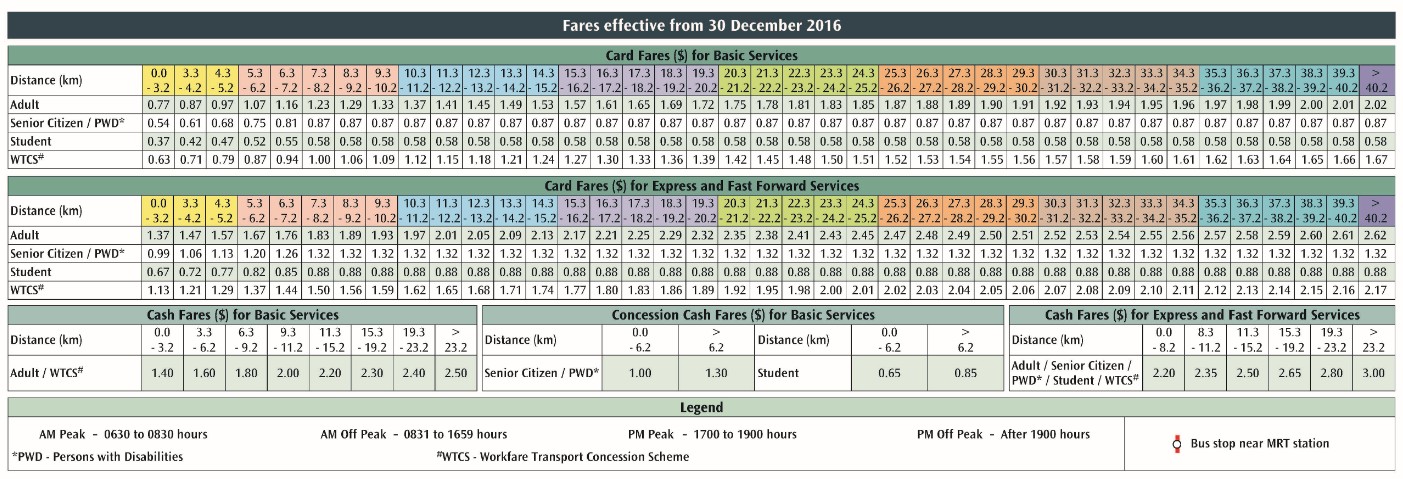
The bus fare is between $0.73 and $1.66 for single trip, and MRT is from $0.83 to $1.95 when using EZ-link card, depending on the length of your journey. To know exactly how much you have to pay when you going on any MRT trip, you can go here to see, it will tell you the amount and length you choose, including the fare from Changi Airport to any location in Singapore.
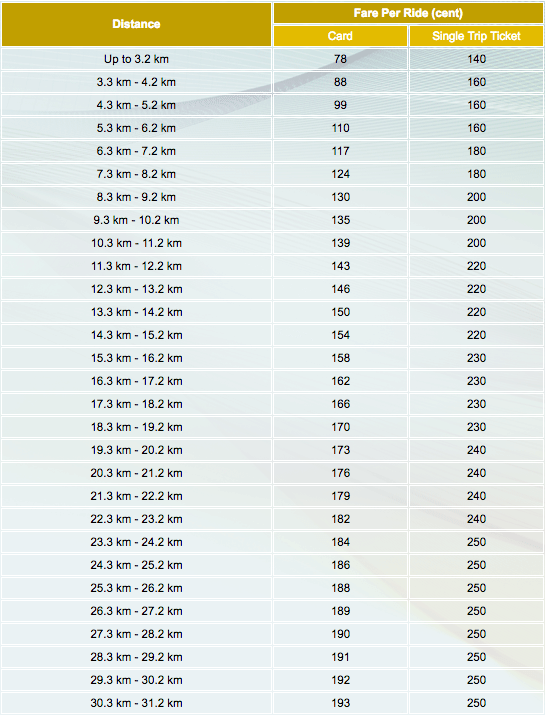
If you want to know how the calculation can be entered here , you will see the fare how different when using EZ link card and retail tickets. Normally, if you do not use EZ link card, the ticket price will be 1.5 times higher, so to save, you should not buy retail tickets because traveling in Singapore must use a lot of trains.
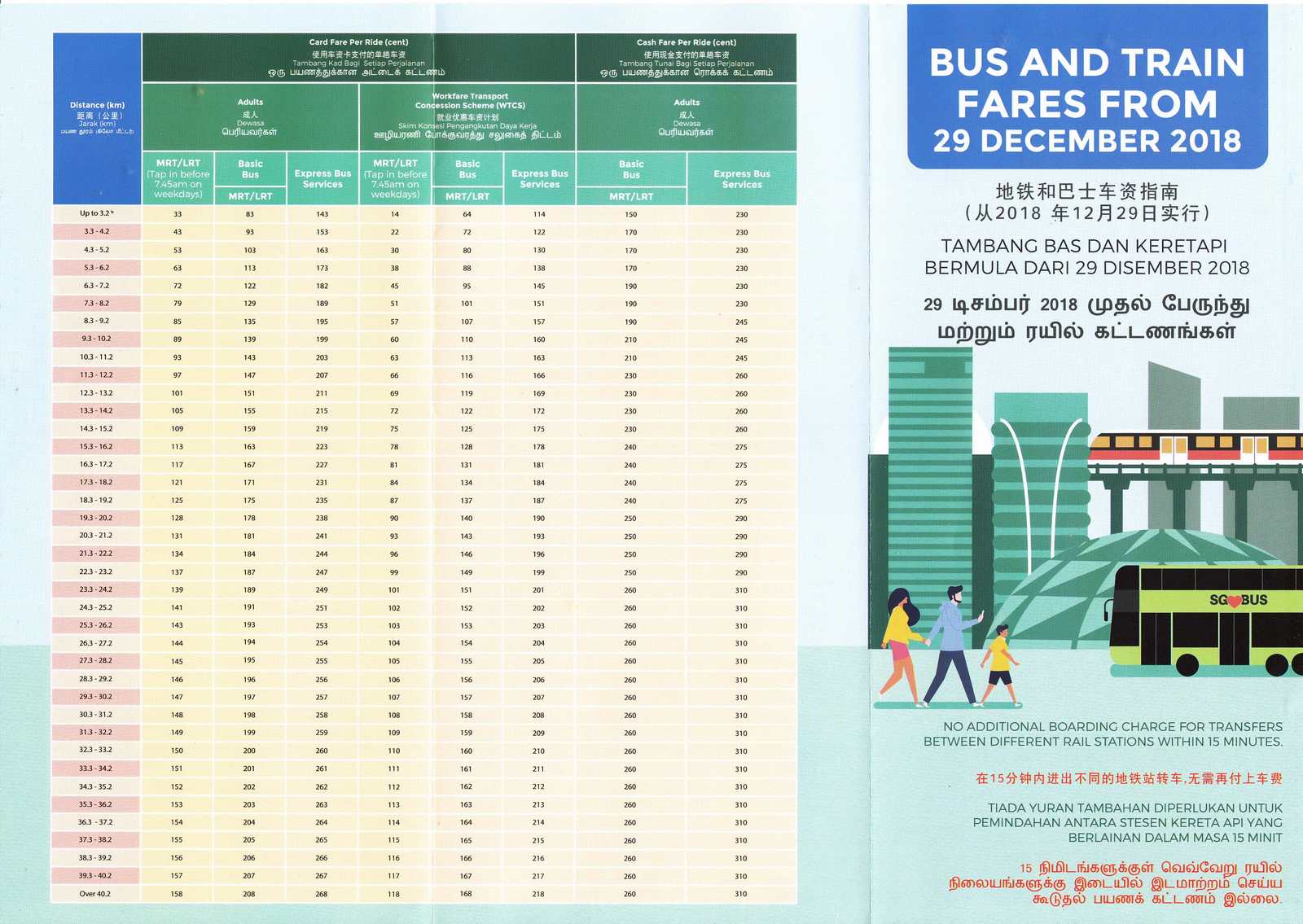
Should I buy Singapore Tourist Pass?

If you travel a lot by MRT in a day, you can buy Singapore Tourist Pass for unlimited travel within 1,2,3 days for $10, $16 and $20, which can be used with buses in the city. The Pass are sold at information booths right at the subway stations, you can preview the information about their working hours here. When buying a pass you will have to pay a deposit of $10 in advance, and will be refunded if you return it within 5 days of purchase.

The Singapore Tourist Pass is counted from the first time you use it, and it will be considered as the end of the day of the card at the end working of the public transport system that day, not counting full of 24 hours. For example, if you buy a Pass at 10.am, and use it to travel at 11.am until the end of the MRT train of that day (for example, 12.pm), it is still considered as the end of 1 day of the Pass. See more information here .
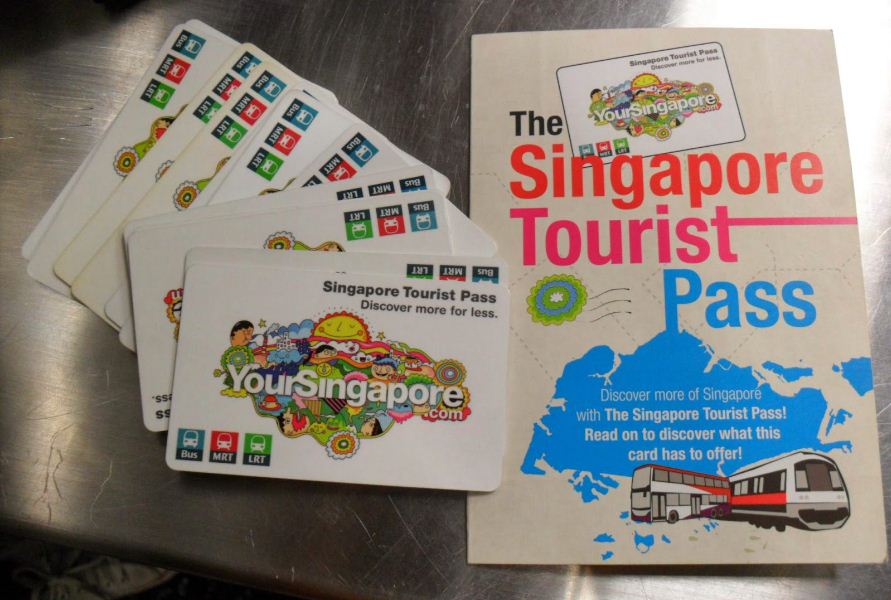
The main routes and MRT stations in the city
Looking at the map you notice some main routes as follows:
- Changi Airport (3): Take the MRT to the city.
- Woodlands (14): End point to take a bus to Malaysia and Beach Road if you take a bus to Malaysia where located the headquarters of the bus company.
- Other points: Chinatown (10), Little India : Go to Chinatown and Little India.
- Bayfront : Go to the sky garden (Garden by the bay) and Marina Bay (9) to reach the famous Marina Bay Sand.
- HarbourFront (6): The last point is the shopping mall, from here you can catch the Skytrain to Sentosa Island, or for those who take a ferry to Indonesia’s Batam also buy tickets and go from this port.
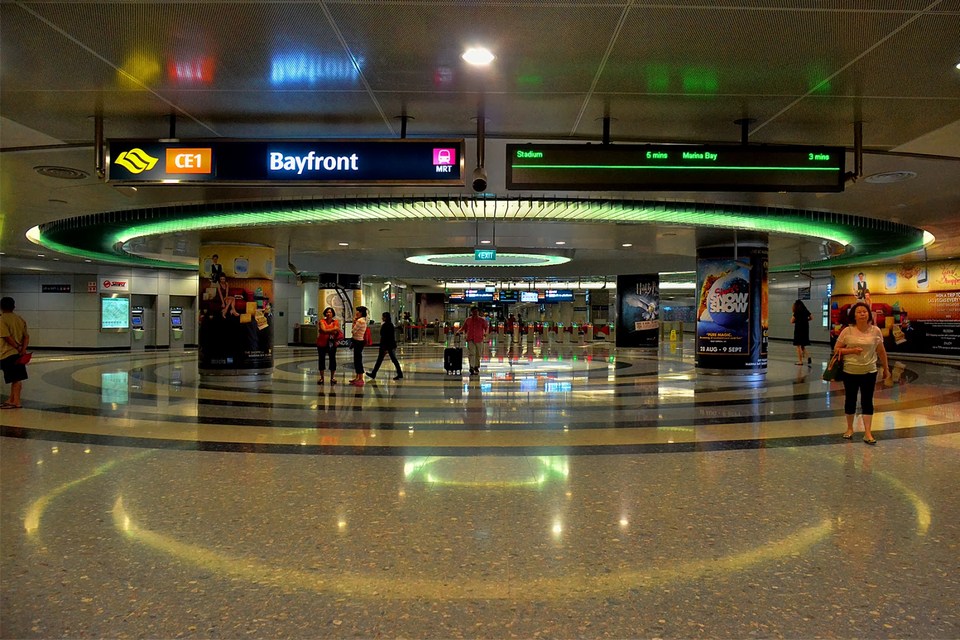
In addition, there is a feature that the names of Singapore’s metro stations are associated to the neighborhood there, so if you want to go anywhere you can easily find on the map, such as shopping areas like Orchard, City Hall, Bugis, Clarke Quay,… If you want to go to Interchange hubs on the map, you will have to pay attention to reading the instructions at these stations because these areas are quite complicated, you have to walk quite a long, climb up to multi-storey to change train.
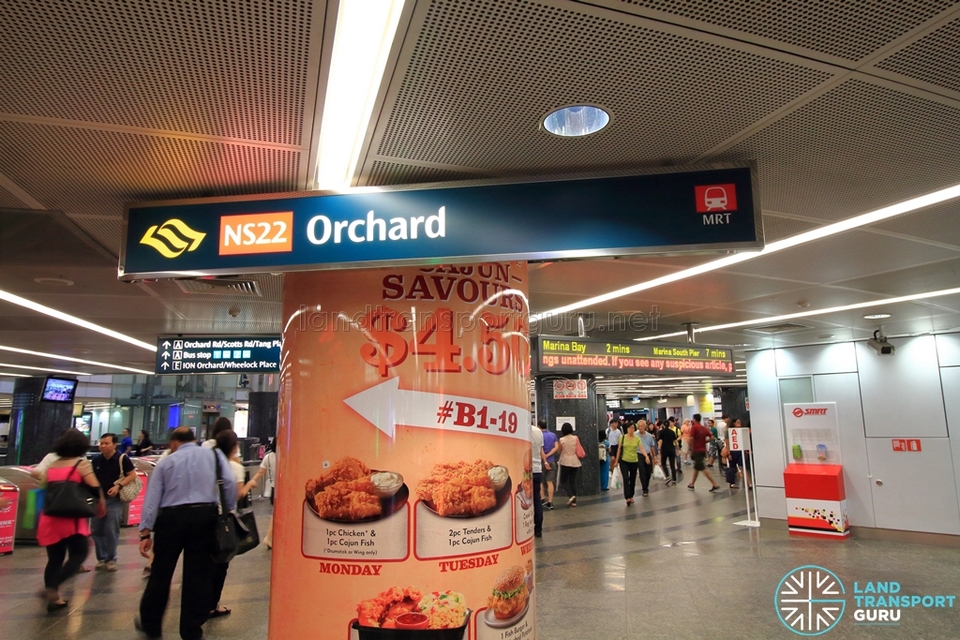
Some useful notes when traveling by MRT in Singapore
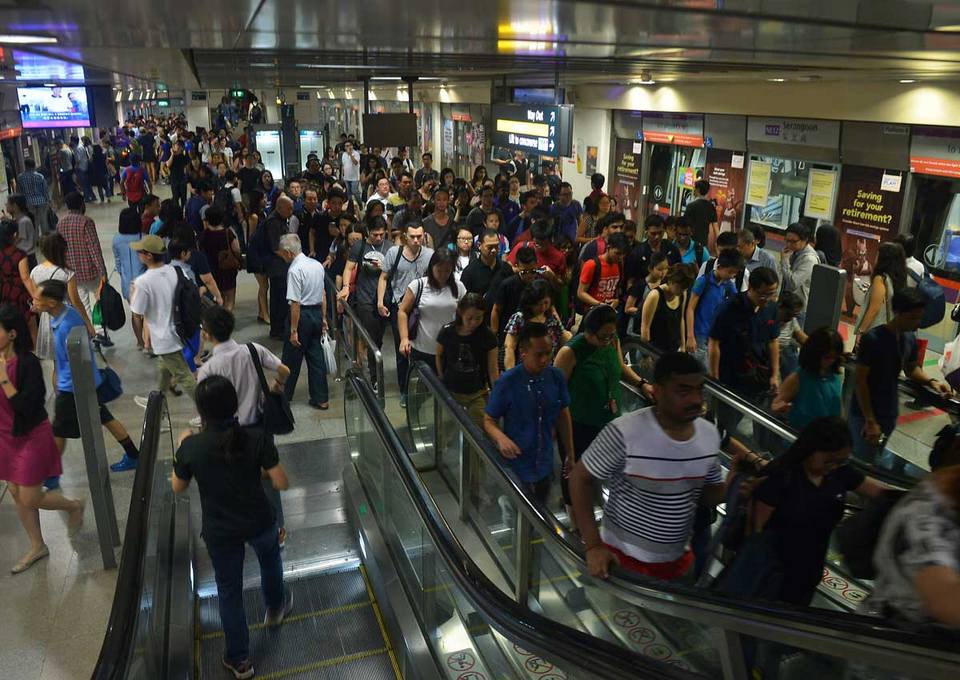
- Absolutely not eating or smoking in the MRT area, will be severely punished.
- Each train station usually has a large shopping center, so you can combine sightseeing and shopping very conveniently.
- When the train arrives, you need to stand at the edge of the yellow line to separate at each entrance of the train. After waiting for the people in the train to step out, you are allowed to board the train, which is the courtesy of all the people here.
- When you step on the elevator, you should stand on the left, giving way to those who are in a hurry and they will go on your right.
- The operation time of the train ends at 11pm and in the morning usually starts from 5-6am, you need to pay attention to avoid being missed when return late at night or having to leave early in the morning, especially to avoid being late to fly.
- MRT in Singapore are not so complicated, there are only a few interchange stations (intersection hub of train lines) that you will have to find with a bit more difficult because the area is usually very wide.
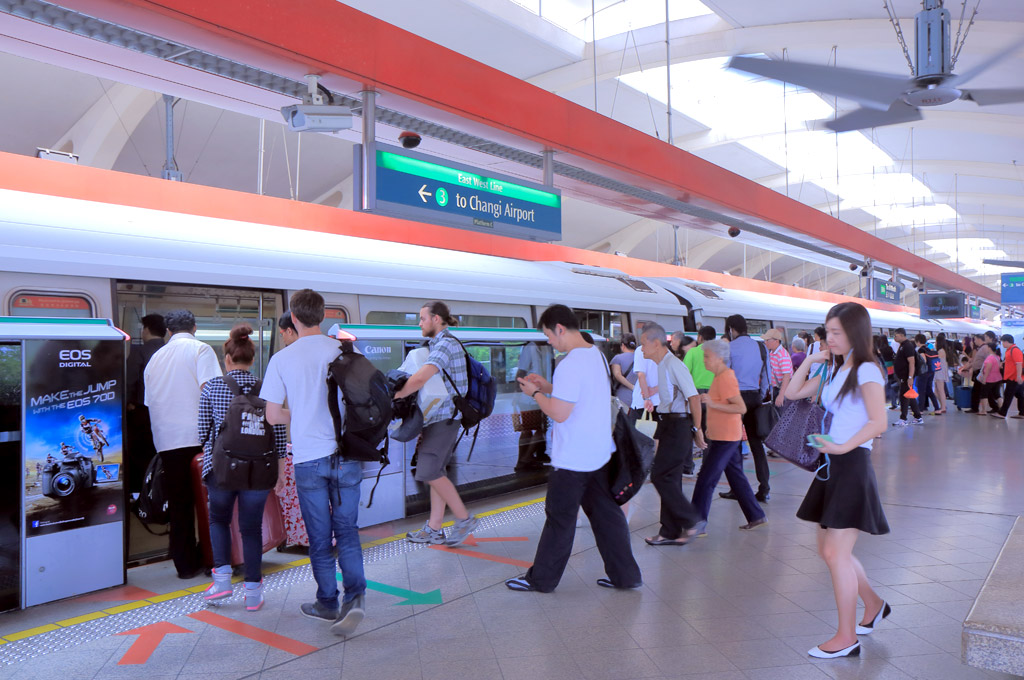
Some best day tours, trips, activities and transfer services, tickets in Singapore and from Singapore you can refer to
- Singapore Changi Airport (SIN) Private Transfer
- Private City Transfers between Singapore and Johor Bahru
- Shared Changi Airport Transfers (SIN) for Singapore Hotels
- Singapore All Day Pass
- The Singapore Pass
- [Klook Exclusive] 3 Hours Singapore City Tour
- Singapore Cityscapes Tour
- [Klook Exclusive] Sentosa Island Introductory Tour in Singapore
- Singapore Big Bus Hop-On Hop-Off Tour (Open-Top)
- Sentosa FUN Pass
- Singapore City Pass (2/3 Days)
- [Klook Exclusive] Universal Studios Singapore™ 1 Day Ticket
- 4G Prepaid Sim Card (Changi Airport Pick Up) for Singapore
- 4G WiFi (SG Airport Pick Up) for Singapore
- 4G Portable WiFi for Singapore from Uroaming
- 4G WiFi (SG Pick Up) for Europe
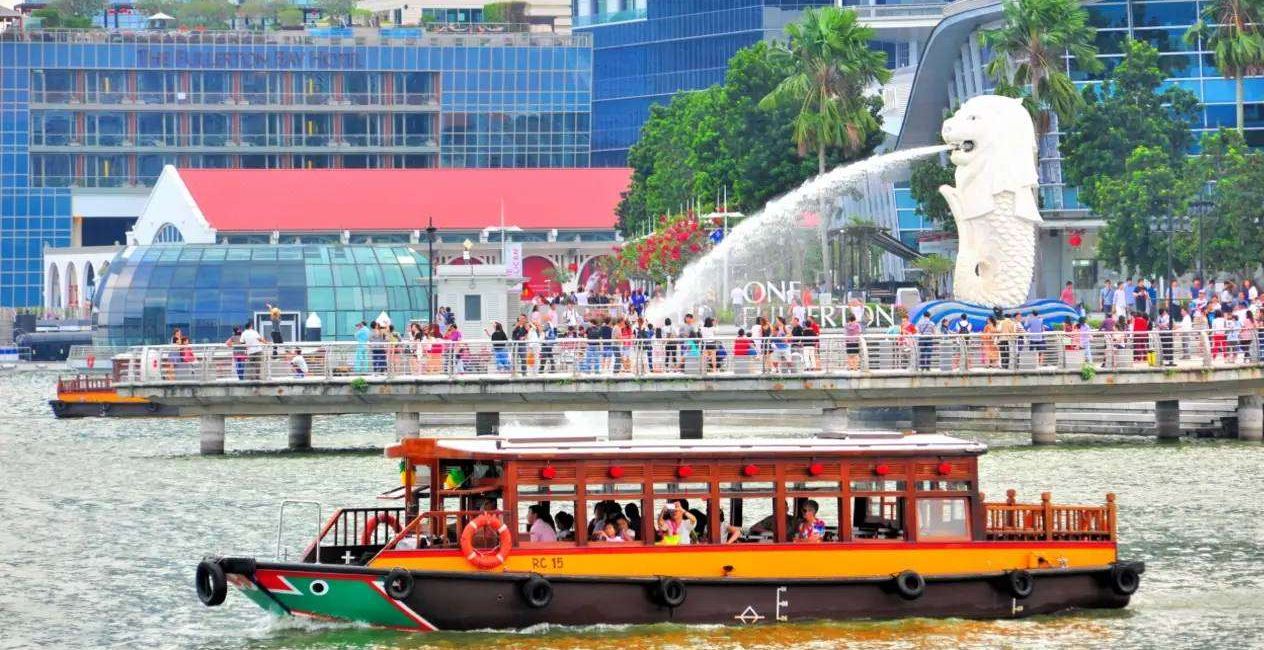
Are you finding more top things to do in Singapore: Tours, activities, attractions and other things? Read more: Singapore travel blog — The fullest Singapore travel guide blog for a budget trip to Singapore for the first-timers.
Related articles
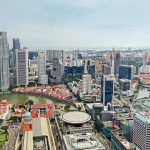
RELATED ARTICLES MORE FROM AUTHOR
Guide to shenzhen nightlife — top 5 things & what to do in shenzhen at night, ladakh trip cost per person from delhi — how much does ladakh trip by bike cost, india travel tips — 25+ what & things to know before traveling to india, coron itinerary 5 days — what to do & how to spend 5 days in coron.

Arashiyama travel blog — The fullest Arashiyama travel guide with top things to do in Arashiyama
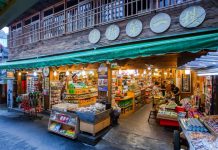
Explore Fenqihu old street — What to do in Fenqihu in a day trip?

Where to go in Kunming? — 15+ top Kunming attractions & best places to visit in Kunming
Must eat in melaka — 10+ famous malacca street food & must try food in melaka.
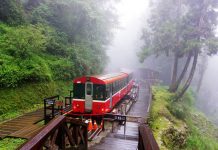
What to do in Alishan? — 5 top attractions & best things to do in Alishan, Taiwan
Editor picks.

Guide to Shenzhen nightlife — Top 5 things & what to...

Ladakh trip cost per person from Delhi — How much does...

India travel tips — 25+ what & things to know before...
Popular posts.

What to buy in USA? — 17+ must buy in USA...

Must buy souvenir in Taiwan — Top 17+ most famous, cheap...

Must buy in Korea — Top 23 cheap, famous & best...
Popular category.
- Inspiration + Guide 1459
- Trip Inspiration 468
- Thailand 209
- Food + Drink 208
- Coasts + Islands 193
- South Korea 168
- Vietnam 166
- Travel Photos 144
- Work for Us
- Terms & Conditions
- Privacy Policy
- Subscribe to our RSS Feed
- Follow us on Twitter
- Join our Facebook Group
- Quick Snapshot
- Information & Map
- Construction Updates
- Yellow Line (Line-2)
- Aqua Line (Line-3)
- Red Line (Line-7)
- Jaipur Metro Neo
- Nashik Metro Neo
- Warangal Metro Neo
- RRTS Overview
- Delhi – Meerut Line
- Delhi – Alwar Line
- Delhi – Panipat Line
- Hyderabad Airport Express Line
- Construction Update
- Mumbai – Ahmedabad HSR
- Delhi – Varanasi HSR
- Delhi – Ahmedabad HSR
- Delhi – Amritsar HSR
- Mumbai – Nagpur HSR
- Mumbai – Hyderabad HSR
- Chennai – Mysore HSR
- Varanasi – Howrah HSR
- Contract News
- Agra – Gwalior Expressway
- Amritsar – Bathinda Expressway
- Delhi – Amritsar – Katra Expressway
- Delhi – Dehradun Expressway
- Delhi – Jaipur Super Expressway
- Delhi – Meerut Expressway
- Delhi – Mumbai Expressway
- Delhi UER 2 Expressway
- Dwarka Expressway
- Ludhiana – Bathinda Expressway
- Ludhiana – Rupnagar Expressway
- Sirhind – Sehna Expressway
- Sohna Elevated Road
- Trans-Haryana Expressway
- Ballia Link Expressway
- Bareilly – Gorakhpur Expressway
- Bundelkhand Expressway
- Ganga Expressway
- Gorakhpur Link Expressway
- Kanpur – Lucknow Expressway
- Kanpur Outer Ring Road
- Purvanchal Expressway
- Bangalore – Chennai Expressway
- Bangalore Peripheral Ring Road
- Bangalore Satellite Town Ring Road
- Bangalore – Mysore Expressway
- Bangalore – Pune Expressway
- Bangalore – Vijayawada Expressway
- Chennai Peripheral Ring Road
- Chennai Port – Maduravoyal Expressway
- Chennai – Salem Expressway
- Chennai – Surat Expressway
- Chittoor – Thatchur Expressway
- Coimbatore – Karur Expressway
- Hyderabad Regional Ring Road
- Khammam – Devarapalli Expressway
- Thiruvananthapuram Outer Ring Road
- Amas – Darbhanga Expressway
- Buxar – Bhagalpur Expressway
- Durg – Arang Expressway
- Gorakhpur – Siliguri Expressway
- Odisha Capital Region Ring Road
- Patna – Kolkata Expressway
- Raxaul – Haldia Expressway
- Varanasi – Kolkata Expressway
- Ahmedabad – Dholera Expressway
- Ahmedabad – Tharad Expressway
- Chambal Expressway
- Mumbai – Delhi Expressway
- Narmada Expressway
- Pune – Bangalore Expressway
- Surat – Chennai Expressway
- Zuari Bridge
- Airoli – Katai Naka Freeway
- Jalna – Nanded Expressway
- Konkan Expressway
- Mumbai Coastal Road Project
- Mumbai Trans Harbour Link
- Mumbai – Nagpur Expressway
- Mumbai – Pune Exp’s Missing Link
- Nagpur – Goa Expressway
- Nagpur – Chandrapur Expressway
- Nagpur – Gadchiroli Expressway
- Nagpur – Gondia Expressway
- Pune – Aurangabad Expressway
- Pune – Nashik Expressway
- Pune Inner Ring Road
- Pune Ring Road
- Sewri – Worli Elevated Corridor
- Virar-Alibaug Multimodal Corridor
- Ambala – Kotputli Economic Corridor
- Amritsar – Jamnagar Economic Corridor
- Bareilly – Ludhiana Economic Corridor
- Bhopal – Kanpur Economic Corridor
- Hyderabad – Raipur Economic Corridor
- Indore – Hyderabad Economic Corridor
- Kharagpur – Siliguri Economic Corridor
- Mysore – Madikeri Economic Corridor
- Nagpur – Vijayawada Economic Corridor
- Raipur – Vizag Economic Corridor
- Surat – Solapur Economic Corridor
- Solapur – Chennai Economic Corridor
- Ballari Airport
- Dholera International Airport
- Chennai New Airport
- Dhanbad Airport
- Goa – Mopa International Airport
- Hassan Airport
- Itanagar Hollongi Airport
- Karwar Airport
- Kota Airport
- Mandi Airport
- Navi Mumbai International Airport
- Nellore Airport
- Noida International Airport
- Pune New Airport
- Puri Airport
- Rajkot Hirasar Airport
- Shivamogga Airport
- Silchar Airport
- Vijayapur Airport
- Vizag Bhogapuram Airport
- Ambikapur Airport
- Ayodhya Airport
- Bengaluru Airport
- Delhi IGI Airport
- Gaya Airport
- Halwara Airport
- Hisar Airport
- Port Blair Airport
- Anji Khad Bridge
- Dhubri – Phulbari Bridge
- Kachchi Dargah – Bidupur Bridge
- Okha – Beyt Dwarka Signature Bridge
- Delhi IGI Air Train
- Rishikesh – Karnaprayag Rail
- Contracts & Updates
- Sela Tunnel
- Z-Morh Tunnel
- Zojila Tunnel
- Misc. Updates
- Ayodhya Ram Mandir
- Bengaluru Airport City
- Hyderabad Aerocity
- New Parliament Building
- National Urban Transport Policy 2014
- Metro Rail Policy 2017
- MoHUA’s Metrolite Specifications 2019
- MoHUA’s MetroNeo Specifications 2020
- Geotechnical Investigations
- How Tunnels are Built
- Viaduct: Piling Process
- Secant Piling (UG Stations)
- Pier Components
- Viaduct Construction (Segments)
- Cantilever Bridge Construction
- Story of India’s Metroman
Jakarta Metro – Information, Route Map, Fare & Timings

Jakarta Mass Rapid Transit (MRT) is a 20.1 km metro system with 1 line and 13 stations in Jakarta, Indonesia. Phase 1 of the project (Lebak Bulus to Bundaran HI) was officially opened on 24 March 2019. Groundbreaking for Phase 2 was finally held on 24 March, 2019.
Jakarta Metro System Information
- Owner : Ministry of Transportation, Indonesia
- Operator : PT MRT Jakarta (Perseroda)
- Total Planned Network : 145.9 km
- Operational Network : 20.1 km
- Operational Stations : 13
- Operations Began : 24 March 2019
- Rolling Stock : Sumitomo Corporation
- Track Gauge : Standard Gauge (1,435 mm)
Jakarta Metro Lines (Operational Network)
Phase 1: Lebak Bulus – Bundaran HI
- Total Length: 20.1 km
- Stops/Stations: 13
- Stations: Setiabudi Astra, Bendungan Hilir, Dukuh Atas BNI, Bundaran HI, Istora Mandiri, Senayan, Asean, Blok M BCA, Blok A, Haji Nawi, Cipete Raya, Fatmawati, Lebak Bulus Grab
Jakarta Metro Lines (Under Construction Network)
Phase 2A: Bundaran HI – Kota
- Total Length: 5.8 km
- Stops/Stations: 7
- Stations: Sawah Besar, Harmoni, Monas, Thamrin, Glodok, Mangga Besar, Kota
Phase 2B : Kota – Ancol Barat
- Total Length: 6 km
- Stops/Stations: 3
- Stations: Mangga Dua, Ancol, Ancol Barat
Jakarta Metro Route Map
Source: Jakarta MRT
Jakarta Metro Ticket Prices (Fares)
The Jakarta MRT price structure is dependent on the distance traveled. The lowest fare is 3,000 IDR between two stations and up to 14,000 IDR to travel from Lebak Bulus Station in South Jakarta to Bundaran HI Station in Central Jakarta.
2 types of ticket are offered:
- Top-up card (best for frequent commuters) – purchase a tap and go card and load it up with money before you go to the MRT station. Currently, there are five cards that can be used to pay for MRT rides: Flazz Card, jakcard, Brizzi BRI Card, TapCash BNI Card, and E-money Mandiri Card
- Single trip ticket (best for single journey passengers) – purchase using the ticket machine inside the station or from the help desk.
Jakarta Metro Hours (Timetable)
PT MRT Jakarta (Perseroda) operates 285 trips daily from 5 AM until midnight, with 5 minutes headway
Page last updated: March 24, 2024 . Spot an issue? Let me know here .
Menu : Dubai Metro | Doha Metro | Mecca Metro | Jakarta Metro | Manila Metro | More Metro systems around the world
Tickets and Fares Information
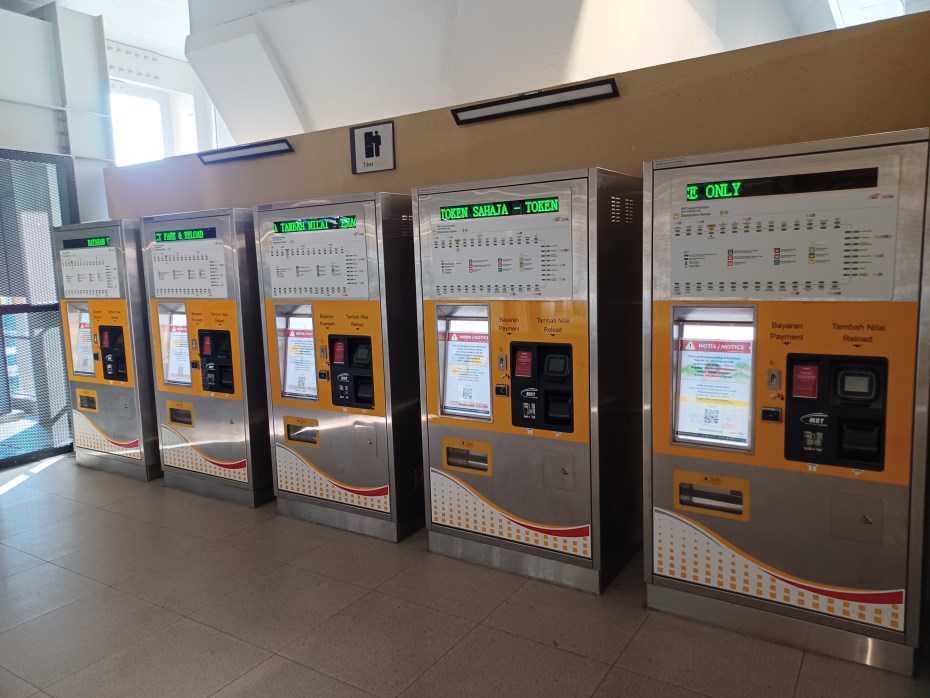
Single Journey Token (Cash Fare) - This token is available at the Token Vending Machine (TVM) or Customer Service Office in any of LRT, MRT, Monorail, and BRT station. Stored Value Card (Cashless Fare) - Available at the Customer Service Office at any of LRT, MRT, Monorail, and BRT station. Alternative, your MyKad (with Touch ‘N Go feature enable) or Touch ‘N Go card. Concession Card / Token - 50% discount on fares will be given to senior citizens, students and people with disabilities (OKU - registered under the Department of Social Welfare / JKM). The 50% discounted fare is calculated base on "Cash Fare Rate". MY50 Travel Pass - RM50 Unlimited Travel Pass for 30 days is for use on LRT, MRT, BRT, Monorail, RapidKL buses and MRT feeder buses. Used your MyKad (with Touch ‘N Go function) to enable the MY50 Travel Pass in Customer Service Office in any of LRT, MRT, Monorail, BRT stations and selected RapidKL bus hubs. MyCity 1-Day Pass - First time purchase: RM15.00 inclusive of RM5 purse value in the Touch N’ Go card and RM5 card price. Minimum RM5 purse value is required to use the 1-Day Pass at all Rapid KL rail and BRT network. Validity is for 1 day only. (The price of RM5 covers a span of 1 day and allows for multiple rides.) MyCity 3-Day Pass - First time purchase: RM25.00 inclusive RM20 purse value in the Touch N’ Go card and RM5 card price. Minimum RM15 purse value is required to use the 3-Day Pass at all Rapid KL rail and BRT network. Validity is for 3 days only. (The price of RM15 covers a span of 3 days and allows for multiple rides.) You can purchase MyCity Pass from the Rapid KL Customer Service Offices at all BRT, LRT, MRT and Monorail stations. If you already own a Touch 'n Go card, simply hand it over to the Customer Service Officer to have them 'program' the MyCity Pass for you if your purse value is enough. Note: MyCity Pass is only applicable for Malaysians only. Foreigners / expatriates can travel on Rapid KL Rail and BRT network using their Touch N’ Go card purse value or tokens. Check your fare here:


The MRT (Mass Rapid Transit) network is efficient, modern, and can take you to practically every point of interest in the city .
One thing that surprises people about the city is the atmosphere and life that abounds beneath the city. Some stations are enormous and have shops , restaurants , and more!
Unlike in many other cities, having a shop in the metro station is a great location!
The MRT has five lines
- NS (North-South Line, Red ): from Marina Bay to Jurong East.
- EW (East-West Line, Green) goes from the Changi Airport to Tuas Link. It takes 27 mins from the airport to the center.
- NE (North-East Line, Brown ): Connects HarbourFront (the stop if you want to go to Sentosa ) and Punggol.
- CC (Circle Line, Yellow ): Connects HarbourFront and Marina Bay.
- DTL (Downtown Line, Blue ): Connects Bukit Panjang in the northeast and Expo to the east.
No Durians Please
Something that's sure to surprise you is the restrictions on the MRT. On the metro, you can't smoke, eat, drink, or bring on board flammable substances or (the cherry on the cake) durian fruit.
These are local fruits which, although tasty, smell terrible! And as well as on the metro, they're banned from hotels.
The metro runs from 5:30 am to 12:30 am . The frequency varies from 2 to 8 minutes depending on the line and the time of day.
The price of the Singapore MRT depends on the distance traveled. It varies between 1.50 SGD ( US$ 1.10) and 2.50 SGD ( US$ 1.80) per journey .
If you want to save on transport, the best option is the EZ-Link card or the Singapore Tourist Pass .
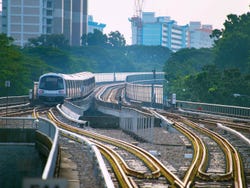
You may also be interested in
Singapore map, plan your trip.
When planning your trip to Singapore, you're sure to have some doubts about the documentation or visas you'll need, the weather and more. Here you'll find some answers to the most frequently asked questions.
- Attractions & Tours
- Flight + Hotel New
- Car Rentals
- Airport Transfers
- Destinations
- Trip.com Rewards
Latest MRT Map [April 2024] & Tips to Navigating Singapore MRT System

By Trip.com
April 22, 2024
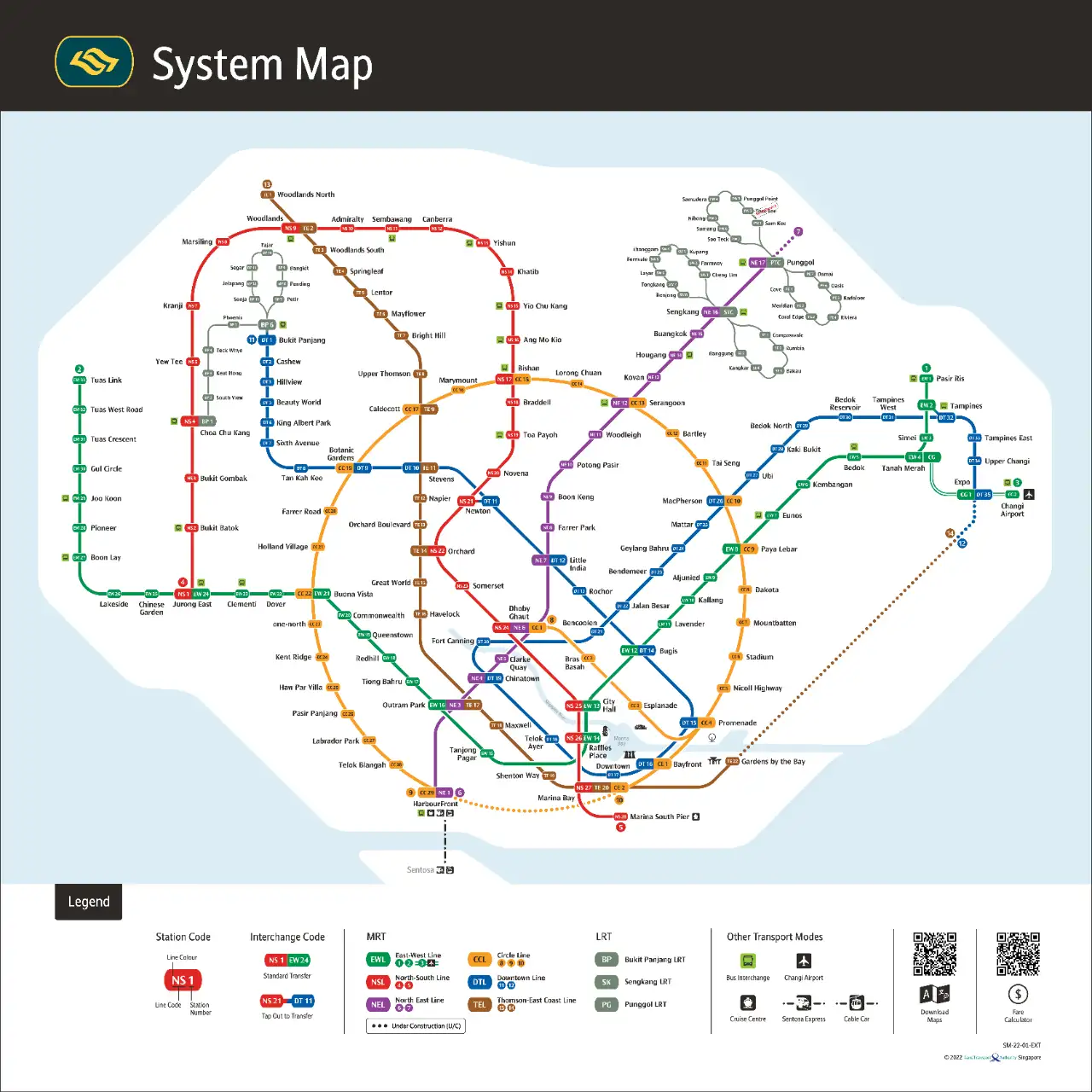
MRT Map from LTA Singapore is a vibrant and exciting city with a wealth of sights and experiences to explore. Taking the MRT (Mass Rapid Transit) is one of the best and most convenient ways for tourists to explore Singapore. This tourist guide provides a comprehensive overview of Singapore's MRT system and tips for getting the most out of your ride. Check out First & Last Train Timings from Changi Airport !
Introduction to the Singapore MRT
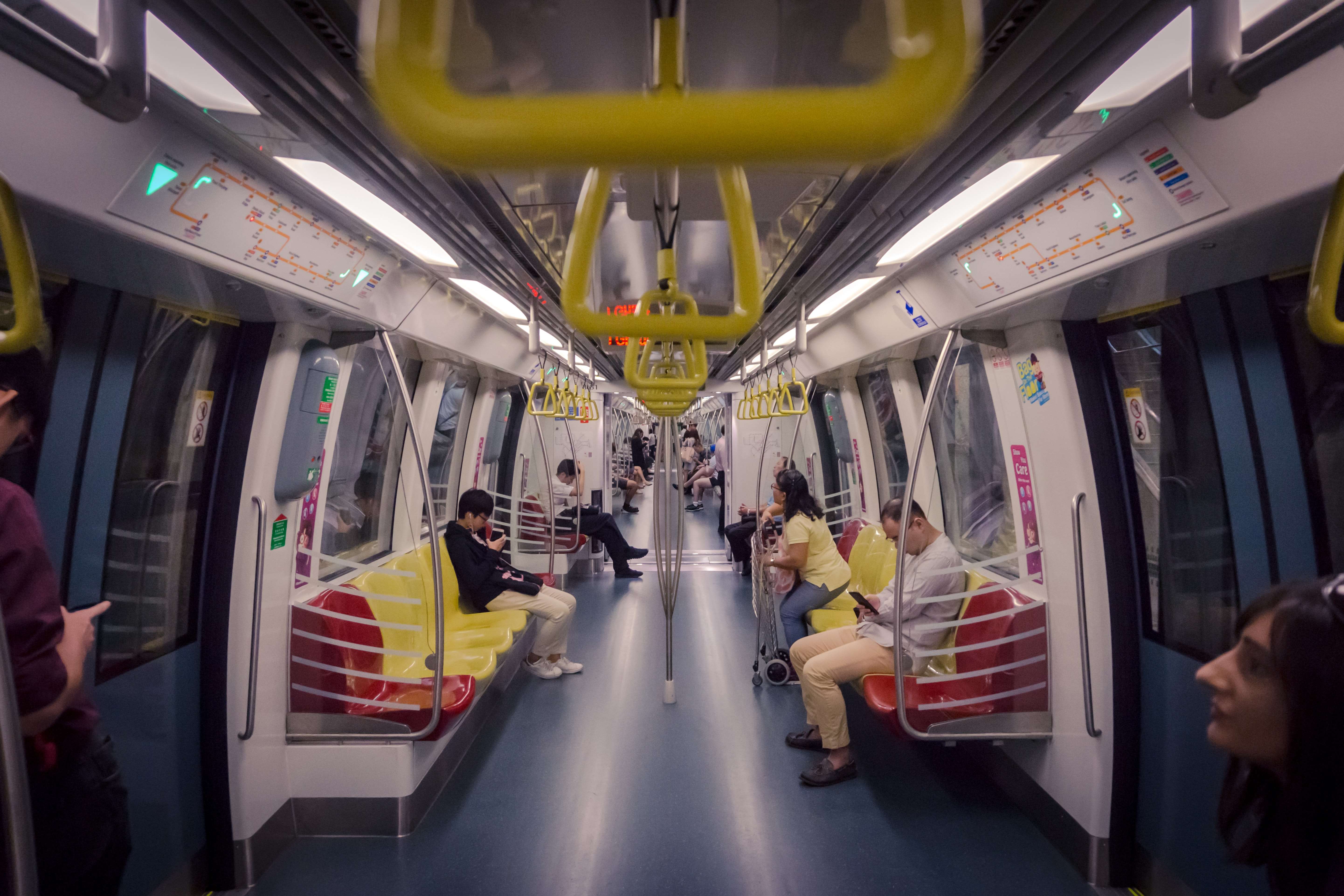
Photo by Kit Suman on Unsplash
The history of MRT in Singapore dates back to 1981 and is rooted in necessity. The island's limited space and growing population necessitated a transport system that could accommodate the demand. The then Prime Minister, Lee Kuan Yew, initiated the construction of the MRT, a project that required a staggering budget of 5 billion SGD.
The first MRT line was erected in the Toa Payoh and Novena area in 1983, marking the beginning of a transportation revolution in Singapore. Gradually, the MRT network expanded into the city's center, with the first line, the North-South Line, opening officially on November 7, 1987. Since then, the MRT has become a reliable and comfortable choice of transport for both locals and tourists.
The Singapore MRT system is one of the world's most advanced and efficient transportation networks. It is a great way to explore the city and its many attractions. The system is made up of five lines: North-South, East-West, Circle, Northeast, and Downtown. It is well-connected and covers the entire city, making it easy to get around.
The MRT is a great way to explore Singapore's attractions, as it is well-connected with many of the city's tourist spots. The MRT stations are clearly marked and easy to find. There is also an extensive network of buses and taxis for those who prefer not to take the MRT.
An Overview of the MRT Lines
The MRT system comprises several lines, each denoted by a specific color on the MRT map . These lines connect different parts of Singapore, making travel quick and easy.
Thomson-East Coast Line: The Newest Addition
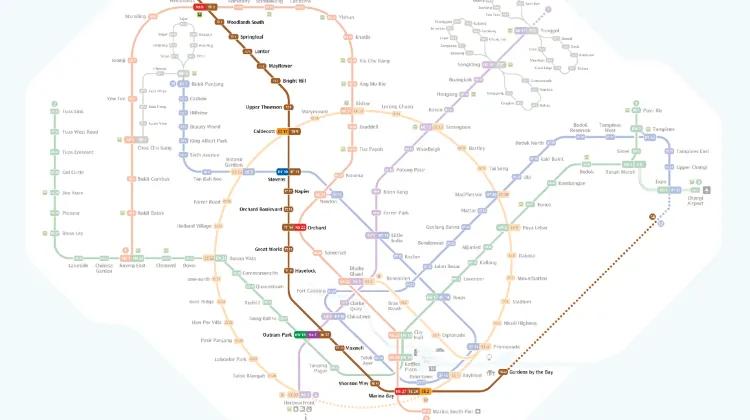
The Thomson-East Coast Line, denoted by the color brown on the MRT map , is the latest addition to the MRT network. It offers an alternative to the North-South Line and is particularly beneficial for residents of the Woodlands area. The line's construction is still ongoing, with phases two and three delayed due to the COVID-19 pandemic.
The Thomson-East Coast Line is also part of Singapore's Art in Transit program, featuring unique artworks at each station. Particularly, the Woodlands South station stands out with its vibrant wall decor, making it a fun stop for a quick selfie.
Sengkang LRT and Punggol LRT: Smaller but Significant
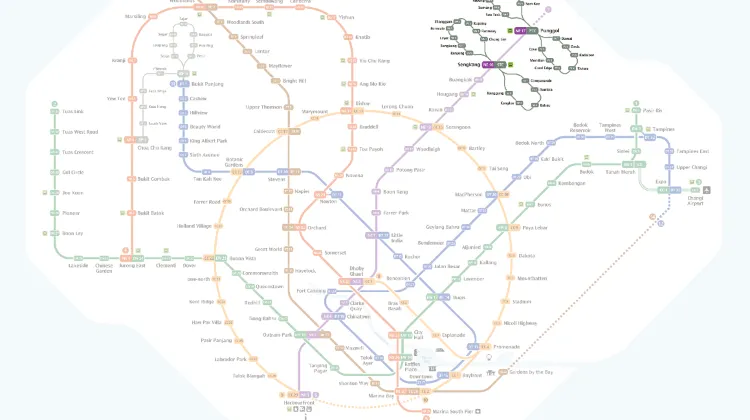
The Sengkang and Punggol Light Rail Transit (LRT) lines, marked in grey on the MRT map , are smaller and less speedy than the MRT lines, but they cover essential areas. The Sengkang LRT, a driverless and fully automated train, has two loops: the East Loop and the West Loop. Similarly, the Punggol LRT is divided into two loops.
North-South Line: The Pioneer

As the first MRT line in Singapore, the North-South Line holds historical significance. Since its inauguration in 1987, it has expanded to cover 27 stations and has transitioned from semi-automatic to fully-automatic operation. The line is denoted by red on the MRT map .
Notable Stations:
- Orchard Station : As the epicenter of Singapore's famed shopping scene, Orchard Road offers an unparalleled retail experience with its array of malls and boutiques. The area buzzes with activity, from high-end fashion to street-level bargains, alongside a variety of dining options.
- Marina Bay Station : This station opens up to the futuristic landscape of the Marina Bay area. Here, you can explore the iconic Marina Bay Sands, the stunning Gardens by the Bay with its Supertree Grove, and the architecturally unique ArtScience Museum. The area is a testament to Singapore’s urban innovation and cultural flair.
- Khatib Station : A gateway to Singapore's wildlife experiences, Khatib Station is the closest MRT stop to the Singapore Zoo, River Safari, and Night Safari. These attractions offer immersive encounters with a wide range of wildlife, set in environments that closely mimic their natural habitats.
North East Line: A Technological Marvel
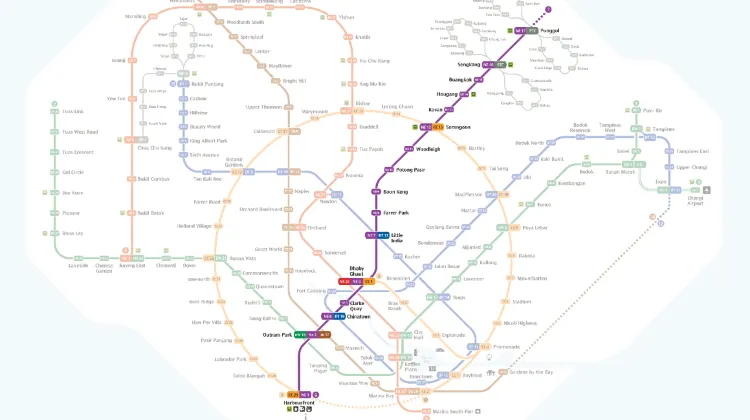
The North East Line, marked in purple on the MRT map , is the world's first fully automated and driverless MRT line. It consists of 16 stations, each featuring distinctive artworks as part of the Art in Transit Program. If you're headed to Sentosa Island, you can disembark at the HarbourFront station and continue your journey via the Sentosa Express Monorail.
- Little India Station : Little India is a vibrant district that offers a sensory feast. From the colorful facades of its shophouses to the tantalizing scents of its street food, this area provides an authentic glimpse into Indian culture within Singapore.
- HarbourFront Station : HarbourFront Station serves as the main access point to Sentosa Island, a world-renowned resort destination. Sentosa is a treasure trove of attractions, including beaches, theme parks, and luxury resorts, making it a perfect escape from the city hustle.
- Clarke Quay Station : Clarke Quay is synonymous with nightlife and dining in Singapore. This historic riverside quay is bustling with bars, restaurants, and clubs, offering a lively atmosphere and picturesque views, especially at night.
East-West Line: The Longest Route
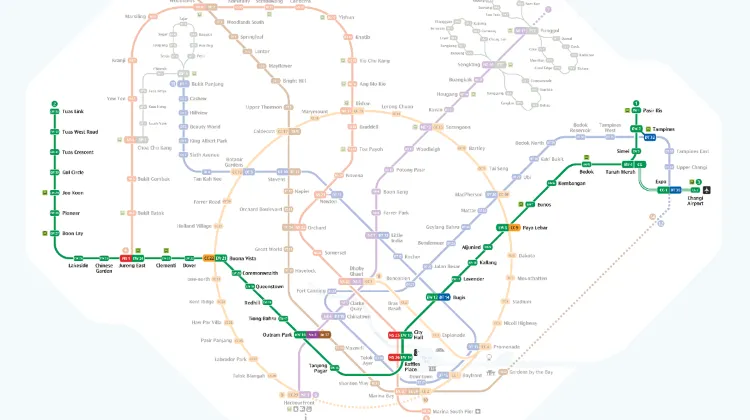
The East-West Line, the second oldest MRT line in Singapore, is the longest train rail in the city-state. It covers 35 stations and is marked in green on the MRT map . The line has an extension to Changi Airport from the Tanah Merah MRT Station, making it convenient for travelers.
- Raffles Place Station : Situated in the heart of Singapore's financial district, this area is not just about high-rise buildings and corporate offices. A short walk away is the Merlion Park, offering picturesque views of the Marina Bay and a chance to see the iconic Merlion statue.
- Changi Airport Station : Ranked among the world’s best airports, Changi Airport is a destination in itself. The station provides direct access to the airport’s various terminals, including the Jewel Changi Airport, known for its breathtaking Rain Vortex and lush indoor gardens.
- Bugis Station : This station is a stone's throw away from the vibrant Bugis Street market. Known for its bustling atmosphere, the area is a mix of traditional shops, modern boutiques, and street food stalls, reflecting Singapore’s multicultural heritage.
Downtown Line: The Subterranean Marvel
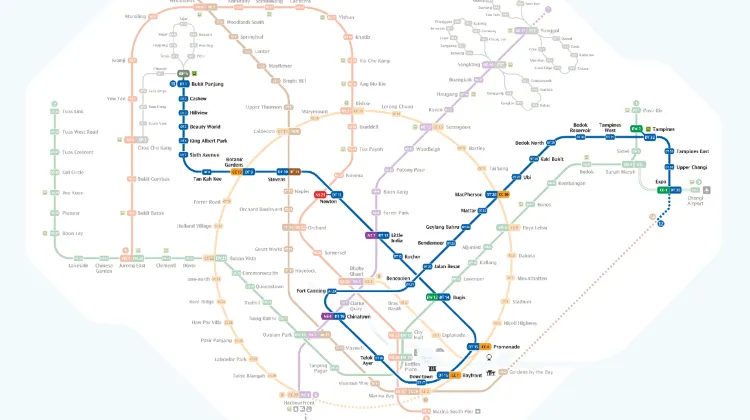
Marked in blue on the MRT map , the Downtown Line is the fifth and longest fully underground MRT line in the world. It serves 34 stations and is known for its extensive Art in Transit program.
- Bugis Station : Bugis is known for its youthful vibe and cultural diversity. The nearby Haji Lane is a narrow alley filled with independent boutiques, cafes, and wall murals, offering a stark contrast to the modern cityscape.
- Promenade Station : The Singapore Flyer, one of the world's largest observation wheels
Circle Line: The Perfect Circle

The Circle Line, aptly named for its circular shape on the MRT map and marked in orange, was the fourth MRT line in Singapore. It spans 35.7 km and covers 30 stations. This line significantly reduced the travel time between Bishan and Changi Airport from 1 hour 30 minutes to just 45 minutes.
- Esplanade Station : Adjacent to the iconic Esplanade - Theatres on the Bay, this area is a cultural landmark in Singapore, known for its durian-like architecture and a plethora of performing arts events. The nearby Marina Bay area serves as a stunning backdrop, especially during the evening.
- Botanic Gardens Station : The Singapore Botanic Gardens, a UNESCO World Heritage site, is a testament to Singapore's reputation as a city in a garden. This station offers direct access to the lush greenery and tranquil scenery of the gardens, including the famous National Orchid Garden.
- Bayfront Station : Bayfront Station is the doorstep to the Marina Bay Sands complex, a symbol of modern Singapore. The area is a hub of luxury shopping, fine dining, and entertainment, with the ArtScience Museum adding a touch of creativity and innovation.
Bukit Panjang LRT: The First Light Rail System

The Bukit Panjang LRT, marked in grey on the MRT map , was the first light rail system in Singapore. Despite its short length of 7.6 km, it conveniently connects with the North-South Line and Downtown Line.
MRT fares and ticketing systems
The fares for Singapore MRT are dependent on the distance traveled and the type of ticket used. The fares are divided into two categories: adult fares and senior citizen/student fares.
For adult fares, the prices range from S$0.92 to S$3.10 for a single trip, depending on the distance traveled. Passengers can also choose to use the EZ-Link card, which offers a 10% discount off the standard adult fare. The EZ-Link card can be purchased and topped up at any MRT station or convenience store.
For senior citizen/student fares, the prices range from S$0.50 to S$1.55 for a single trip, again depending on the distance traveled. Senior citizens can enjoy these fares if they are aged 60 years and above, while students can enjoy these fares if they are primary, secondary, or full-time polytechnic students in Singapore.
There are also other types of tickets available, such as the Singapore Tourist Pass and the Monthly Travel Pass, which offer unlimited rides within a certain duration. Passengers are encouraged to check the fare calculator on the webpage to determine the fare for their intended journey.
EZ Link Card
To use the MRT, tourists will first need to purchase an EZ-Link card , which can be easily obtained at any MRT station. The card can be used not only on the MRT, but also on buses and certain other forms of public transportation in Singapore. Tourists can choose between a single-trip ticket, which is valid for one journey on the MRT, or a stored-value card, which allows for multiple trips and can be topped up as needed.
Once they have their EZ-Link card, tourists can plan their trip using the interactive MRT map, which can be found on the official website of the Land Transport Authority (LTA). The website also provides real-time updates on train schedules and disruptions, so visitors can plan their journey with confidence.
MRT is an effective transport system for tourists
Overall, the MRT is a convenient and efficient way for tourists to explore Singapore. With its extensive coverage of popular attractions and easy-to-use payment system, it is the perfect option for visitors who want to make the most of their time in the city-state. If you are planning to book flights to Singapore, do check out our Trip.com Promotion Codes for the greatest savings.
- 1. Introduction to the Singapore MRT
- 2. An Overview of the MRT Lines
- 3. MRT fares and ticketing systems
- 4. EZ Link Card
- 5. MRT is an effective transport system for tourists
<h3>Trending Searches</h3>
Getting Around
- ferry to desaru
- tokyo to hokkaido train
- busan to jeju
- train from singapore to jb
- Narita Express
- bangkok bts map
- travel to thailand from singapore
- travel apps for south korea
- ferry to batam
- egate malaysia
- ez link card
- travel to Bintan from Singapore
- Japan Car Rental
- ferry to bintan
- sentosa express
Popular Attractions
- sea aquarium
- legoland Malaysia
- adventure cove
- river wonders
- wild wild wet
- lazarus island
- henderson waves
Connectivity
- esim indonesia
- vietnam esim
- taiwan esim
- europe esim
- thailand esim
- Switzerland eSIM
Popular Content
- public holiday 2024
- maxwell food centre
- newton food centre
- Cheap Flight
- tiong bahru market
- hawker centres
- singapore arrival card
- old airport road food centre
- Universal Studios Japan
- First and Last Train from Changi Airport
- travel adapter guide
- what electronics can go in checked luggage
- prepaid sim card
- Customer Support
- Service Guarantee
- More Service Info
- Website Feedback
- About Trip.com
- Terms & Conditions
- Privacy Policy
- About Trip.com Group
Other Services
- Investor Relations
- List My Hotel
- Become a Supplier

- About MTR
- Careers
- Investors
- Barrier-free
- Contact Us
中文 Text Size: Default Size Text Size: Larger Text Size: Largest
Facebook Youtube Instagram Linkedin
Airport Express
- Home
- Tickets and Fares
- Services and Facilities
- MTR Mobile
- Shops and Malls
- Corporate Responsibility
- MTR Academy
- Tourist

Tickets and Fares
- Octopus
- QR Code
- Contactless Bank Card (Credit Card or Debit Card)
- Single Journey Tickets
- Elderly and Eligible Persons with Disabilities
- MTR Student Travel Scheme
- Fare Saver
- MTR Interchange Discount
- Park and Ride Scheme
- City Saver
- Monthly Pass
- Day Pass
- Fares
- Group Travel
- Airport Express Taxi Interchange Promotion
- Airport Express Morning Express Service
- High Speed Rail
- Intercity Passenger Services
- Online Purchase
- Tourist Day Pass
TICKET SUGGESTION

One Day Travel
Friendly Reminder: We are now working out the actual changes to individual fares according to the recently announced Overall Fare Adjustment Rate in 2024/25 of +3.09%. Available period for selection in "Ticket Suggestion" is up to June 2024 and the fares shown are based on current fares for your reference only.
Daily Travel Type
Single Trip
Same Day Round Trip
Multi-days Travel
Weekly Travel Pattern
Include Public Holiday
Exclude Public Holiday
Using Octopus to exit the gate between 7:15 and 8:15 a.m. in the following trip(s) can earn a fare discount. [ Details ] Please select if applicable.
Departure Trip
Return Trip
Waving Octopus over the reader on the designated MTR Fare Saver in the following trip(s) can enjoy a fare discount. [ Details ] Please select if applicable.
OTHER PROMOTIONS OTHER PROMOTIONS
Tickets and fares.
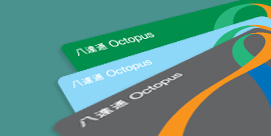
- About Octopus
- Octopus Fares
- About QR Code
- QR Code Fares
- Special Edition Octopus

- About Single Journey Tickets

- East Rail Line
- High Speed Rail
- Intercity Passenger Services
special schemes

- Elderly and Eligible Person With Disabilities
- Student Travel Scheme
- Intermodal discount
- Park and Ride Scheme
Frequent user passes
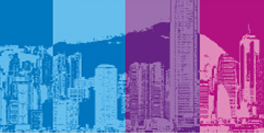
- Monthly Pass
- Tourist Products
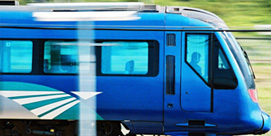
- Tickets Types & Fares
- Group Travel
- Airport Express Travel Pass
- Airport Express Taxi Interchange Promotion
- Airport Express Morning Express Service
- Home Trip Planner (Route Suggestion) Trip Planner (Ticket Suggestion) Way To Save What's New Community Our Service Performance Mobile Apps Network Extension Go Smart Go Beyond MTR 45th Anniversary
- Tickets and Fares Tickets and Fares Special Schemes Frequent User Passes Airport Express High Speed Rail Intercity Passenger Services Tourist Passes
- Services and Facilities Our Network Service Status Station Facilities Special Needs Services and Other Schemes Mobile Apps
- Shops and Malls MTR Shops MTR Malls
- Corporate Responsibility Community Connect Operating Responsibly Sustainability Modern Slavery Act
- MTR Academy About MTR Academy Local Programmes Global Services
- Tourist Plan Your Trip Traveller's Tips Buy Tickets

Important Notice | Terms of Use | Privacy Policy | Mass Transit Railway By-laws | Mass Transit Railway (North-West Railway) Bylaw | Accessibility Statement Conditions of Issue of Tickets | Conditions of Issue of Octopus | Conditions of Carriage of Luggage | Light Rail & Bus Notice | Useful links | Sitemap
© 2024 MTR Corporation Limited

Moscow Metro
Opened in 1935 under Stalin, the Moscow Metro is one of the largest networks in the world and a tourist attraction in itself. Discover how to get around on it!
Designed to be " palaces of the people ", the different stations of Moscow's metro are spectacular examples of Socialist Realist art and architecture. Aside from providing fascinating insight into the city's history, the metro network is also an efficient and economical way to get around the Russian capital .
Operating times & frequency
The Metro Moscow operates daily between 5:30 am and 1 am , with trains departing every 1 to 3 minutes during peak times. Outside of rush hour, trains are less frequent, every 4 to 7 minutes depending on the line and the time of day.
Ticket prices
The price of a single ticket for the Moscow Metro is 55 Roubles . Single tickets allow you to change trains as many times as you like, with no limit on distance or time. To buy tickets, you may struggle to find English speaking staff, however you should be to communicate the number of tickets you need by holding up your fingers, and thankfully most stations now have simple automated machines that you can use too.
There are often long queues to buy tickets, so if you're planning to travel by metro a lot, we recommend buying multi-ride tickets to save time and money. You'll get a paper card which you tap on the reader to go through the turnstile.
You can buy a daily ticket for ₽ 230 ( US$ 2.50) or a 3-day ticket for ₽ 438 ( US$ 4.70).
Metro lines
Moscow Metro has 17 lines with a total length of 246 miles (397 km) divided into more than 230 stations (265 if we include the Moscow Central Circle). Each line is identified by a name, a number and a colour.
Guided tour of the Moscow Metro
Moscow's metro network is a museum in itself, and it's a must-see attraction on any trip to the Russian capital. The long marble corridors, fascinating Soviet-themed frescoes and gilded sculptures are truly captivating. To make the most of your visit and learn all about the symbolism and history behind some of the city's main metro stations, why not explore the network with an expert English-speaking guide? Take a look at our Guided Tour of the Moscow Metro to find out more!
A curious detail about the Moscow metro lies in the announcements on the trains. Unless you speak Russian, you probably won't understand the content of the voiceovers, however, you may note something interesting: trains heading into the city have male voiced announcements, and trains heading out of the city have female voiced announcements!
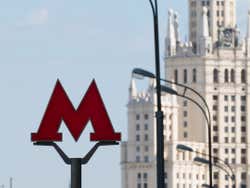
You may also be interested in
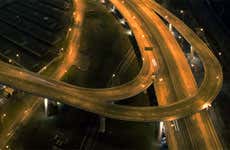
Moscow's public transport network is efficient, comfortable and economical. Discover the city's main modes of transport, their timetables and prices.
Moscow Tourist Bus
Discover the different routes and stops of Moscow's tourist bus and explore the city comfortably enjoying panoramic views of its main monuments.

MRT Jakarta Price Guide: Buying tickets for MRT Jakarta
- Share on Facebook
- Share on Pinterest
- Email Article

Buying Tickets for MRT Jakarta How much does it cost to use MRT Jakarta?
MRT Jakarta price? How much does the MRT Jakarta cost per trip? Good questions.
With Jakarta’s first-ever MRT now open, the city is buzzing with excitement. This raises a really good question: How much does it cost to ride the MRT in Jakarta? Locals may call this the tariff, whereas international visitors may call it the ticket price.
The M1 North-South MRT Line consists of 13 stations. This line spans a total distance of 15.7 km.
In an effort to cut down on Jakarta’s notorious traffic issues, there is optimism that the MRT can take some pressure off the roads and the commuter network throughout the city.
One of the challenges with the MRT in Jakarta is convincing middle-class and upper-class Jakartans to leave their private vehicles at home.
Since owning a vehicle is still a status symbol in Indonesia, skeptics wonder whether locals will be willing to opt for the MRT opposed to being dropped off right at the door using their vehicle?
Price, Cost or ‘Tarif’ for Jakarta MRT: Considerations
Another clear factor that MRT management and the local government in Jakarta must consider is the price of each trip.
If the price of Jakarta’s MRT is considered too high by local commuters they will continue to drive their own vehicles. They may even continue using the Transjakarta bus network or the very affordable commuter system throughout the city.
They must be convinced that it is a practical, affordable and a quick form of transportation in Jakarta. If it is too much then commuters won’t give it a real shot.
Currently, bus rides and commuter trips usually vary between 3,000 and 5,000 IDR per trip. This is very affordable in comparison to other cities around the world.
MRT Jakarta Price Summary $$$$$
Currently, the MRT Jakarta price follows a progressive model.
What this means is that passengers pay 3,000 IDR to enter the MRT and then an additional 1,000 IDR for every station they pass during their journey . Currently, the maximum MRT Jakarta price is set at 14,000 IDR .
Although these initial prices have been announced, you can expect them to change over time according to demand and changes in government subsidies.
Based on this progressive price model you have to consider how far your trip is going to be on MRT Jakarta. The price of MRT Jakarta tickets differs depending on the distance of your journey.
Let’s look at a few examples to fully understand how much tickets cost for MRT Jakarta passengers.
If you begin your journey at Lebak Bulus MRT Station in southern Jakarta and you travel all the way to Bundaran HI MRT Station in Thamrin, Central Jakarta this is the maximum distance. This journey involves stopping at all 13 MRT stations in Jakarta. According to the MRT prices, this will cost 14,000 IDR .
If you consider the round trip journey the MRT Jakarta price will be 28,000 IDR.
The price of this journey will be different from the price of a trip from Lebak Bulus MRT Station to Fatmawati MRT Station , for instance.
These are neighbouring stations that are close to each other. It will cost you 3,000 IDR to enter the MRT and then 1,000 IDR additional because these are adjacent stations. The total cost for this trip on MRT Jakarta will be 4,000 IDR.
If you consider the round trip journey the MRT Jakarta price will be 8,000 IDR.
Also, keep in mind that prices can change depending on the distance between stations as well. If two stations are far from each other, then it may cost you more than the 1,000 IDR surcharge.
According to the MRT Jakarta personnel, the approximate cost to use the MRT is 8,500 IDR for a ten-kilometer 1-way trip.
Are there monthly passes available for Jakarta MRT?
Currently, there are no monthly passes available for MRT Jakarta. It sounds like there will be day passes before monthly passes are even considered. Don’t be surprised in the future that longer-term passes are available for commuters. In the meantime, expect to pay per trip until more options become available.
MRT Jakarta Price Changes Over Time
There are a lot of variables at play that will influence the ticket price to use the MRT in Jakarta going forward.
If the demand for the MRT is very high from public commuters this will be taken into account.
So too will change in government subsidies.
The initial prices are subsidized by the local administration. Depending on the health of the local economy you can expect government support to change, and therefore the price as well.
Another consideration is whether monthly or annual MRT Jakarta passes will be available in the future? There are thousands of commuters who travel from southern satellite cities on a daily basis that would benefit from long term price options.
Singapore, for instance, offers significantly cheaper MRT prices to passengers who travel during non-peak times throughout the day. This can reduce overload and overuse in the MRT system.
The commuter system in Jakarta is extremely popular because it is affordable and well connected. But it can get overloaded. If the prices for the Jakarta MRT are well planned then hopefully it will remain as a practical, comfortable and safe means of transportation in the future.
Although some of these MRT Jakarta price decisions still need to be made, this guide will be continuously updated in the future to show accurate price details at all times.
MRT Jakarta Related Links and Resources
- MRT Jakarta Guide: The most comprehensive guide to Jakarta’s MRT System
- MRT Jakarta Accommodation Guide: Everything you need to know about finding the best properties near each MRT Station
- MRT Jakarta Shopping Guide: Everything you need to know about getting to the best shopping malls near MRT Stations
- MRT Jakarta Map: A detailed overview of Jakarta’s MRT
- MRT Jakarta Ticket Guide: Learn how to purchase MRT tickets for Jakarta while avoiding the lines.
MRT/LRT Fare Calculator, Travel Time and Route Guide
* Commuting times are estimates only. Actual travel times may be affected by transfers, waiting times, train system faults and peak/non-peak hour carriage frequencies.
More about popular stations ...
Acknowledgment:.
- Admiralty [NS10]
- Aljunied [EW9]
- Ang Mo Kio [NS16]
- Bakau [SE3]
- Bangkit [BP9]
- Bartley [CC12]
- Bayfront [CE1][DT16]
- Beauty World [DT5]
- Bedok [EW5]
- Bedok North [DT29]
- Bedok Reservoir [DT30]
- Bencoolen [DT21]
- Bendemeer [DT23]
- Bishan [CC15][NS17]
- Boon Keng [NE9]
- Boon Lay [EW27]
- Botanic Gardens [CC19][DT9]
- Braddell [NS18]
- Bras Basah [CC2]
- Bright Hill [TE7]
- Buangkok [NE15]
- Bugis [DT14][EW12]
- Bukit Batok [NS2]
- Bukit Gombak [NS3]
- Bukit Panjang [BP6][DT1]
- Buona Vista [CC22][EW21]
- Caldecott [CC17][TE9]
- Canberra [NS12]
- Cashew [DT2]
- Changi Airport [CG2]
- Cheng Lim [SW1]
- Chinatown [DT19][NE4]
- Chinese Garden [EW25]
- Choa Chu Kang [BP1][NS4]
- City Hall [EW13][NS25]
- Clarke Quay [NE5]
- Clementi [EW23]
- Commonwealth [EW20]
- Compassvale [SE1]
- Coral Edge [PE3]
- Dakota [CC8]
- Damai [PE7]
- Dhoby Ghaut [CC1][NE6][NS24]
- Dover [EW22]
- Downtown [DT17]
- Esplanade [CC3]
- Eunos [EW7]
- Expo [CG1][DT35]
- Fajar [BP10]
- Farmway [SW2]
- Farrer Park [NE8]
- Farrer Road [CC20]
- Fernvale [SW5]
- Fort Canning [DT20]
- Gardens by the Bay [TE22]
- Geylang Bahru [DT24]
- Great World [TE15]
- Gul Circle [EW30]
- HarbourFront [CC29][NE1]
- Havelock [TE16]
- Haw Par Villa [CC25]
- Hillview [DT3]
- Holland Village [CC21]
- Hougang [NE14]
- Jalan Besar [DT22]
- Jelapang [BP12]
- Joo Koon [EW29]
- Jurong East [EW24][NS1]
- Kadaloor [PE5]
- Kaki Bukit [DT28]
- Kallang [EW10]
- Kangkar [SE4]
- Keat Hong [BP3]
- Kembangan [EW6]
- Kent Ridge [CC24]
- Khatib [NS14]
- King Albert Park [DT6]
- Kovan [NE13]
- Kranji [NS7]
- Kupang [SW3]
- Labrador Park [CC27]
- Lakeside [EW26]
- Lavender [EW11]
- Layar [SW6]
- Lentor [TE5]
- Little India [DT12][NE7]
- Lorong Chuan [CC14]
- MacPherson [CC10][DT26]
- Marina Bay [CE2][NS27][TE20]
- Marina South Pier [NS28]
- Marsiling [NS8]
- Marymount [CC16]
- Mattar [DT25]
- Maxwell [TE18]
- Mayflower [TE6]
- Meridian [PE2]
- Mountbatten [CC7]
- Napier [TE12]
- Newton [DT11][NS21]
- Nibong [PW5]
- Nicoll Highway [CC5]
- Novena [NS20]
- Oasis [PE6]
- one-north [CC23]
- Orchard [NS22][TE14]
- Orchard Boulevard [TE13]
- Outram Park [EW16][NE3][TE17]
- Pasir Panjang [CC26]
- Pasir Ris [EW1]
- Paya Lebar [CC9][EW8]
- Pending [BP8]
- Petir [BP7]
- Phoenix [BP5]
- Pioneer [EW28]
- Potong Pasir [NE10]
- Promenade [CC4][DT15]
- Punggol [NE17][PTC]
- Punggol Point [PW3]
- Queenstown [EW19]
- Raffles Place [EW14][NS26]
- Ranggung [SE5]
- Redhill [EW18]
- Renjong [SW8]
- Riviera [PE4]
- Rochor [DT13]
- Rumbia [SE2]
- Sam Kee [PW1]
- Samudera [PW4]
- Segar [BP11]
- Sembawang [NS11]
- Sengkang [NE16][STC]
- Senja [BP13]
- Serangoon [CC13][NE12]
- Shenton Way [TE19]
- Simei [EW3]
- Sixth Avenue [DT7]
- Somerset [NS23]
- Soo Teck [PW7]
- South View [BP2]
- Springleaf [TE4]
- Stadium [CC6]
- Stevens [DT10][TE11]
- Sumang [PW6]
- Tai Seng [CC11]
- Tampines [DT32][EW2]
- Tampines East [DT33]
- Tampines West [DT31]
- Tan Kah Kee [DT8]
- Tanah Merah [EW4]
- Tanjong Pagar [EW15]
- Teck Whye [BP4]
- Telok Ayer [DT18]
- Telok Blangah [CC28]
- Thanggam [SW4]
- Tiong Bahru [EW17]
- Toa Payoh [NS19]
- Tongkang [SW7]
- Tuas Crescent [EW31]
- Tuas Link [EW33]
- Tuas West Road [EW32]
- Upper Changi [DT34]
- Upper Thomson [TE8]
- Woodlands [NS9][TE2]
- Woodlands North [TE1]
- Woodlands South [TE3]
- Woodleigh [NE11]
- Yew Tee [NS5]
- Yio Chu Kang [NS15]
- Yishun [NS13]

IMAGES
VIDEO
COMMENTS
Single Trip Tickets in Singapore - No Longer Available. As their name suggests, single-trip MRT tickets were purchasable directly from a ticketing machine within one of the stations. These are often called 'standard tickets' within stations. These are no longer available post-Covid. There were some pros and cons associated with these ...
A single trip for an adult start from $1.40 and can be purchased from ticket machines at the stations. Usually, the train operation starts daily at 5.30am and runs until midnight with peak hours between 7am to 9am. Announcements are made in English as is all signage. To get to and from Changi Airport, you can take the East/West (green) line.
Single Journey Ticket Fare . Check Your Fare. You can plan your journey and check your fare simply by entering your starting location and desired destination in the Trip Planner. Type. Adult Single Journey Ticket Fare (Student included) / Concessionary Single Journey Ticket Fare Chart (Child/Senior Citizen) Information:
The Moscow Metro provides various fare options, and the cost of a single trip is highest when purchasing one-time travel cards. If you plan to use the metro frequently, it is more cost-effective to purchase a Troika universal card.This card can be used to load a travel card with no travel limit, such as for 1,3, 30, 90 or 365 days, or to purchase 60 trips at a discounted rate.
Multiple Ride Ticket. Valid for 3 months from the date of purchase. P100.00 with 20% discount for Senior Citizens and PWDs with last ride bonus. Be updated on all the Latest new MRT 3 Philippines and know the truth about its trains, maintenance, operations and ownership Metro manila transportation line 3.
Single Journey Ticket: 1 Single journey on the Airport Express to or from Airport and the station specified, valid on day of issue only. ... Round Trip tickets are station-specific and can be used for 1 return journey on the Airport Express between Airport and the station specified. This ticket is valid for 30 days from date of issue.
Tickets and Fares. -. Single Journey Tickets. About Single Journey Tickets.
One such variety of tickets is known as a Single Ride ticket, and it permits the holder to take a single trip on any sort of public transit. A single-ride ticket can be bought at a number of places, such as metro stations, kiosks, and other sales points. ... Single tickets for the Metro cost 55 rubles, and for buses and trams, it is 28 rubles ...
Updated. Dec 03, 2021, 07:25 PM. SINGAPORE - Sale of standard tickets - limited use paper tickets - at MRT stations will be progressively phased out between January and March 2022. This comes as ...
Tiket Single Trip. Tiket berupa kartu yang dapat dipakai untuk sekali jalan. ... Dengan Aplikasi MRT Jakarta Anda dapat membayar dengan uang elektronik pilihan Anda. Aplikasi MRT Jakarta. PT MRT Jakarta. Wisma Nusantara Lt. 21 Jln. MH Thamrin 59 Jakarta 10350 - Indonesia (+62-21) 390 6454 (+62-21) 315 5846 (+62-21) 314 2273 ...
A trip works out at ₽ 42 (US$ 0.40), but if you change transport within 90 minutes, you'll only pay ₽ 23 (US$ 0.20) for the next trip. Day Ticket. The day ticket for the Moscow metro can be purchased at any of the stops in the city. The price is ₽ 265 (US$ 2.80) per day and ₽ 500 (US$ 5.30) for three days. 90-Minute Ticket
The first Moscow Metro system opened in 1935 with 13 stations along a single 11-kilometre (6.8 mi) line. As of 2021, ... Ticket Cost. A one way ticket or one trip ticket on the metro is ₽55.00 (less than USD $1) regardless of the length of the trip. Two trips ₽110.00.
Inside the MRT train, Singapore Singapore MRT Map MRT fare for single trip Fare table | public transport in singapore for tourists. The bus fare is between $0.73 and $1.66 for single trip, and MRT is from $0.83 to $1.95 when using EZ-link card, depending on the length of your journey.
Here are the steps to getting MRT tickets in Jakarta using the ticketing machines: 1) First proceed to your station of interest. Currently, there are 13 MRT Stations in Jakarta. You can refer to this comprehensive MRT Jakarta Guide to find out which station is the closest to you or your hotel.
Jakarta Metro - Information, Route Map, Fare & Timings. Jakarta Mass Rapid Transit (MRT) is a 20.1 km metro system with 1 line and 13 stations in Jakarta, Indonesia. Phase 1 of the project (Lebak Bulus to Bundaran HI) was officially opened on 24 March 2019. Groundbreaking for Phase 2 was finally held on 24 March, 2019.
On 3 Dec 2021, the Land Transport Authority (LTA) announced that they'll be phasing out the sale of single-trip standard tickets at MRT stations. It'll be removed progressively, starting with the Thomson-East Coast and Downtown line from 10 Jan 2022. It'll be followed by the Circle and North-East Line on 10 Feb, and finally, the East-West ...
MyCity 3-Day Pass - First time purchase: RM25.00 inclusive RM20 purse value in the Touch N' Go card and RM5 card price. Minimum RM15 purse value is required to use the 3-Day Pass at all Rapid KL rail and BRT network. Validity is for 3 days only. (The price of RM15 covers a span of 3 days and allows for multiple rides.)
To get started, purchase a single-trip ticket (single-trip ticket is no longer valid since 2022), or a credit card or an EZ-Link card, a contactless smart card that can be refilled and used on MRT trains, ... Since MRT discontinued the single trip tickets from General Ticketing Machines (GTM) at all MRT stations, we suggest you use an EZ-Link ...
The MRT metro network in Singapore reaches about every corner of the city. Find out about the lines, schedule and prices. ... Plan your trip. ... 8.84 31 reviews . US$ 23.40. book. Singapore Tourist Bus. 8.28 86 reviews . US$ 43.20. book. Marina Bay Sands Observation Deck Ticket. 8.22 72 reviews . US$ 23.40. show all the activities. Airport ...
The fares for Singapore MRT are dependent on the distance traveled and the type of ticket used. The fares are divided into two categories: adult fares and senior citizen/student fares. For adult fares, the prices range from S$0.92 to S$3.10 for a single trip, depending on the distance traveled.
About QR Code. QR Code Fares. Special Edition Octopus. Single Journey tickets. About Single Journey Tickets. Fares. cross boundary Train Services. East Rail Line. High Speed Rail.
There are often long queues to buy tickets, so if you're planning to travel by metro a lot, we recommend buying multi-ride tickets to save time and money. You'll get a paper card which you tap on the reader to go through the turnstile. You can buy a daily ticket for ₽ 230 (US$ 2.40) or a 3-day ticket for ₽ 438 (US$ 4.70). Metro lines
It will cost you 3,000 IDR to enter the MRT and then 1,000 IDR additional because these are adjacent stations. The total cost for this trip on MRT Jakarta will be 4,000 IDR. If you consider the round trip journey the MRT Jakarta price will be 8,000 IDR. Also, keep in mind that prices can change depending on the distance between stations as well.
From 23 Dec 2023, card fares are raised by 4-5 cents (students, seniors, persons with disabilities, and workfare concession holders) to 10-11 cents (adults) per journey for stored value and concession card holders. The exact increase depends on distance. Cash fares (only available for buses) will increase by 10 to 20 cents depending on fare types.